Developer Guide for Foxit PDF SDK for iOS
Contents
- Introduction to Foxit PDF SDK
- Getting Started
- Rapidly building a full-featured PDF Reader
- Rapidly building a full-featured PDF Reader using Mac Catalyst
- Customizing User Interface
- Working with SDK API
- Creating a Custom Tool
- Implement Foxit PDF SDK for iOS using Cordova
- Implement Foxit PDF SDK for iOS using React Native
- Implement Foxit PDF SDK for iOS using Xamarin
- FAQ
- Bitcode Support
- Open a PDF document from a specified PDF file path
- Display a specified page when opening a PDF document
- License key and serial number cannot work
- Add a link annotation to a PDF file
- Insert an image into a PDF file
- Highlight the links in PDF documents and set the highlight color
- Highlight the form fields in PDF form files and set the highlight color
- Indexed Full Text Search support
- Print PDF document
- Night mode color settings
- Upload Foxit SDK Framework to Apple App Store
- Output exception/crash log information
- Localization settings
- Update page binding to support Right-to-Left
- Issue with opening web PDFs
- Implement UIScrollViewDelegate events
- Improve efficiency in inserting and rendering watermarks
- Technical Support
Introduction to Foxit PDF SDK
Foxit PDF SDK
Foxit PDF SDK provides high-performance libraries to help any software developer add robust PDF functionality to their enterprise, mobile and cloud applications across all platforms (includes Windows, Mac, Linux, Web, Android, iOS, and UWP), using the most popular development languages and environments.
Application developers who use Foxit PDF SDK can leverage Foxit’s powerful, standard-compliant PDF technology to securely display, create, edit, annotate, format, organize, print, share, secure, search documents as well as to fill PDF forms. Additionally, Foxit PDF SDK includes a built-in, embeddable PDF Viewer, making the development process easier and faster. For more detailed information, please visit the website https://developers.foxitsoftware.com/pdf-sdk/.
In this guide, we focus on the introduction of Foxit PDF SDK for iOS platform.
Foxit PDF SDK for iOS
Have you ever worried about the complexity of the PDF specification? Or have you ever felt lost when asked to build a full-featured PDF app within a limited time-frame? If your answer is “Yes”, then congratulations! You have just found the best solution in the industry for rapidly integrating PDF functionality into your apps.
Foxit PDF SDK for iOS focuses on helping developers easily integrate powerful Foxit PDF technology into their own mobile apps. With this SDK, even developers with a limited knowledge of PDF can quickly build a professional PDF viewer with just a few lines of code on iOS or macOS platform.
Why Foxit PDF SDK for iOS is your choice
Foxit is a leading software provider of solutions for reading, editing, creating, organizing, and securing PDF documents. Foxit PDF SDK libraries have been used in many of today’s leading apps, and they are proven, robust, and battle-tested to provide the quality, performance, and features that the industry’s largest apps demand.
Foxit PDF SDK for iOS provides quick PDF viewing and manipulation support for iOS or macOS Devices. Customers choose it for the following reasons:
Easy to integrate
Developers can seamlessly integrate the SDK into their own apps with just a few lines of code.
Perfectly designed
Foxit PDF SDK for iOS is designed with a simple, clean, and friendly style, which provides the best user experience.
Flexible customization
Foxit PDF SDK for iOS provides the source code for the user interface which lets the developers have full control of the functionality and appearance of their apps.
Robust performance on mobile platforms
Foxit PDF SDK for iOS provides an OOM (out-of-memory) recovery mechanism to ensure the app has high robust performance when running the app on a mobile device which offers limited memory.
Powered by Foxit’s high fidelity rendering PDF engine
The core technology of the SDK is based on Foxit’s PDF engine, which is trusted by a large number of the world’s largest and well-known companies. Foxit’s powerful engine makes the app fast on parsing, rendering, and makes document viewing consistent on a variety of devices.
Premium World-side Support
Foxit offers premium support for its developer products because when you are developing mission critical products you need the best support. Foxit has one of the PDF industry’s largest team of support engineers. Updates are released on a regular basis to improve user experience by adding new features and enhancements.
Main Frame of Foxit PDF SDK for iOS
Foxit PDF SDK for iOS consists of three elements as shown in the following picture. This structure is shared between all mobile platform versions of Foxit PDF SDK, which makes it easier to integrate and support multiple mobile operating systems and frameworks in your apps.
Note:From version 7.4, Foxit PDF SDK for iOS provides a new package which supports to build a Mac version app built with Mac Catalyst.
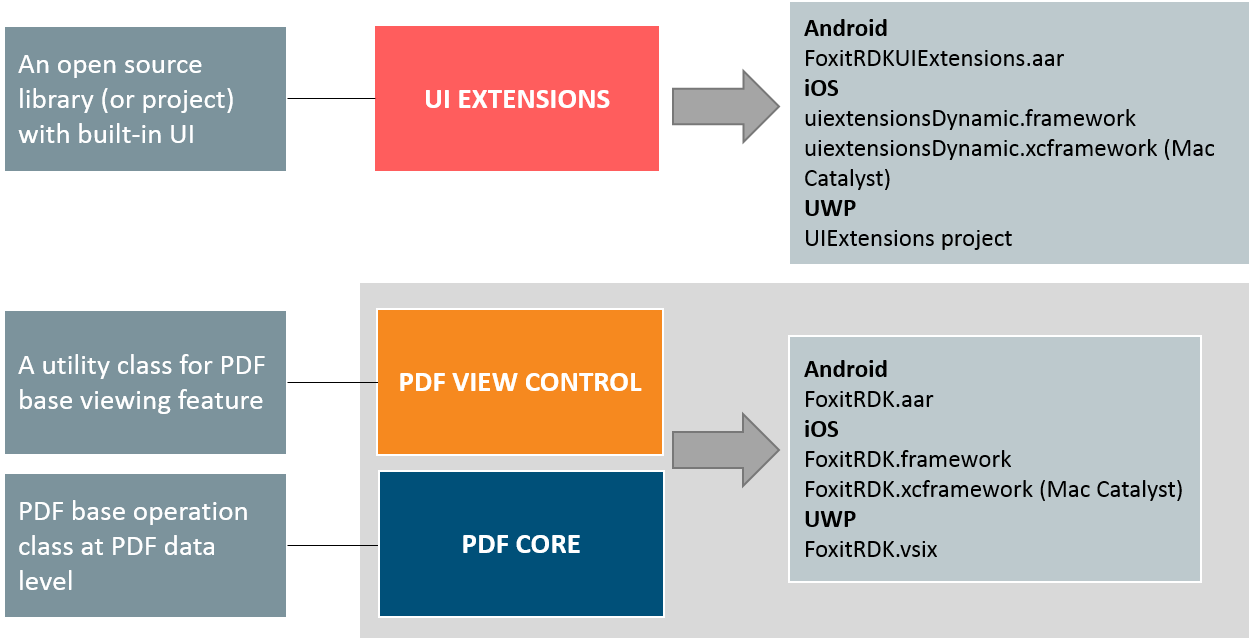
The three elements of Foxit PDF SDK for Android, iOS and UWP
PDF Core API
The PDF Core API is the heart of this SDK and is built on Foxit’s powerful underlying technology. It provides the functionality for basic PDF operation features, and is utilized by the PDF View Control and UI Extensions Component, which ensures the apps can achieve high performance and efficiency. The Core API can be used independently for document rendering, analysis, text extraction, text search, form filling, digital signatures, Pressure Sensitive Ink, certificate and password security, annotation creation and manipulation and much more.
PDF View Control
The PDF View Control is a utility class that provides the functionality for developers to interact with rendering PDF documents per their requirements. With Foxit’s renowned and widely used PDF rendering technology at its core, the View Control provides fast and high quality rendering, zooming, scrolling and page navigation features. The View Control derives from platform related viewer classes such as UIView on iOS and allows for extension to accommodate specific user needs.
UI Extensions Component
The UI Extensions Component is an open source library that provides a customizable user interface with built-in support for text selection, markup annotation, outline navigation, reading bookmarks, full-text searching, form filling, text reflow, attachment, digital/handwritten signature, reflow, document editing and password encryption. These features in the UI Extensions Component are implemented using the PDF Core API and PDF View Control. Developers can utilize these ready-to-use UI implementations to build a PDF viewer quickly with the added benefit of complete flexibility and control to customize the UI design as desired.
From version 4.0, Foxit PDF SDK for iOS made a big change and optimization for the UI Extensions Component. Now, it wraps the basic UI implementations to FSPDFReader class, such as panel controller, toolbar settings, and alert view, etc. Building a full-featured PDF Reader is getting simpler and easier. Furthermore, users can flexibly customize the features they want through a configuration file.
From version 5.0, Foxit PDF SDK for iOS removed the FSPDFReader class, and moved the wrapped APIs in FSPDFReader class to UI Extensions Component. In version 5.0, every element in the built-in UI can be configurable. More advanced APIs and more powerful configuration file are provided for developers to further customize the UI elements, such as showing or hiding a specific panel, top/bottom toolbar, the items in the top toolbar, and the items in the View setting bar and More Menu view.
UI Extensions Component Overview
The UI Extensions Component uses “module” mechanism which refines each feature into a module. All of the modules except LocalModule (used for file management) will be loaded by default if UI Extensions is added. Users can customize module through implementing Module interface class, and then call UIExtensionsManager#registerModule to register the custom module to current UIExtensions manager. When not in use, you can call UIExtensionsManager#unregisterModule to unregister it from current UIExtensions manager.
UIExtensionsManager contains the main-frame UI, such as top/bottom toolbar, and other UI components which are shared between each module. Meanwhile, through UIExtensionsManager, each feature module can also be loaded separately. And when loaded, the feature module will adapt and adjust the main-frame UI, as well as establish the connection of message event response. Each feature module may contain its module-specific UI components, and have its self-contained message event handling logic. UIExtensionsManager will also be responsible for distributing messages and events received from View Control component to each feature module. The following figure shows the detailed relationship between UIExtensionsManager and modules.
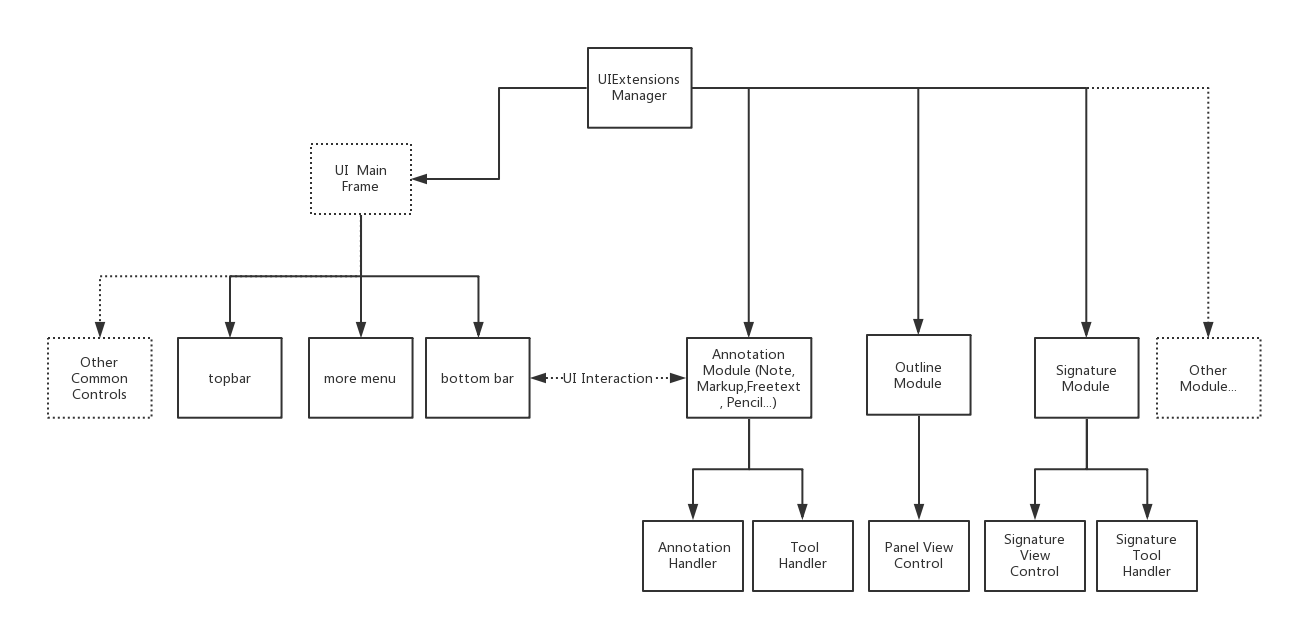
The relationship between UIExtensionsManager and modules
Tool handler and annotation handler will process the events from touch screen or gestures of PDFViewCtrl. When the touch screen and gestures occur, PDFViewCtrl will send the corresponding events to UIExtensionsManager:
If a tool handler exists currently, UIExtensionsManager will send the corresponding events to the current tool handler, and then event-handing process ends.
If an annotation is selected currently, UIExtensionsManager will send the corresponding events to the annotation handler corresponding to the currently selected annotation, and then event-handing process ends.
If currently no tool handler exists and no annotation is selected, UIExtensionsManager will send the corresponding events to selection tool handler. Text Selection tool is used for processing the related events for text selection. For example, select a piece of text, and add Highlight annotation. Blank Selection tool is used for processing the related events for blank space. For example, add a Note annotation on the blank space.
Note: Tool Handler and Annotation Handler will not respond the events at the same time. Tool Handler is primarily used for annotation creation (currently, the creation of link annotation is not supported), signature creation and text selection. Annotation Handler is mainly used for annotation editing and form filling. The following figure shows the event response flow chart between Tool Handler and Annotation Handler.
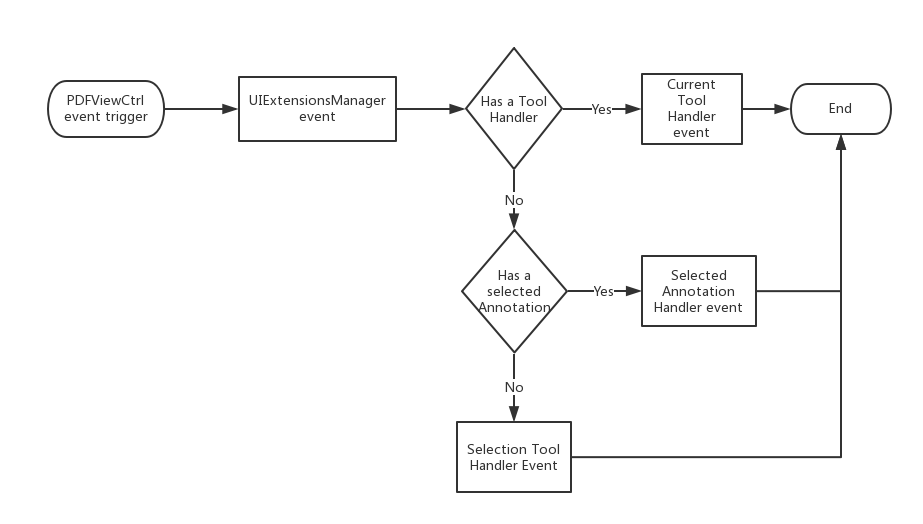
The event response flow chart between Tool Handler and Annotation Handler
Key Features of Foxit PDF SDK for iOS
Foxit PDF SDK for iOS has several main features which help app developers quickly implement the functions that they really need and reduce the development cost.
Note: From version 7.1, Foxit PDF SDK for iOS supports the new appearance of iOS 13 Dark Mode. All the built-in controls in the tools framework can adapt their appearance to match the current system appearance for a seamless experience.
| Features | Description |
| PDF Document | Open and close files, set and get metadata. |
| PDF Page | Parse, render, read, and edit PDF pages. |
| Render | Graphics engine created on a bitmap for platform graphics device. |
| Reflow | Rearrange page content. |
| Crop | Crop PDF pages for betting reading. |
| Text Select | Select text in a PDF document. |
| Text Search | Search text in a PDF document, and provide indexed Full-Text Search |
| Outline | Directly locate and link to point of interest within a document. |
| Reading Bookmark | Mark progress and interesting passages as users read. |
| Annotation | Create, edit and remove annotations. |
| Layers | Add, edit, and remove optional content groups. |
| Attachments | Add, edit, and remove document level attachments. |
| Form | Fill form with JavaScript support, export and import form data by XFDF/FDF/XML file. Support to create TextField, CheckBox, RadioButton, ComboBox, ListBox, and Signature Field. |
| XFA | Support static and dynamic XFA. |
| Signature | Sign a PDF document, verify a signature, add or delete a signature field. Add and verify third-party digital signature. Support Long term validation of signatures (LTV). |
| Fill | Fill flat forms (i.e. non-interactive forms) with text and symbols. |
| Security | Protect PDFs with password or certificate. |
| Pan and Zoom | Adjust the magnification and position of the view area to match the area in an adjustable rectangle in the Pan & Zoom window’s thumbnail view of the page. |
| Print PDF document. | |
| RMS | Support Microsoft RMS decryption with the standard IRMv1 and IRMv2. |
| Comparison | Compare two PDF documents, and mark the differences between them. |
| Scanning | Scan and convert paper documents to PDFs. |
| Speak | Support to read out the text of PDF file. |
| Split Screen | Support split screen. |
| Right–to–Left | Support Right-to-Left. |
| Out of Memory | Recover from an OOM condition |
Note Outline is the technical term used in the PDF specification for what is commonly known as bookmarks in traditional desktop PDF viewers. Reading bookmarks are commonly used on mobile and tablet PDF viewers to mark progress and interesting passages as users read but are not technically outline and are stored at app level rather than within the PDF itself.
Support robust PDF applications with Foxit PDF SDK for iOS
Development of robust PDF applications is challenging on mobile platforms which has limited memory. When memory allocation fails, applications may crash or exit unexpectedly. To deal with this issue, Foxit PDF SDK for iOS provides an out-of-memory (OOM) mechanism to support applications.
OOM is an evolved feature in Foxit PDF SDK for iOS because of its complexity. The key of OOM mechanism is that Foxit PDF SDK for iOS will monitor the usage of memory and take recovery operations automatically once OOM is detected. During the recovery process, Foxit PDF SDK for iOS reloads the document and page automatically and restores the status to the original before OOM. It means the current reading page and location, as well as page view mode (single or continuous page) can be recovered. However, the data generated from editing will be lost.
Foxit PDF SDK for iOS provides a property “shouldRecover” in FSPDFViewCtrl class. By default, the value of “shouldRecover” is “YES”. If you do not want to enable the auto-recovery when OOM is detected, you can set “shouldRecover” to “No” as follows:
self.pdfViewControl = [[FSPDFViewCtrl alloc] initWithFrame:[[UIScreen mainScreen] bounds]];
self.pdfViewControl.shouldRecover = NO;
At that time, the application will throw an exception, and may crash or exit unexpectedly.
Evaluation
Foxit PDF SDK allows users to download trial version to evaluate SDK. The trial version has no difference from the standard licensed version except for the free 10-day trial limitation and the trial watermarks in the generated pages. After the evaluation period expires, customers should contact the Foxit sales team and purchase licenses to continue using Foxit PDF SDK.
License
Developers should purchase licenses to use Foxit PDF SDK in their solutions. Licenses grant developers permission to release their apps which utilize Foxit PDF SDK. However, users are prohibited to distribute any documents, sample code, or source code in the released package of Foxit PDF SDK to any third party without written permission from Foxit Software Incorporated.
About this Guide
This guide is intended for the developers who need to integrate Foxit PDF SDK for iOS into their own apps. It aims at introducing the following sections:
Section 1: gives an introduction of Foxit PDF SDK, especially for iOS platform SDK.
Section 2: illustrates the package structure and running demos.
Section 3: describes how to quickly create a full-featured PDF Reader.
Section 4: describes how to quickly create a full-featured PDF Reader using Mac Catalyst.
Section 5: introduces how to customize the user interface.
Section 6: shows how to use Foxit PDF SDK Core API.
Section 7: shows how to create a custom tool.
Section 8: shows how to implement Foxit PDF SDK using Cordova
Section 9: shows how to implement Foxit PDF SDK using React Native
Section 10: shows how to implement Foxit PDF SDK using Xamarin
Section 11: lists some frequently asked questions.
Section 12: provides support information.
Getting Started
It is very easy to setup Foxit PDF SDK for iOS and see it in action! It takes just a few minutes and we will show you how to use it on the iOS or macOS platforms. The following sections introduce the structure of the installation package and how to run a demo.
Requirements
Note: From version 7.5.1, Foxit PDF SDK for iOS only supports 64-bit devices. It is because that in iOS 11 and later, all apps use the 64-bit architecture, please see the Apple developer guide.
The package without Mac Catalyst:
iOS 11.0 or higher
Xcode 9.0 or newer
Note: iOS 13 or higher requires Xcode version 11 or higher.
The package with Mac Catalyst:
macOS 10.15 or higher
Xcode 11 or higher
What is in the Package
Foxit PDF SDK for iOS provides two packages as follows:
foxitpdfsdk_9_0_ios.zip: only support building apps on an iPhone or iPad.
foxitpdfsdk_9_0_ios_catalyst.zip: support building apps on an iPhone, iPad or a Mac.
Note: If you want to build apps on macOS, you can choose the foxitpdfsdk_9_0_ios_catalyst.zip package.
The package without Mac Catalyst
Download the “foxitpdfsdk_9_0_ios.zip” package, and extract it to a new directory like “foxitpdfsdk_9_0_ios” as shown in Figure 2-1. The package contains:
| docs: | A folder containing API references, developer guide, and upgrade warnings. |
| icc_profile | The default icc profile files used for output preview feature |
| libs: | A folder containing license files, SDK framework, UI Extensions Component and source code. |
| samples: | A folder containing iOS sample projects. |
| getting_started_ios.pdf: | A quick guide for Foxit PDF SDK for iOS. |
| legal.txt: | Legal and copyright information. |
| release_notes.txt: | Release information. |

Figure 2-1
In the “libs” folder as shown in Figure 2, there are items that make up the core components of Foxit PDF SDK for iOS, and a configuration file for cocoaPods tool and a script file for stripping the arm architectures.
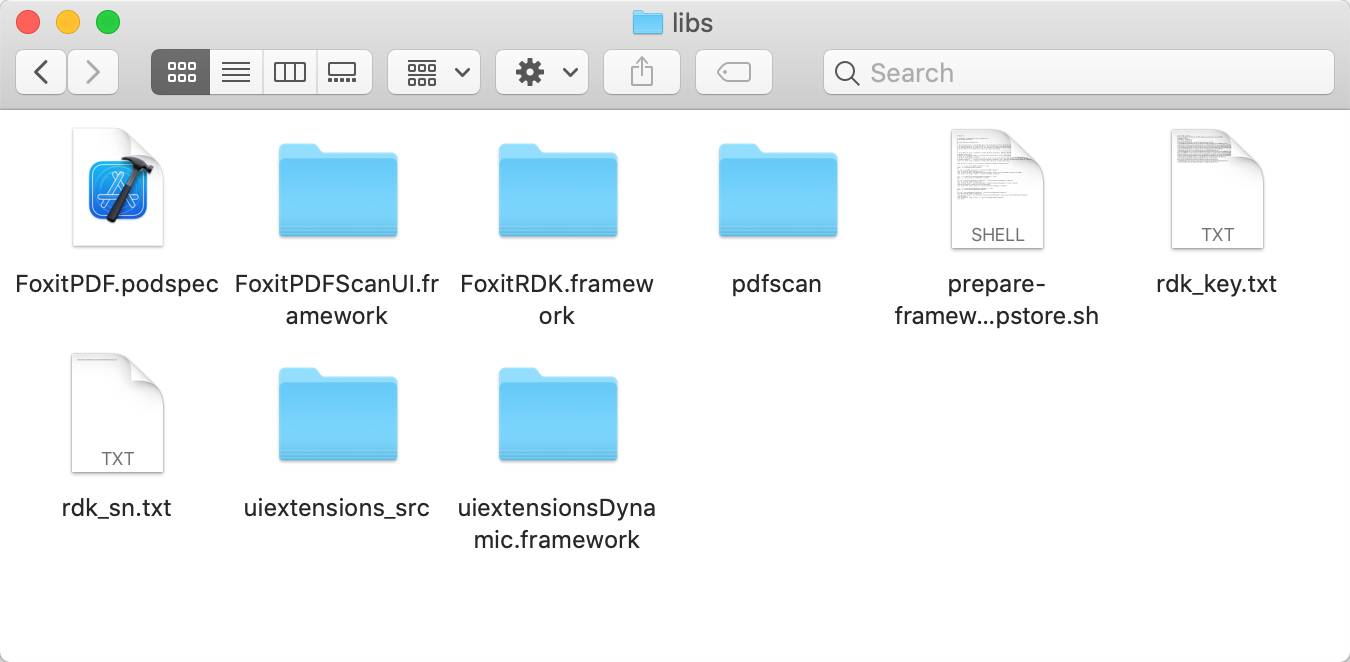
Figure 2-2
FoxitRDK.framework – The framework that includes the Foxit PDF SDK dynamic library and associated header files.
uiextensionsDynamic.framework – The framework that includes UIExtensions dynamic library, associated header files, and the resource files that are needed for the default built-in UI implementations.
FoxitPDFScanUI.framework – The framework that includes Foxit PDF SDK for scanning dynamic library, associated header files, and the resource files that are needed for the default built-in UI implementations of scanning feature.
FoxitPDF.podspec – A configuration file for cocoaPods tool which is used to manage the third-party libraries. It has been used in section “Implement Foxit PDF SDK for iOS using React Native”.
prepare-framework-to-publish-to-appstore.sh – A script file used to strip the arm architectures from Foxit SDK Framwork. This is because Foxit SDK Framwork includes arm64, armv7, i386, and x86_64 architectures, but the i386, and x86_64 architectures are not allowed to be uploaded to Apple App Store.
pdfscan project – It is an open source library that contains the UI implementations for scanning feature, which can help developers rapidly integrate scanning feature into their iOS app, or customize the UI for scanning as desired.
uiextensions project – found in the “libs/uiextensions_src” folder. It is an open source library that contains some ready-to-use UI module implementations and the basic UI design for app, which can help developers rapidly embed a fully functional PDF reader into their iOS app. Of course, developers are not forced to use the default UI, they can freely customize and design the UI for their specific apps through the “uiextensions” project.
Note: For iOS 13 or higher, you should use Xcode 11 or higher to build the “uiextensions” project.
The package with Mac Catalyst
Download the “foxitpdfsdk_9_0_ios_catalyst.zip” package, and extract it to a new directory. The contents in this package are similar to the “foxitpdfsdk_9_0_ios.zip” package. You can refer to the previous section “The package without Mac Catalyst” for more information.
In the “libs” folder as shown in Figure 2, the difference is that the FoxitRDK.xcframework and uiextensionsDynamic.xcframework can support to build a Mac version of your iPad app using Mac Catalyst.
Note: Currently, the RMS and Scanning features are not supported by the Mac version app.
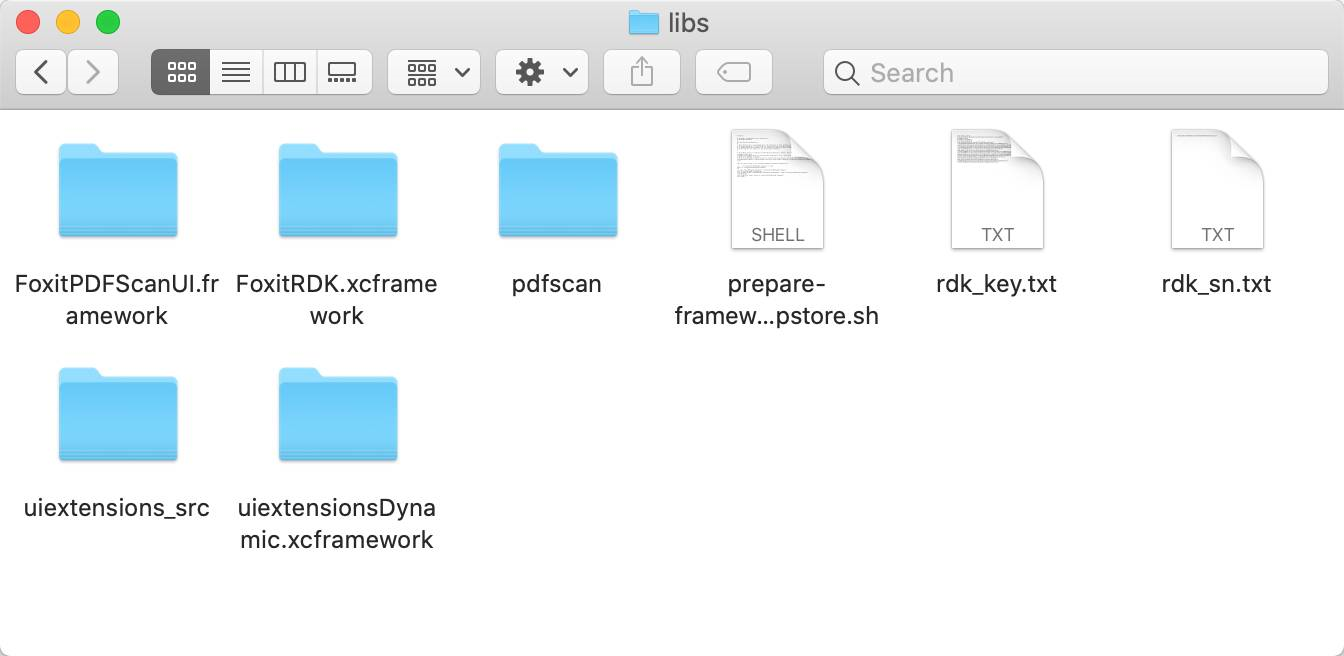
Figure 2-3
How to run a demo
Download and install Xcode IDE (https://developer.apple.com/download/).
Note: In this guide, we do not cover the installation of Xcode. You can refer to Apple’s developer site if you haven’t installed it already.
Foxit PDF SDK for iOS provides three useful demos (Function demo, Viewer Control demo, and Complete PDF viewer demo) in both Objective-C and Swift programming languages for developers to learn how to call the SDK. The Swift demos are located in the “swift” folder. (See Figure 2)
Note: The complete PDF viewer demo in Swift provides tabs reading mode to support viewing multiple PDF documents.

Figure 2-4
Foxit PDF SDK for iOS (Mac Catalyst) provides a Complete PDF viewer demo in Objective-C for developers to learn how to call the SDK. The demo is located in the “samples” folder. To run this demo, please make sure that your macOS version is 10.15 or higher and Xcode version is 11 or higher.
Function demo
The function demo is provided with Objective-C and Swift programming languages, which is used to show how to use Foxit PDF SDK for iOS to realize some specific features related to PDF with PDF core API. This demo includes the following features:
pdf2txt: extract text from a PDF document to a TXT file.
outline: edit outline (aka bookmark) appearances and titles.
annotation: add annotations and export annotations to a JSON file.
docinfo: export document information of a PDF to a TXT file.
render: render a specified page to Bitmap.
signature: add a signature to PDF, sign PDF and verify the signature.
image2pdf: convert images to PDF files.
watermark: add text, image and PDF-page watermarks to PDF files.
search: search PDF files.
graphics_objects: create a PDF document with graphics objects.
To run it in Xcode, follow the steps below:
Double-click function_demo.xcodeproj found in the “samples/function_demo” folder to open the demo in Xcode. (For Swift, double-click function_demo_swift.xcodeproj found in the “samples/swift/function_demo_swift” folder)
Note: There is another way to open the demo in Xocde: double-click samples_xcworkspace found in the “samples” folder. It is a workspace including the three demos.
Click on “Product -> Run” to run the demo on an iOS device or simulator. In this guide, an iPhone 11 Simulator will be used as an example. After building the demo successfully, the features are listed like the Figure 2.

Figure 2-5
Click the feature buttons in the above picture to perform the corresponding actions. For example, click “pdf2txt”, and then a message box will be popped up as shown in Figure 2. It shows where the text file was saved to. Just run the demo and try the features.
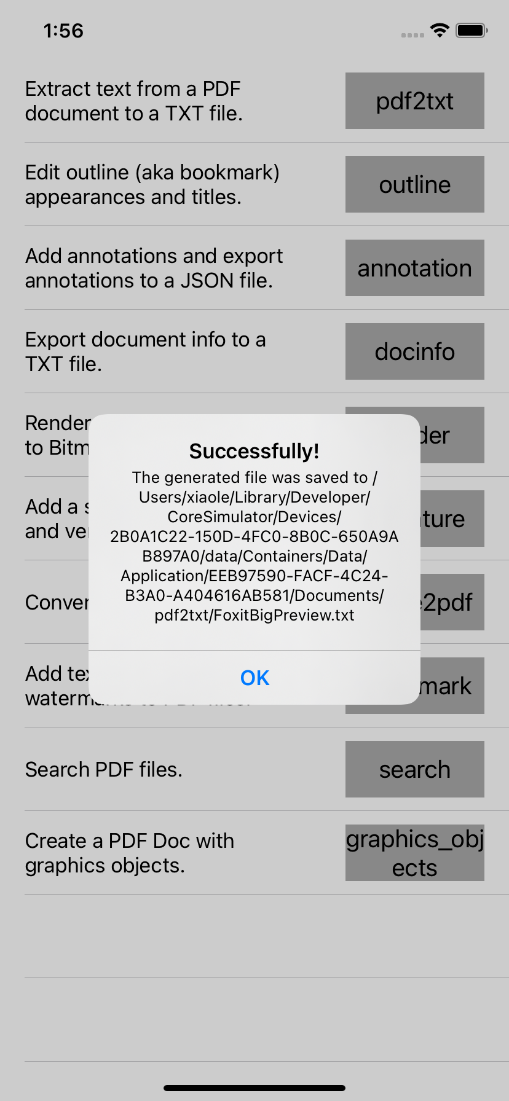
Figure 2-6
Viewer control demo
The viewer control demo is provided with Objective-C and Swift programming languages, which is used to demonstrate how to implement the features related to the View Control feature level, such as performing annotations (note, typewriter, highlight, underline, strikeout, squiggly, etc.), outline, reading bookmarks and text search. The logical structure of the code is quite clear and simple so that developers can quickly find the detailed implementation of features which are used widely in PDF apps, such as a PDF viewer. With this demo, developers can take a closer look at the APIs provided in Foxit PDF SDK.
To run the demo in Xcode, please refer to the setup steps outlined in the Function demo.
Figure 2 shows what the demo looks like after it was built successfully. Here, an iPhone 11 Simulator will be used as an example to run the demo.
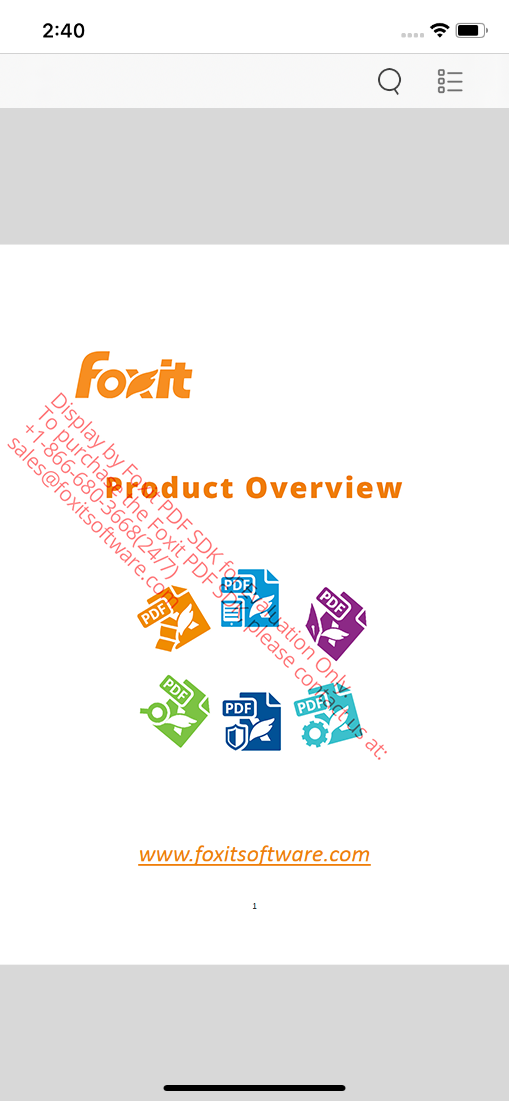
Figure 2-7

This demo provides the features like text search and listing reading bookmarks, outline, annotations and digital signatures. For example, click , select the second tab (outline), then the outline of this document will be displayed as shown in Figure 2.
Note Outline is the technical term used in the PDF specification for what is commonly known as bookmarks in traditional desktop PDF viewers. Reading bookmarks are commonly used on mobile and tablet PDF viewers to mark progress and interesting passages as users read but are not technically outlines and are stored at app level rather than within the PDF itself.
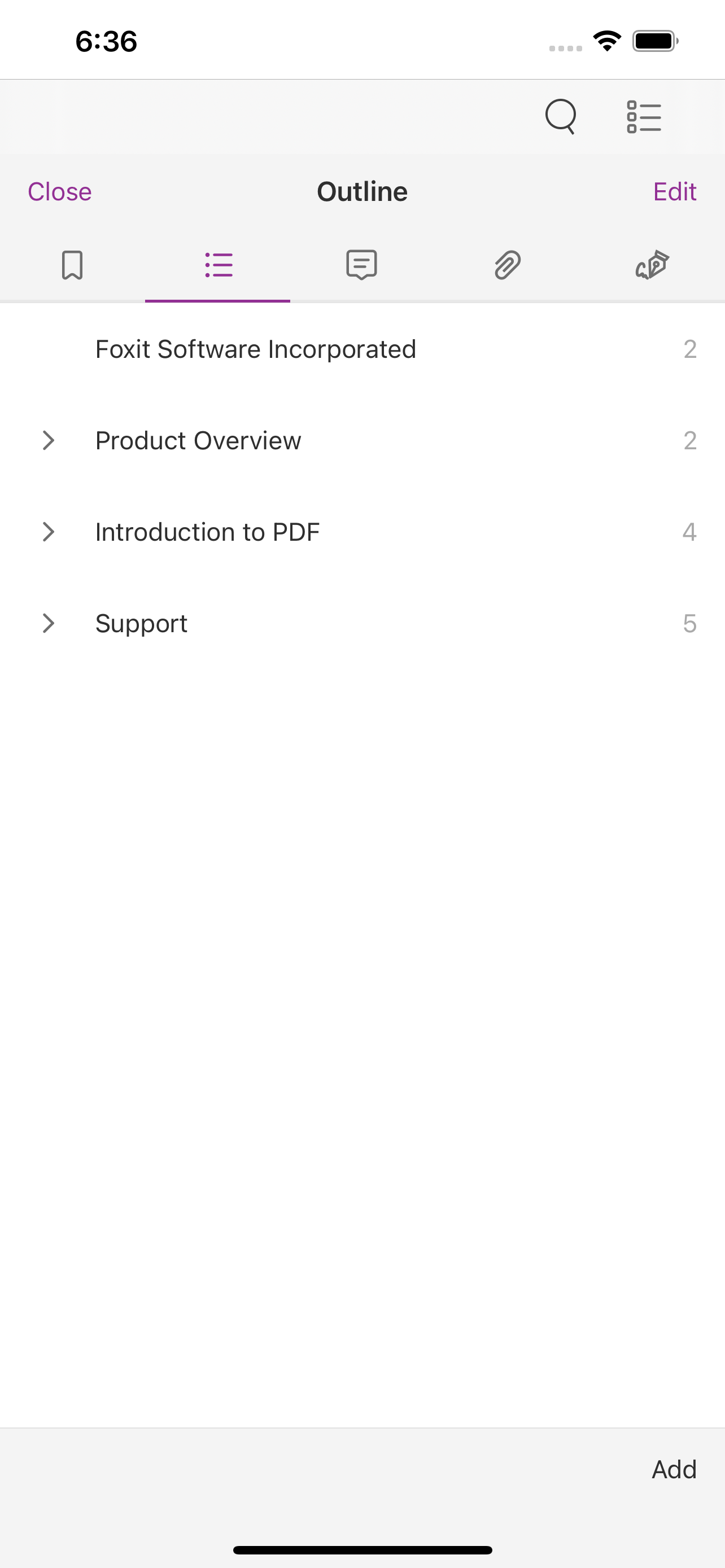
Figure 2-8
Complete PDF viewer demo
Complete PDF Viewer demo without Mac Catalyst
The complete PDF viewer demo demonstrates how to use Foxit PDF SDK for iOS to realize a completely full-featured PDF viewer which is almost ready-to-use as a real world mobile PDF reader. This demo utilizes all of the features and built-in UI implementations which are provided in Foxit PDF SDK for iOS.
Note: The complete PDF viewer demo in Swift provides tabs reading mode to support viewing multiple PDF documents.
To run the demo in Xcode, please refer to the setup steps outlined in the Function demo.

Here, we will build and run the Swift demo in an iPhone 11 Simulator. After building the demo successfully, on the start screen, it lists the “Sample.pdf” and “complete_pdf_viewer_guide_ios.pdf” documents. If you want to view multiple PDF documents, click to switch to the tabs reading mode (see Figure 2.).
Note If you want to use some other PDF files to test this demo, you need to put them onto the “Document” folder of the device.
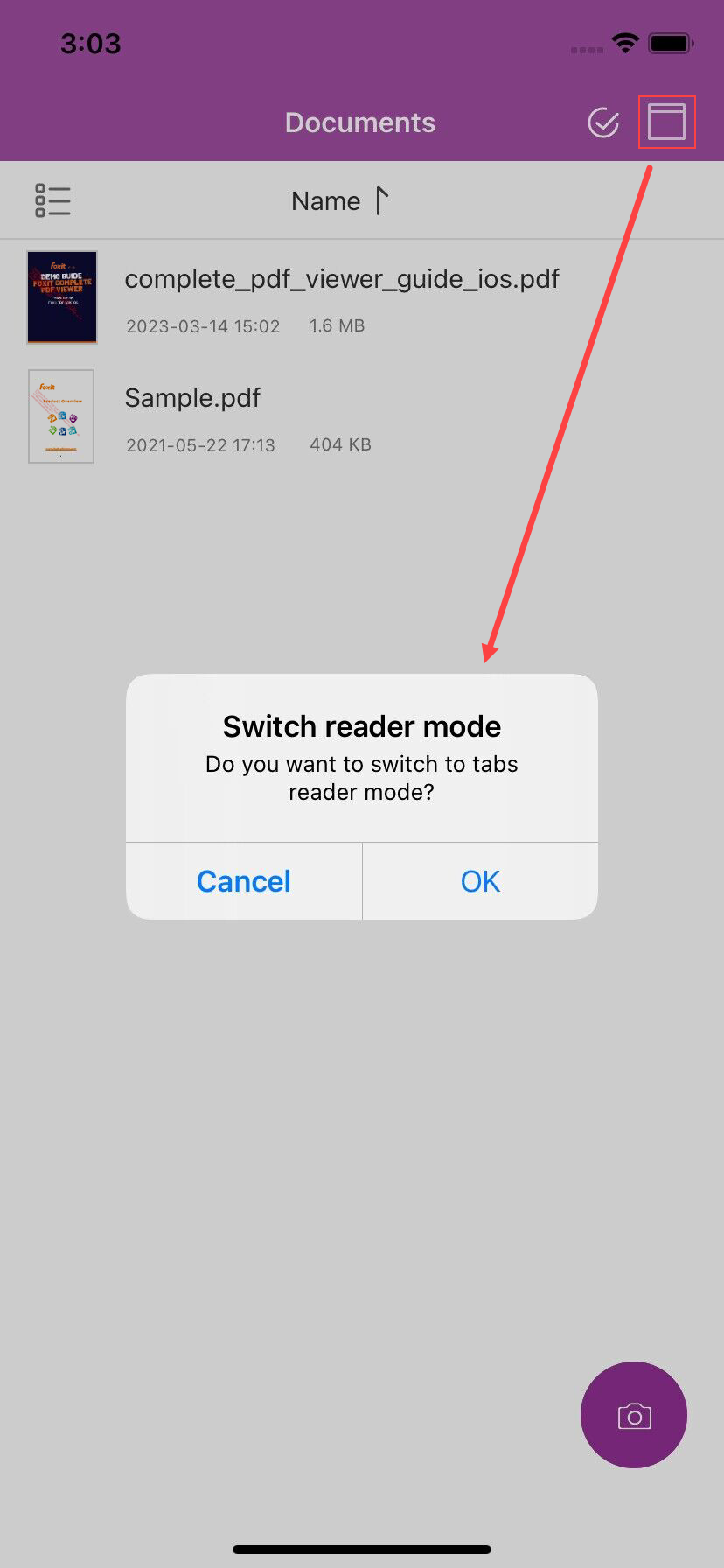
Figure 2-9

Click OK to switch to the tabs reading mode. Select the “complete_pdf_viewer_guide_ios.pdf” document, and then click the Back button , and select the “Sample.pdf”, then it will be displayed as shown in Figure 2. Now, you can browse the two PDF documents by switching the tabs.

Figure 2-10
This demo realizes a completely full-featured PDF viewer, please feel free to run it and try it.

For example, it provides the page thumbnail feature. You can click the thumbnail menu at the bottom toolbar, and then the thumbnail of the document will be displayed as shown in Figure 2.

Figure 2-11
Complete PDF Viewer demo with Mac Catalyst
To run the “complete_pdf_viewer” demo in Xcode, please follow the steps below:
Double-click complete_pdf_viewer.xcodeproj found in the “samples/complete_pdf_viewer” folder to open the demo in Xcode.
Click on “Product -> Run” to run the demo on an iOS device/simulator or on your Mac. Here, select “My Mac” as the run destination for example. After building the demo successfully, on the start screen, it lists the “Sample.pdf” and “complete_pdf_viewer_guide_ios.pdf” documents as shown in Figure 2.
The features provided in this demo is similar to “Complete PDF Viewer demo without Mac Catalyst”.
Note: You may need to register your Mac using a development provisioning profile which allows your app to launch on devices and use certain app services during development.

Figure 2-12
Rapidly building a full-featured PDF Reader
Foxit PDF SDK for iOS wrapped all of the UI implementations including the basic UI for app and ready-to-use UI feature modules to UI Extensions Component, so that developers can easily and rapidly build a full-featured PDF Reader with just a few lines of code. This section will help you to quickly get started with using Foxit PDF SDK for iOS to make a full-featured PDF Reader app (only can be deployed to iPhone or iPad devices) in Objective-C and Swift with step-by-step instructions provided.
Make an iOS app in Objective-C with Foxit PDF SDK for iOS
This section will help you to quickly make an iOS app in Objective-C using Foxit PDF SDK for iOS. It includes the following steps:
Create a new iOS project in Objective-C
Integrate Foxit PDF SDK for iOS into your apps
Display a PDF document using FSPDFViewCtrl
Build a full-featured PDF Reader with UI Extensions Component
Add the scanning feature based on the full-featured PDF Reader
Create a new iOS project in Objective-C
In this guide, we use Xcode 12.0.1 to create a new iOS project.
Fire up Xcode, choose File -> New -> Project…, and then select iOS -> Single View App as shown in Figure 3. Click Next.
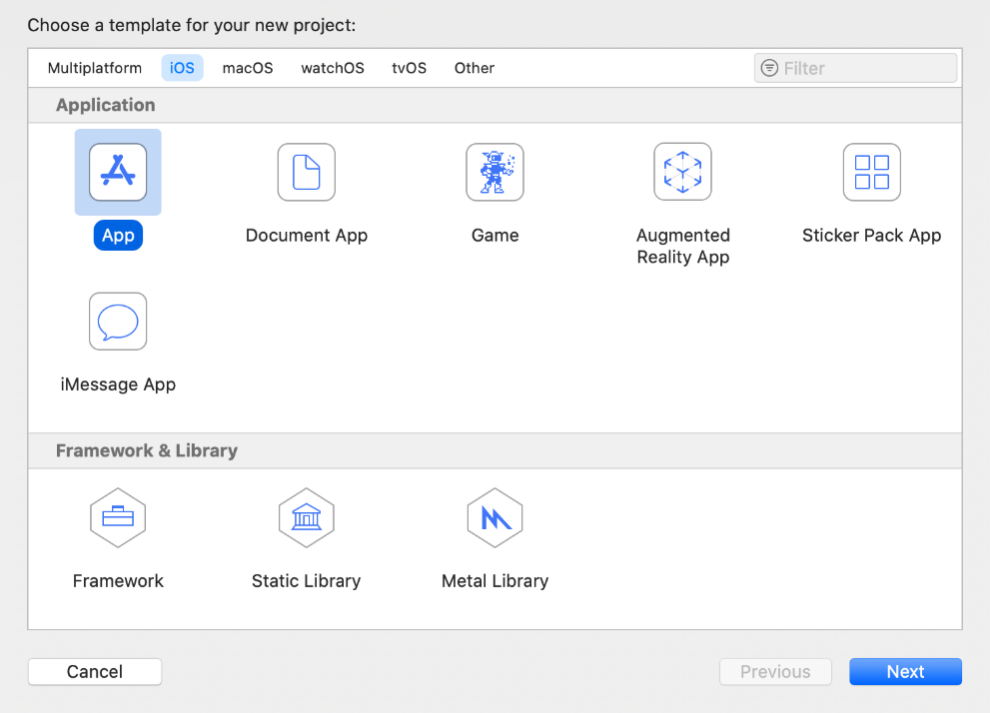
Figure 3-1
Choose the options for your new project as shown in Figure 3. Please make sure to choose Objective-C as the programming language. For simplicity, we don’t check the Unit Tests and UI Tests which are used for automated testing. Then, Click Next.
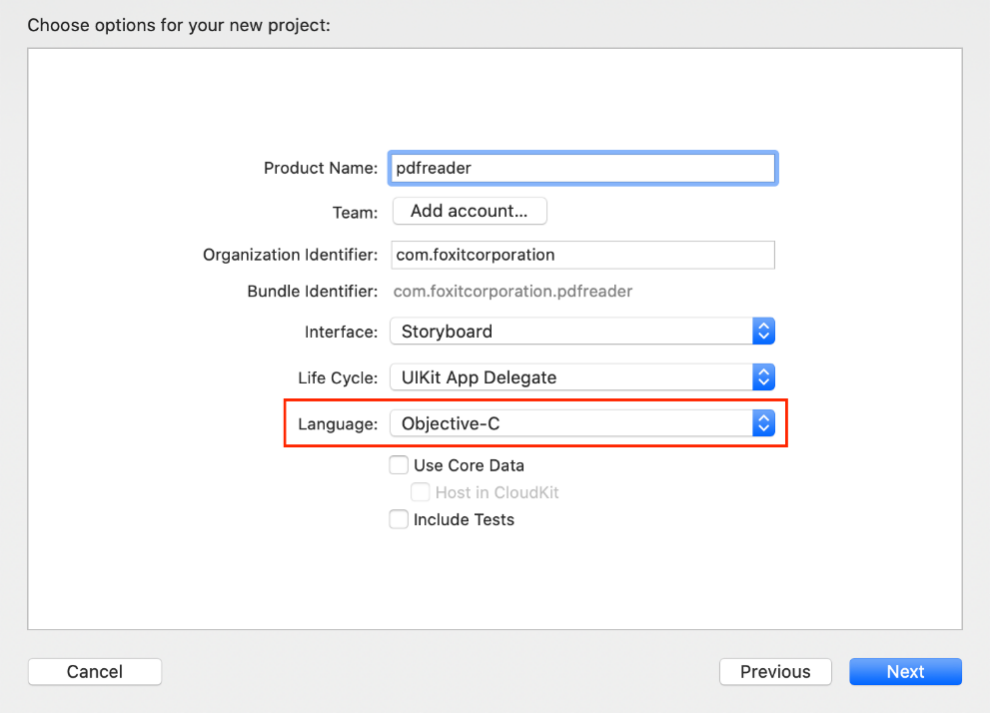
Figure 3-2
Place the project to the location as desired. The option “Source control” is not actually important for building your first PDF app, so let’s not check the Git repository. Here, we place the project to desktop as shown in Figure 3. Then, click Create.
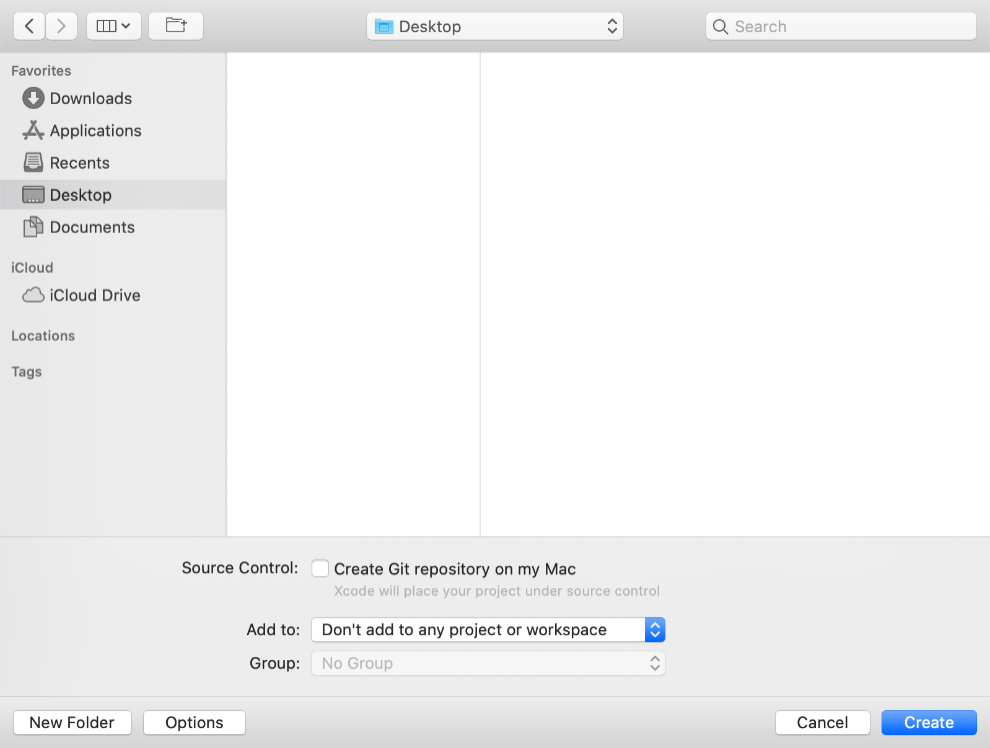
Figure 3-3
Integrate Foxit PDF SDK for iOS into your apps
Note: In this section, we will use the default built-in UI implementations to develop the app, for simplicity and convenience (use the UI Extensions Component directly, and don’t need to build the source code project), we only need to add the following files to the pdfreader project.
FoxitRDK.framework – The framework that includes the Foxit PDF SDK for iOS dynamic library and associated header files.
uiextensionsDynamic.framework – The framework that includes UI Extensions dynamic library, associated header files, and the resource files that are needed for the default built-in UI implementations.
(optional) FoxitPDFScanUI.framework – The framework that includes Foxit PDF SDK for scanning dynamic library, associated header files, and the resource files that are needed for the default built-in UI implementations of scanning feature.
Tip:
The UI Extensions Component (uiextensionsDynamic.framework) is not required for the following two sections “Initialize Foxit PDF SDK for iOS” and “Display a PDF document using PDFViewCtrl“, so you can just add FoxitRDK.framework to the project at first. Then, add uiextensionsDynamic.framework when you need to use the UI Extensions Component, such like the project described in the section “Build a full-featured PDF Reader with UI Extensions Component“.
The FoxitPDFScanUI.framework is required by the scan module, which will be needed for the section “Add the scanning feature based on the full-featured PDF Reader“.
To add the above three dynamic framework files into the pdfreader project, please follows the steps below:
Right-click the “pdfreader” project, select Add Files to “pdfreader“… as shown in Figure 3.
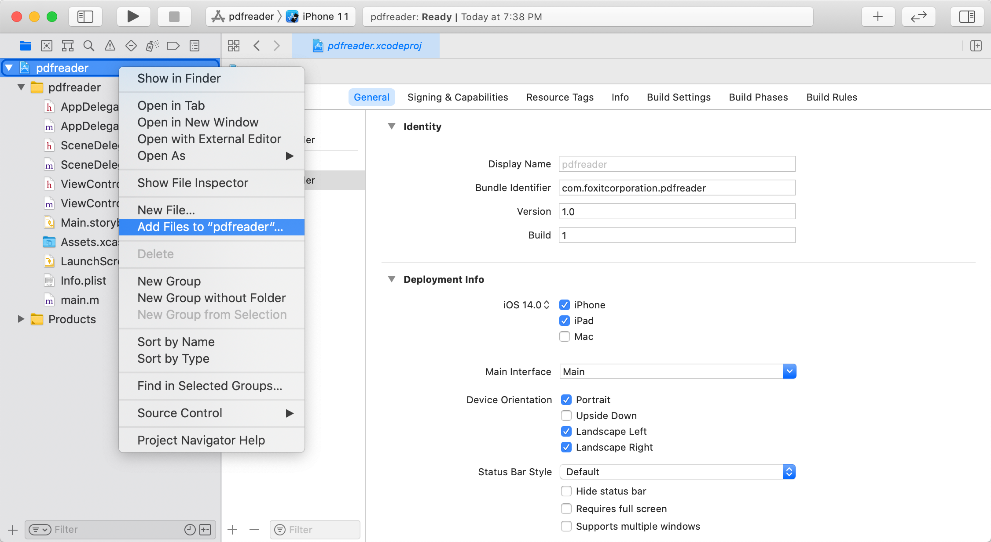
Figure 3-4
Find and choose “FoxitRDK.framework“ in the “libs” folder of the download package, and then click Add as shown in Figure 3.
Note: Make sure to check the “Copy items if needed” option.
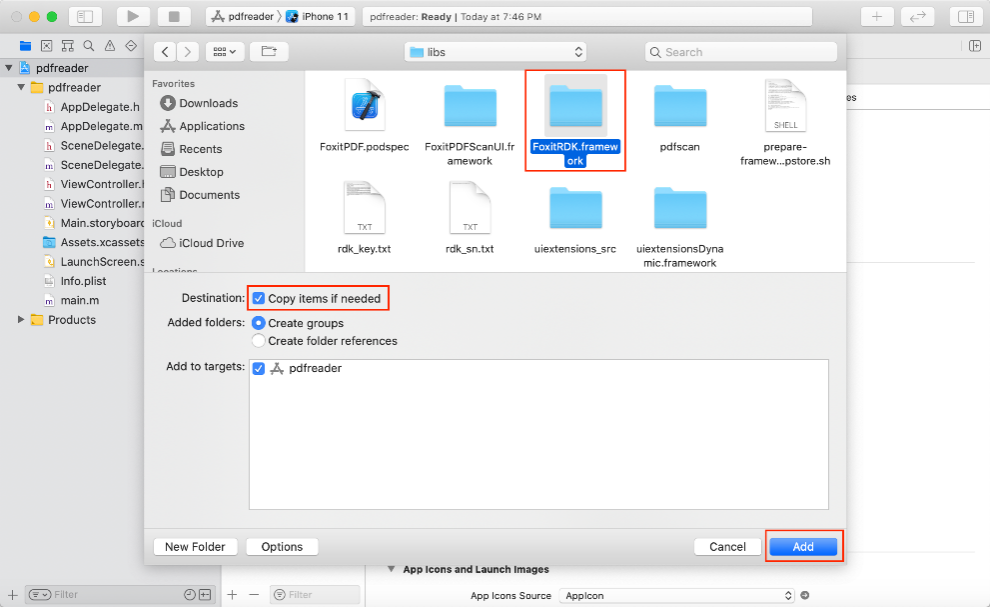
Figure 3-5
Repeat the steps like a) and b) to add “uiextensionsDynamic.framework” and “FoxitPDFScanUI.framework“. Then, the pdfreader project will look like the Figure 3.
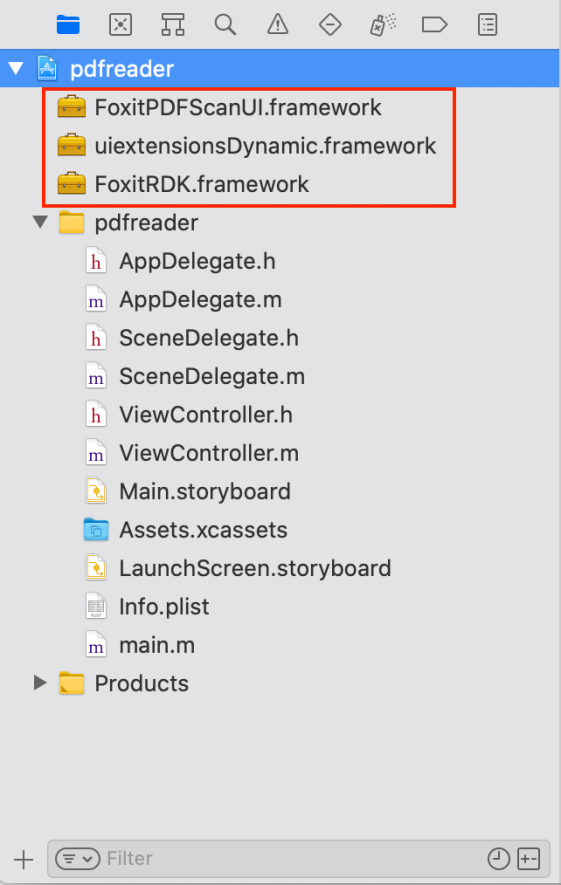
Figure 3-6
Embed the dynamic frameworks. Left-click the project, find Frameworks, Libraries, and Embedded Content in the General tab, and then choose “Embed & Sign” as shown in Figure 3.
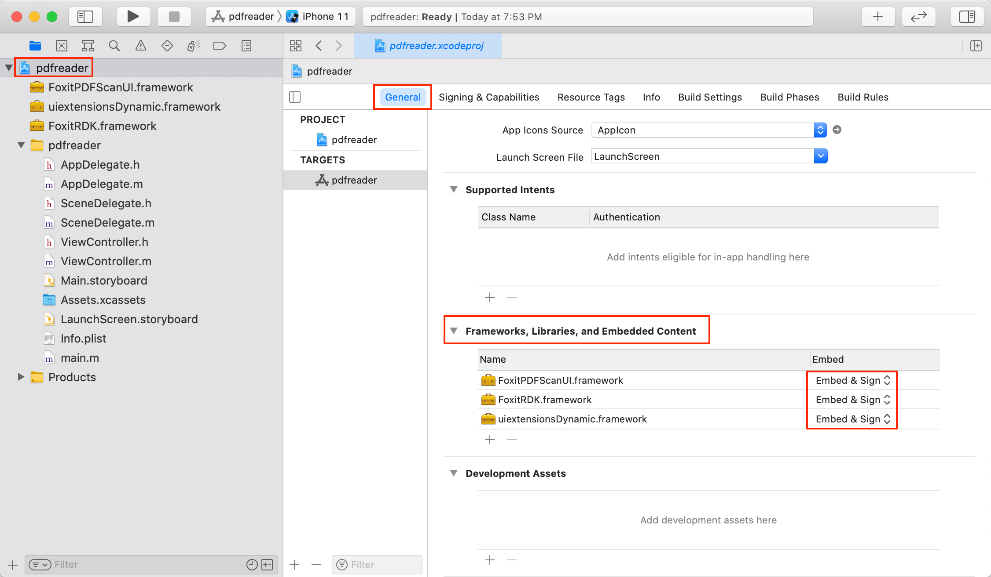
Figure 3-7
Now, we have added “FoxitRDK.framework“, “uiextensionsDynamic.framework” and “FoxitPDFScanUI.framework” to the pdfreader project successfully.
Initialize Foxit PDF SDK for iOS
It is necessary for apps to initialize and unlock Foxit PDF SDK for iOS using a license before calling any APIs. The function + [FSLibrary initialize:key:] is provided to initialize Foxit PDF SDK. The trial license files can be found in the “libs” folder of the download package. After the evaluation period expires, you should purchase an official license to continue using it. Finish the initialization in the didFinishLaunchingWithOptions method within the AppDelegate.m file.
#import “AppDelegate.h”
#import <FoxitRDK/FSPDFObjC.h>
@interface AppDelegate ()
@end
@implementation AppDelegate
– (BOOL)application:(UIApplication *)application didFinishLaunchingWithOptions:(NSDictionary *)launchOptions {
// The value of “sn” can be found in the “rdk_sn.txt”.
// The value of “key” can be found in the “rdk_key.txt”.
NSString* sn = @” “;
NSString* key = @” “;
FSErrorCode eRet = [FSLibrary initialize:sn key:key];
if (FSErrSuccess != eRet) {
return NO;
}
return YES;
}
@end
Note The parameter “sn” can be found in the “rdk_sn.txt” (the string after “SN=”) and the “key” can be found in the “rdk_key.txt” (the string after “Sign=”).
Display a PDF document using FSPDFViewCtrl
So far, we have added Foxit PDF SDK for iOS frameworks to the pdfreader project, and finished the initialization of the Foxit PDF SDK. Now, let’s start displaying a PDF document using FSPDFViewCtrl with just a few lines of code.
Note: The UI Extensions Component is not required if you only need to display a PDF document.
First of all, add a PDF file to the project which will be used as the test file. For example, we use “Sample.pdf” found in the “samples\test_files” folder of the download package. Right-click the pdfreader project, and select Add Files to “pdfreader“… to add this file. After adding, you can see the PDF in the Xcode’s Copy Bundle Resources as shown in Figure 3.
Note: You can add the PDF to Copy Bundle Resources directly. Just left-click the pdfreader project, find Copy Bundle Resources in the Build Phases tab, press on the + button, and choose the file to add. You can refer to any PDF file, just add it to the Xcode’s Copy Bundle Resources.
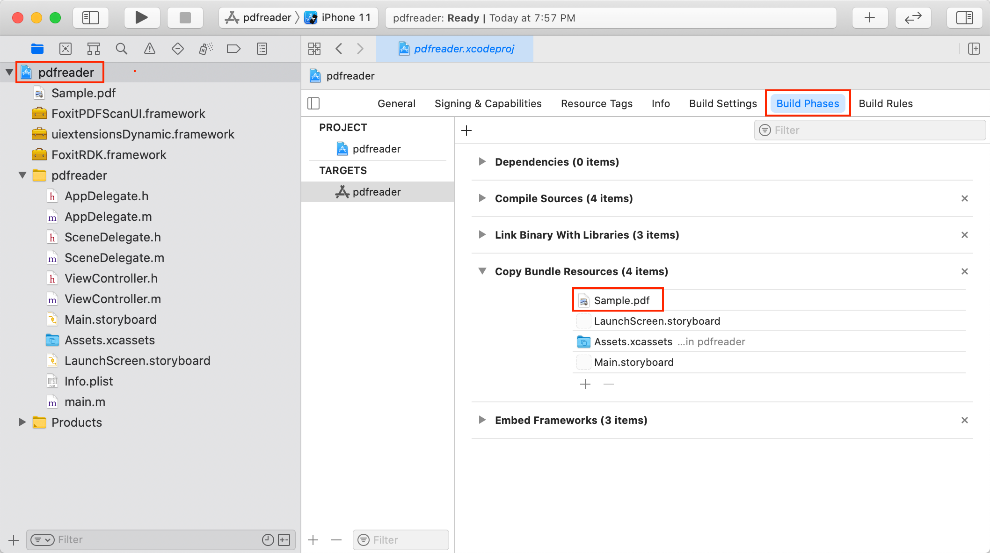
Figure 3-8
Then, add the following code to ViewController.m to display a PDF document. It’s really easy to present a PDF on screen. All you need is to get a PDF file, instantiate a FSPDFViewCtrl object and call – [FSPDFViewCtrl openDoc:password:completion:] function to open and display the PDF.
Update ViewController.m as follows:
#import “ViewController.h”
#import <FoxitRDK/FSPDFViewControl.h>
@interface ViewController ()
@end
@implementation ViewController
– (void)viewDidLoad {
[super viewDidLoad];
// Get the path of a PDF.
NSString* pdfPath = [[NSBundle mainBundle] pathForResource:@”Sample” ofType:@”pdf”];
// Initialize a FSPDFViewCtrl object with the size of the entire screen.
FSPDFViewCtrl* pdfViewCtrl;
pdfViewCtrl = [[FSPDFViewCtrl alloc] initWithFrame: [self.view bounds]];
// Open an unencrypted PDF document.
[pdfViewCtrl openDoc:pdfPath password:nil completion:nil];
// Add the pdfViewCtrl to the root view.
[self.view addSubview:pdfViewCtrl];
}
– (void)didReceiveMemoryWarning {
[super didReceiveMemoryWarning];
// Dispose of any resources that can be recreated.
}
@end
Fantastic! We have now finished building a simple iOS app which uses Foxit PDF SDK to display a PDF document with just a few lines of code. The next step is to run the project on a device or simulator.
In this guide, we build and run the project on an iPhone 11 Simulator, and you will see that the “Sample.pdf” document is displayed as shown in Figure 3. Now, this sample app has some basic PDF features, such as zooming in/out and page turning. Just have a try!

Figure 3-9
Build a full-featured PDF Reader with UI Extensions Component
Foxit PDF SDK for iOS comes with built-in UI design including the basic UI for app and the feature modules UI, which are implemented using Foxit PDF SDK and are shipped in the UI Extensions Component. Hence, building a full-featured PDF Reader is getting simpler and easier. All you need to do is to instantiate a UIExtensionsManager object, and then set it to FSPDFViewCtrl.
Instantiate a UIExtensionsManager object and set it to FSPDFViewCtrl
In the “ViewController.m” file, you only need to add the following code:
#import <uiextensionsDynamic/uiextensionsDynamic.h>
UIExtensionsManager* extensionsManager;
…
extensionsManager = [[UIExtensionsManager alloc] initWithPDFViewControl:pdfViewCtrl];
pdfViewCtrl.extensionsManager = extensionsManager;
Add permissions to access camera, microphone, photo library and bluetooth
In order to access the camera, microphone, photo library and bluetooth in iOS 9.0 or higher, you need to do the following configuration in the “Info.plist“.
<key>NSCameraUsageDescription</key>
<string>The App needs to access your Camera, please allow</string>
<key>NSMicrophoneUsageDescription</key>
<string>The App needs to access your Microphone, please allow</string>
<key>NSPhotoLibraryAddUsageDescription</key>
<string>The App needs to add pictures into your Photo Library, please allow</string>
<key>NSPhotoLibraryUsageDescription</key>
<string>The App needs to access your Photo Library, please allow</string>
<key>NSBluetoothAlwaysUsageDescription</key>
<string>RDK only lets you connect to apple pencil or keyboard.</string>
<key>NSBluetoothPeripheralUsageDescription</key>
<string>RDK only lets you connect to apple pencil or keyboard.</string>
The whole update of ViewController.m is as follows:
#import “ViewController.h”
#import <FoxitRDK/FSPDFViewControl.h>
#import <uiextensionsDynamic/uiextensionsDynamic.h>
@interface ViewController ()
@end
@implementation ViewController
{
UIExtensionsManager* extensionsManager;
}
– (void)viewDidLoad {
[super viewDidLoad];
// Get the path of a PDF.
NSString* pdfPath = [[NSBundle mainBundle] pathForResource:@”Sample” ofType:@”pdf”];
// Initialize a FSPDFViewCtrl object with the size of the entire screen.
FSPDFViewCtrl* pdfViewCtrl;
pdfViewCtrl = [[FSPDFViewCtrl alloc] initWithFrame: [self.view bounds]];
// Open an unencrypted PDF document.
[pdfViewCtrl openDoc:pdfPath password:nil completion:nil];
// Add the pdfViewCtrl to the root view.
[self.view addSubview:pdfViewCtrl];
// Instantiate a UIExtensionsManager object and set it to pdfViewCtrl
extensionsManager = [[UIExtensionsManager alloc] initWithPDFViewControl:pdfViewCtrl];
pdfViewCtrl.extensionsManager = extensionsManager;
}
– (void)didReceiveMemoryWarning {
[super didReceiveMemoryWarning];
// Dispose of any resources that can be recreated.
}
@end
Let’s run it on an iPhone 11 Simulator. Now, it is a full-featured PDF Reader as shown in Figure 3, which includes all of the features in Complete PDF Viewer demo. Feel free to try it.

Figure 3-10
Add the scanning feature based on the full-featured PDF Reader
The scanning feature is a stand-alone module which is not shipped in the UI Extensions Component, so if you want to use this feature in your project, you should add the core code below to call the scan module:
#import <FoxitPDFScanUI/PDFScanManager.h>
// Initialize the scan module.
[PDFScanManager initializeScanner:0 serial2:0];
[PDFScanManager initializeCompression:0 serial2:0];
// Get the PDFScan controller.
UIViewController *VC = [[PDFScanManager shareManager] getPDFScanView];
if (VC) [self presentViewController:VC animated:YES completion:nil];
[PDFScanManager setSaveAsCallBack:^(NSError * _Nonnull error, NSString * _Nonnull savePath) {
// <add your code>
}];
For + [PDFScanManager initializeScanner:serial2:] and + [PDFScanManager initializeCompression:serial2:] interfaces, if you set the parameters to 0, then the scanned image will be with watermark. If you do not want to have watermark, you should contact Foxit sales or support team to get the license key.
Based on the previous section, we add a new button to call the scan module.
Update ViewController.m as follows:
Assuming that you have copied the scan.imageset file in “samples/complete_pdf_viewer/Source/Assets.xcassets” folder to “pdfreader/pdfreader/Assets.xcassets” folder.
#import “ViewController.h”
#import <FoxitRDK/FSPDFViewControl.h>
#import <uiextensionsDynamic/uiextensionsDynamic.h>
#import <FoxitPDFScanUI/PDFScanManager.h>
@interface ViewController ()
@end
@implementation ViewController
{
UIExtensionsManager* extensionsManager;
UIButton *openScanBtn;
}
– (void)viewDidLoad {
[super viewDidLoad];
// Get the path of a PDF.
NSString* pdfPath = [[NSBundle mainBundle] pathForResource:@”Sample” ofType:@”pdf”];
// Initialize a FSPDFViewCtrl object with the size of the entire screen.
FSPDFViewCtrl* pdfViewCtrl;
pdfViewCtrl = [[FSPDFViewCtrl alloc] initWithFrame: [self.view bounds]];
// Open an unencrypted PDF document.
[pdfViewCtrl openDoc:pdfPath password:nil completion:nil];
// Add the pdfViewCtrl to the root view.
[self.view addSubview:pdfViewCtrl];
// Instantiate a UIExtensionsManager object and set it to pdfViewCtrl
extensionsManager = [[UIExtensionsManager alloc] initWithPDFViewControl:pdfViewCtrl];
pdfViewCtrl.extensionsManager = extensionsManager;
// Create a scan button.
openScanBtn = [[UIButton alloc] initWithFrame:CGRectMake(self.view.frame.size.width – 80, self.view.frame.size.height – 140, 60, 60)];
[openScanBtn setImage:[UIImage imageNamed:@”scan”] forState:UIControlStateNormal];
[openScanBtn addTarget:self action:@selector(openScan:) forControlEvents:UIControlEventTouchUpInside];
// Add the scan button to the root view.
[self.view addSubview:openScanBtn];
// Initialize the scan module.
[PDFScanManager initializeScanner:0 serial2:0];
[PDFScanManager initializeCompression:0 serial2:0];
}
– (IBAction)openScan:(UIButton *)sender{
// Get the PDFScan controller.
UIViewController *VC = [[PDFScanManager shareManager] getPDFScanView];
if (VC) [self presentViewController:VC animated:YES completion:nil];
[PDFScanManager setSaveAsCallBack:^(NSError * _Nonnull error, NSString * _Nonnull savePath) {
if (savePath) {
if (VC.presentingViewController) {
[VC.presentingViewController dismissViewControllerAnimated:NO completion:nil];
}
[VC dismissViewControllerAnimated:NO completion:nil];
}
}];
}
– (void)didReceiveMemoryWarning {
[super didReceiveMemoryWarning];
// Dispose of any resources that can be recreated.
}
@end
Run the project on an iPhone 11 Simulator, then you will see the following window (Figure 3), tap the scan button to start scanning documents.

Figure 3-11
Make an iOS app in Swift with Foxit PDF SDK for iOS
Nowadays, Swift is more and more popular for iOS developers because its syntax is much cleaner and easier to read. To better support Swift developers, this section will help you to quickly make an iOS app in Swift using Foxit PDF SDK for iOS. It includes the following steps:
Display a PDF document using FSPDFViewCtrl
Build a full-featured PDF Reader with UI Extensions Component
Add the scanning feature based on the full-featured PDF Reader
Create a new iOS project in Swift
In this guide, we use Xcode 12.0.1 to create a new iOS project.
To create a new iOS project in Swift, you can refer to section 3.1.1 “Create a new iOS project in Objective-C”. The only difference is that you should choose Swift as the programming language (See Figure 3).
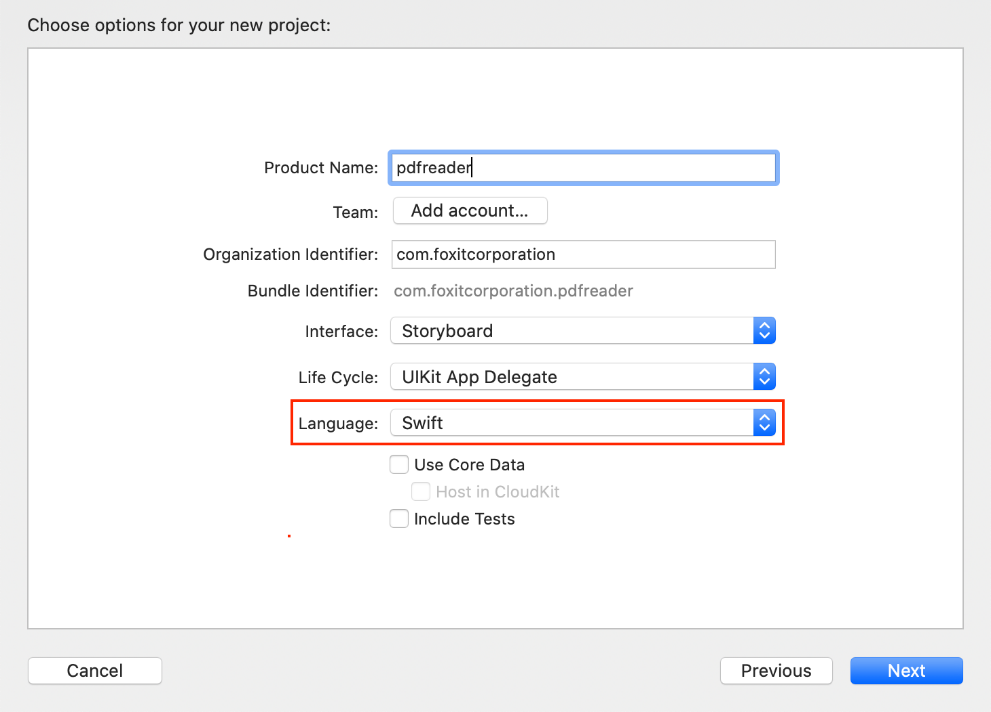
Figure 3-12
Integrate Foxit PDF SDK for iOS into your apps
To integrate Foxit PDF SDK for iOS into your apps, please refer to section 3.1.2 “Integrate Foxit PDF SDK for iOS into your apps” to add the dynamic frameworks “FoxitRDK.framework“, “uiextensionsDynamic.framework” and “FoxitPDFScanUI.framework” into the pdfreader project.
Initialize Foxit PDF SDK for iOS
It is necessary for apps to initialize and unlock Foxit PDF SDK for iOS using a license before calling any APIs. The function + [FSLibrary initialize:key:] is provided to initialize Foxit PDF SDK. The trial license files can be found in the “libs” folder of the download package. After the evaluation period expires, you should purchase an official license to continue using it. Finish the initialization in the application method within the AppDelegate.swift file.
import FoxitRDK
…
func application(_ application: UIApplication, didFinishLaunchingWithOptions launchOptions: [UIApplicationLaunchOptionsKey: Any]?) -> Bool {
let sn = “”
let key = “”
let eRet = FSLibrary.initialize(sn, key:key)
if .errSuccess != eRet {
return false
}
return true
}
Note The parameter “sn” can be found in the “rdk_sn.txt” (the string after “SN=”) and the “key” can be found in the “rdk_key.txt” (the string after “Sign=”).
Display a PDF document using FSPDFViewCtrl
So far, we have added Foxit PDF SDK for iOS frameworks to the pdfreader project, and finished the initialization of the Foxit PDF SDK. Now, let’s start displaying a PDF document using FSPDFViewCtrl with just a few lines of code.
Note: The UI Extensions Component is not required if you only need to display a PDF document.
First of all, add a PDF file to the project which will be used as the test file. For example, we use “Sample.pdf” found in the “samples\test_files” folder of the download package. Right-click the pdfreader project, and select Add Files to “pdfreader“… to add this file. After adding, you can see the PDF in the Xcode’s Copy Bundle Resources as shown in Figure 3.
Note You can add the PDF to Copy Bundle Resources directly. Just left-click the pdfreader project, find Copy Bundle Resources in the Build Phases tab, press on the + button, and choose the file to add. You can refer to any PDF file, just add it to the Xcode’s Copy Bundle Resources.
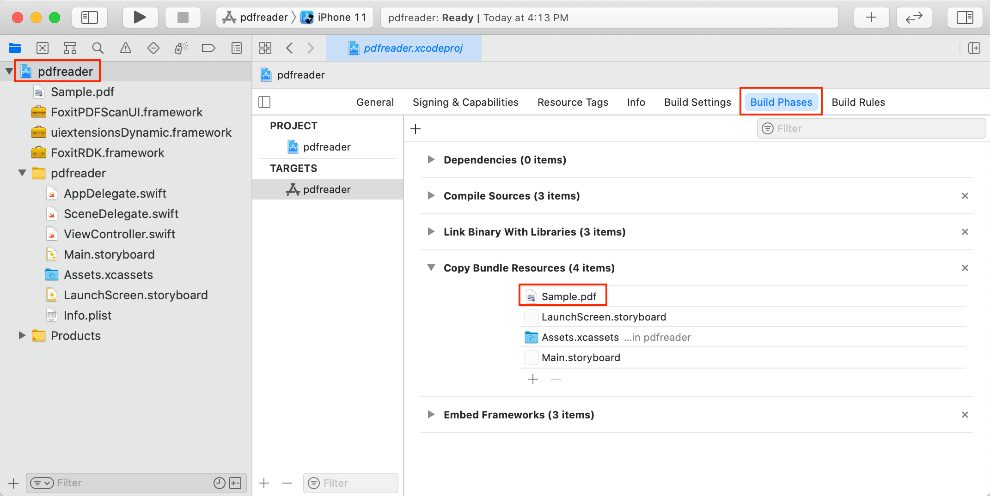
Figure 3-13
Then, add the following code to ViewController.swift to display a PDF document. It’s really easy to present a PDF on screen. All you need is to get a PDF file, instantiate a FSPDFViewCtrl object and call – [FSPDFViewCtrl openDoc:password:completion:] function to open and display the PDF.
Update ViewController.swift as follows:
import UIKit
import FoxitRDK
class ViewController: UIViewController {
override func viewDidLoad() {
super.viewDidLoad()
// Get the path of a PDF.
let pdfPath = Bundle.main.path(forResource: “Sample”, ofType: “pdf”)!
// Initialize a FSPDFViewCtrl object with the size of the entire screen.
var pdfViewCtrl: FSPDFViewCtrl!
pdfViewCtrl = FSPDFViewCtrl.init(frame:self.view.bounds)
// Set the document to display.
pdfViewCtrl.openDoc(pdfPath, password: nil, completion: nil)
// Add the pdfViewCtrl to the root view.
self.view.insertSubview(pdfViewCtrl, at: 0)
}
override func didReceiveMemoryWarning() {
super.didReceiveMemoryWarning()
// Dispose of any resources that can be recreated.
}
}
Fantastic! We have now finished building a simple iOS app in Swift which uses Foxit PDF SDK to display a PDF document with just a few lines of code. The next step is to run the project on a device or simulator.
In this guide, we build and run the project on an iPhone 11 Simulator, and you will see that the “Sample.pdf” document is displayed as shown in Figure 3. Now, this sample app has some basic PDF features, such as zooming in/out and page turning. Just have a try!
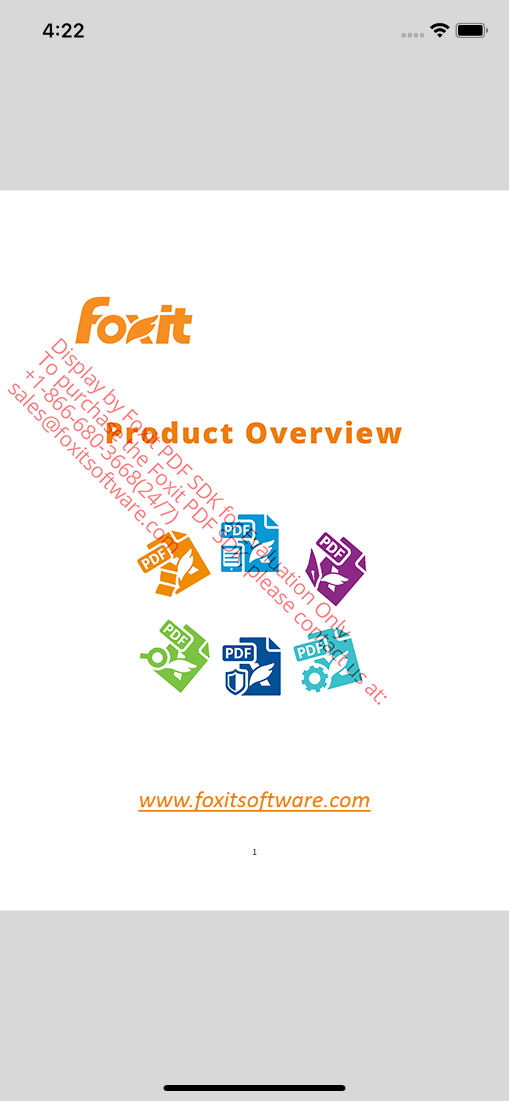
Figure 3-14
Build a full-featured PDF Reader with UI Extensions Component
Foxit PDF SDK for iOS comes with built-in UI design including the basic UI for app and the feature modules UI, which are implemented using Foxit PDF SDK and are shipped in the UI Extensions Component. Hence, building a full-featured PDF Reader is getting simpler and easier. All you need to do is to instantiate a UIExtensionsManager object and set it to FSPDFViewCtrl.
Instantiate a UIExtensionsManager object and set it to FSPDFViewCtrl
In the “ViewController.swift” file, you only need to add the following code:
import uiextensionsDynamic
…
var extensionsManager: UIExtensionsManager!
…
extensionsManager = UIExtensionsManager(pdfViewControl: pdfViewCtrl)
pdfViewCtrl.extensionsManager = extensionsManager;
Add permissions to access camera, microphone, photo library and bluetooth
In order to access the camera, microphone, photo library and bluetooth in iOS 9.0 or higher, you need to do the following configuration in the “Info.plist“.
<key>NSCameraUsageDescription</key>
<string>For adding photographs to your PDF files.</string>
<key>NSMicrophoneUsageDescription</key>
<string>RDK need to add record permissions,please allow</string>
<key>NSPhotoLibraryAddUsageDescription</key>
<string>RDK need to add picture permissions,please allow</string>
<key>NSPhotoLibraryUsageDescription</key>
<string>For adding pictures to your PDF files.</string>
<key>NSBluetoothAlwaysUsageDescription</key>
<string>RDK only lets you connect to apple pencil or keyboard.</string>
<key>NSBluetoothPeripheralUsageDescription</key>
<string>RDK only lets you connect to apple pencil or keyboard.</string>
The whole update of ViewController.swift is as follows:
import UIKit
import FoxitRDK
import uiextensionsDynamic
class ViewController: UIViewController {
var extensionsManager: UIExtensionsManager!
override func viewDidLoad() {
super.viewDidLoad()
// Get the path of a PDF.
let pdfPath = Bundle.main.path(forResource: “Sample”, ofType: “pdf”)!
// Initialize a FSPDFViewCtrl object with the size of the entire screen.
var pdfViewCtrl: FSPDFViewCtrl!
pdfViewCtrl = FSPDFViewCtrl.init(frame:self.view.bounds)
// Set the document to display.
pdfViewCtrl.openDoc(pdfPath, password: nil, completion: nil)
// Add the pdfViewCtrl to the root view.
self.view.insertSubview(pdfViewCtrl, at: 0)
// Initialize a UIExtensionsManager object and set it to pdfViewCtrl.
extensionsManager = UIExtensionsManager(pdfViewControl: pdfViewCtrl)
pdfViewCtrl.extensionsManager = extensionsManager;
}
override func didReceiveMemoryWarning() {
super.didReceiveMemoryWarning()
// Dispose of any resources that can be recreated.
}
}
Let’s run it on an iPhone 11 Simulator. Now, it is a full-featured PDF Reader as shown in Figure 3, which includes all of the features in Complete PDF Viewer demo. Feel free to try it.

Figure 3-15
Add the scanning feature based on the full-featured PDF Reader
The scanning feature is a stand-alone module which is not shipped in the UI Extensions Component, so if you want to use this feature in your project, you should add the core code below to call the scanning module:
import FoxitPDFScanUI
// Initialize the scan module.
PDFScanManager.initializeScanner(0, serial2: 0);
PDFScanManager.initializeCompression(0, serial2: 0);
// Get the PDFScan controller.
let VC = PDFScanManager.share().getPDFScanView();
self.present(VC, animated: true, completion: nil);
PDFScanManager.saveAsCallBack = { (error, savePath) -> () in
// <add your code>
}
For + [PDFScanManager initializeScanner:serial2:] and + [PDFScanManager initializeCompression:serial2:] interfaces, if you set the parameters to 0, then the scanned image will be with watermark. If you do not want to have watermark, you should contact Foxit sales or support team to get the license key.
Based on the previous section, we add a new button to call the scan module.
Update ViewController.swift as follows:
Assuming that you have copied the scan.imageset file in “samples/swift/complete_pdf_viewer_swift/Sources/Assets.xcassets/” folder to “pdfreader/pdfreader/Assets.xcassets” folder.
import UIKit
import FoxitRDK
import uiextensionsDynamic
import FoxitPDFScanUI
class ViewController: UIViewController {
var extensionsManager: UIExtensionsManager!
var openScanBtn: UIButton!
override func viewDidLoad() {
super.viewDidLoad()
// Get the path of a PDF.
let pdfPath = Bundle.main.path(forResource: “Sample”, ofType: “pdf”)!
// Initialize a FSPDFViewCtrl object with the size of the entire screen.
var pdfViewCtrl: FSPDFViewCtrl!
pdfViewCtrl = FSPDFViewCtrl.init(frame:self.view.bounds)
// Set the document to display.
pdfViewCtrl.openDoc(pdfPath, password: nil, completion: nil)
// Add the pdfViewCtrl to the root view.
self.view.insertSubview(pdfViewCtrl, at: 0)
// Initialize a UIExtensionsManager object and set it to pdfViewCtrl.
extensionsManager = UIExtensionsManager(pdfViewControl: pdfViewCtrl)
pdfViewCtrl.extensionsManager = extensionsManager;
// Create a scan button.
openScanBtn = UIButton(frame: CGRect(x: view.frame.size.width – 80, y: view.frame.size.height – 140, width: 60, height: 60))
openScanBtn.setImage(UIImage(named: “scan”), for: .normal);
openScanBtn.addTarget(self, action: #selector(openScan(_:)), for: .touchUpInside)
// Add the scan button to the root view.
self.view.addSubview(openScanBtn);
// Initialize the scan module.
PDFScanManager.initializeScanner(0, serial2: 0);
PDFScanManager.initializeCompression(0, serial2: 0);
}
@IBAction func openScan(_ sender: UIButton) {
let VC = PDFScanManager.share().getPDFScanView();
self.present(VC, animated: true, completion: nil);
PDFScanManager.saveAsCallBack = { (error, savePath) -> () in
if ((savePath) != nil) {
if ((VC.presentingViewController) != nil) {
VC.presentingViewController?.dismiss(animated: false, completion: nil)
}
VC.dismiss(animated: false, completion: nil)
}
}
}
override func didReceiveMemoryWarning() {
super.didReceiveMemoryWarning()
// Dispose of any resources that can be recreated.
}
}
Run the project on an iPhone 11 Simulator, then you will see the following window (Figure 3), tap the scan button to start scanning documents.

Figure 3-16
Rapidly building a full-featured PDF Reader using Mac Catalyst
The previous section introduces how to build a full-featured PDF Reader app with Foxit PDF SDK for iOS, which can be only deployed to iPhone and iPad devices. In this section, we will use Foxit PDF SDK for iOS (Mac Catalyst) to build a full-featured PDF Reader app in Objective-C, which users can run on an iPhone/iPad or a Mac device. It includes the following steps:
Create a Mac app built with Mac Catalyst
Integrate Foxit PDF SDK for iOS (Catalyst) into your apps
Display a PDF document using FSPDFViewCtrl
Build a full-featured PDF Reader with UI Extensions Component
Create a Mac app built with Mac Catalyst
In this section, we use Mac Catalyst to create a Mac app with Xcode 12.0.1. Please refer to section 3.1.1 “Create a new iOS project in Objective-C” to create a Mac project named “pdfreader_catalyst“.
Integrate Foxit PDF SDK for iOS (Catalyst) into your apps
Note: In this section, we will use the default built-in UI implementations to develop the app, for simplicity and convenience (use the UI Extensions Component directly, and don’t need to build the source code project), we only need to add the following files to the pdfreader_catalyst project.
FoxitRDK.xcframework – The framework that includes the Foxit PDF SDK for iOS dynamic library and associated header files.
uiextensionsDynamic.xcframework – The framework that includes UI Extensions dynamic library, associated header files, and the resource files that are needed for the default built-in UI implementations.
(optional) FoxitPDFScanUI.framework – The framework that includes Foxit PDF SDK for scanning dynamic library, associated header files, and the resource files that are needed for the default built-in UI implementations of scanning feature.
Note: The FoxitPDFScanUI.framework only support iOS platform, and does not support macOS platform.
To add the above three dynamic framework files into the pdfreader_catalyst project, please follows the steps below:
Add support for Mac. Left-click the project, find Deployment Info in the General tab, select the Mac checkbox as shown in Figure 4. (If your app supports iPhone/iPad only, the checkbox is unavailable.)
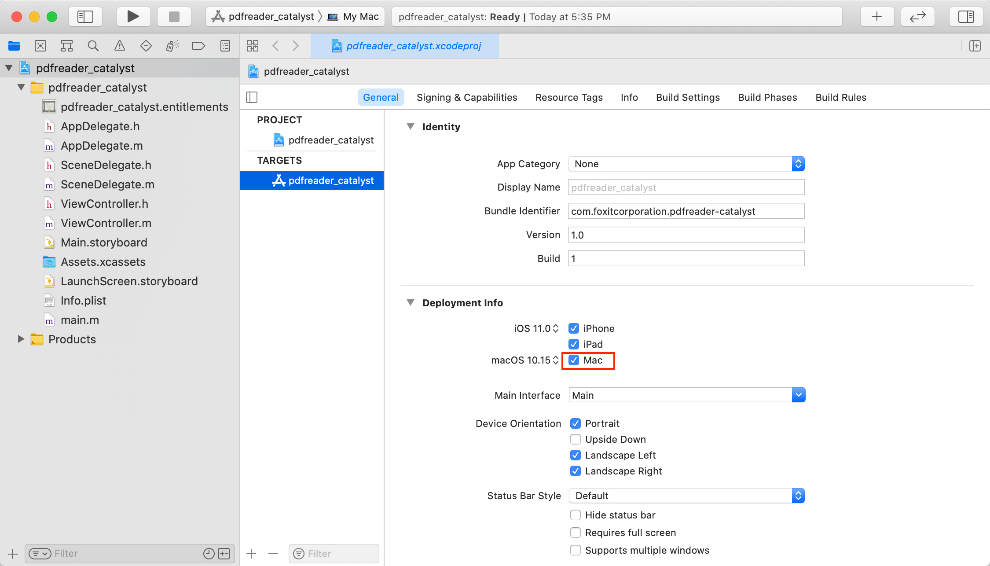
Figure 4-1
Drag the FoxitRDK.xcframework, uiextensionsDynamic.xcframework and FoxitPDFScanUI.framework in the “libs” folder of the download package to the pdfreader_catalyst project.
Note: Make sure to check the “Copy items if needed” option when dragging the framework (See Figure 4).
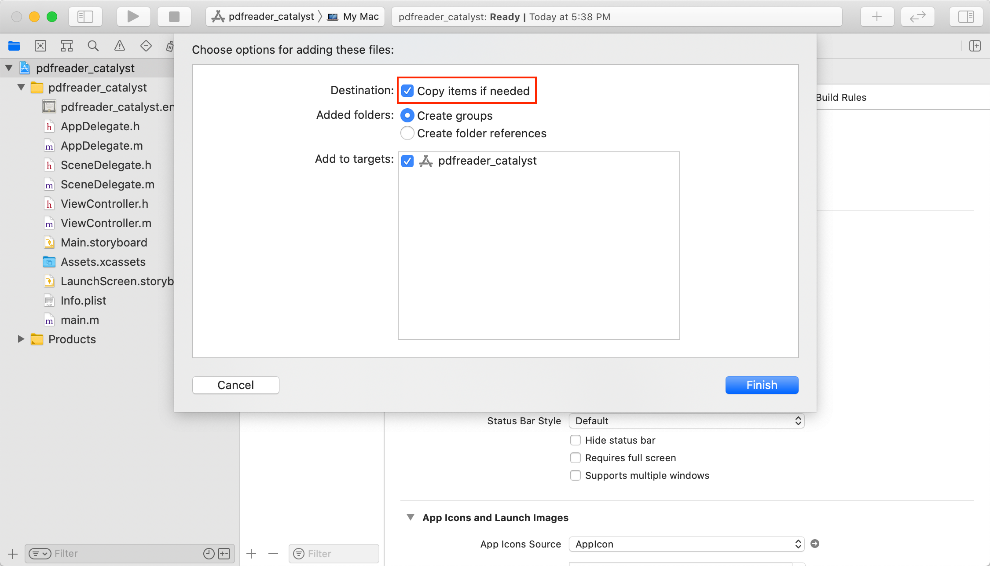
Figure 4-2
Embed the dynamic frameworks. Left-click the project, find Frameworks, Libraries, and Embedded Content in the General tab, and then choose “Embed & Sign” and the supported platforms as shown in Figure 4.
Note: The FoxitPDFScanUI.framework only support iOS platform.
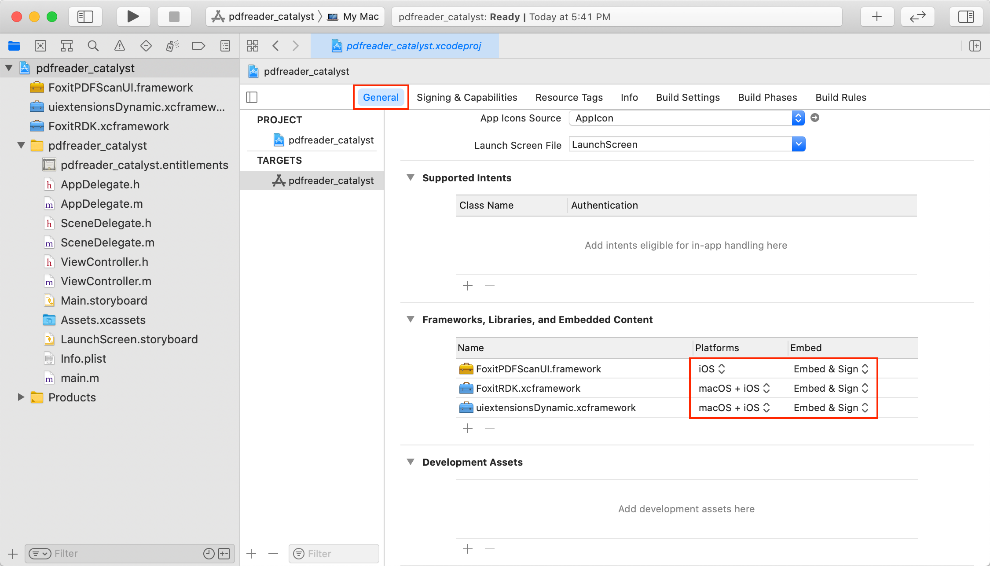
Figure 4-3
Check for Framework search paths. Left-click the project, find Search Paths in the Build Settings tab, check if the Framework search paths is set, if not, please set it correctly. (See Figure 4)
Note: You may need to set the $(PROJECT_DIR) to be recursive. Just double click the path and set it.

Figure 4-4
Now, we have added “FoxitRDK.xcframework“, “uiextensionsDynamic.xcframework” and “FoxitPDFScanUI.framework” to the pdfreader_catalyst project successfully.
Initialize Foxit PDF SDK for iOS (Catalyst)
To initialize Foxit PDF SDK for iOS (Catalyst), it is exactly the same as the section 3.1.3 “Initialize Foxit PDF SDK for iOS”.
Display a PDF document using FSPDFViewCtrl
To display a PDF document, it is exactly the same as the section 3.1.4 “Display a PDF document using FSPDFViewCtrl”. Add a PDF file to the project, and add the following code to ViewController.m referring to “Display a PDF document using FSPDFViewCtrl”.
Update ViewController.m as follows:
#import “ViewController.h”
#import <FoxitRDK/FSPDFViewControl.h>
@interface ViewController ()
@end
@implementation ViewController
– (void)viewDidLoad {
[super viewDidLoad];
// Get the path of a PDF.
NSString* pdfPath = [[NSBundle mainBundle] pathForResource:@”Sample” ofType:@”pdf”];
// Initialize a FSPDFViewCtrl object with the size of the entire screen.
FSPDFViewCtrl* pdfViewCtrl;
pdfViewCtrl = [[FSPDFViewCtrl alloc] initWithFrame: [self.view bounds]];
// Open an unencrypted PDF document.
[pdfViewCtrl openDoc:pdfPath password:nil completion:nil];
// Add the pdfViewCtrl to the root view.
[self.view addSubview:pdfViewCtrl];
}
– (void)didReceiveMemoryWarning {
[super didReceiveMemoryWarning];
// Dispose of any resources that can be recreated.
}
@end
Then, build and run the project. This project can be run on an iPhone/iPad, or a Mac. In this section, select “My Mac” as the destination and run the project. After building the project successfully, you will see that the “Sample.pdf” document is displayed as shown in Figure 4.
Note: You may need to register your Mac using a development provisioning profile which allows your app to launch on devices and use certain app services during development.

Figure 4-5
Build a full-featured PDF Reader with UI Extensions Component
To build a full-featured PDF Reader, it is similar to the section 3.1.5 “Build a full-featured PDF Reader with UI Extensions Component”. Update the ViewController.m as follows:
#import “ViewController.h”
#import <FoxitRDK/FSPDFViewControl.h>
#import <uiextensionsDynamic/uiextensionsDynamic.h>
@interface ViewController ()
@end
@implementation ViewController
{
UIExtensionsManager* extensionsManager;
}
– (void)viewDidLoad {
[super viewDidLoad];
// Get the path of a PDF.
NSString* pdfPath = [[NSBundle mainBundle] pathForResource:@”Sample” ofType:@”pdf”];
// Initialize a FSPDFViewCtrl object with the size of the entire screen.
FSPDFViewCtrl* pdfViewCtrl;
pdfViewCtrl = [[FSPDFViewCtrl alloc] initWithFrame: [self.view bounds]];
// Open an unencrypted PDF document.
[pdfViewCtrl openDoc:pdfPath password:nil completion:nil];
// Add the pdfViewCtrl to the root view.
[self.view addSubview:pdfViewCtrl];
// Instantiate a UIExtensionsManager object and set it to pdfViewCtrl
extensionsManager = [[UIExtensionsManager alloc] initWithPDFViewControl:pdfViewCtrl];
pdfViewCtrl.extensionsManager = extensionsManager;
}
– (void)didReceiveMemoryWarning {
[super didReceiveMemoryWarning];
// Dispose of any resources that can be recreated.
}
@end
Then, build and run the project on your Mac. After building the project successfully, you will see that the “Sample.pdf” document is displayed as shown in Figure 4.

Figure 4-6
Customizing User Interface
Foxit PDF SDK for iOS provides a simple, clean and friendly user interface for developers to quickly build a full-featured PDF app without needing to take much time on the design. Furthermore, customizing the user interface is straightforward. Foxit PDF SDK for iOS provides the source code of the UI Extensions Component that contains ready-to-use UI module implementations, which lets the developers have full control of styling the appearance as desired.
From version 4.0, developers can flexibly customize the features they want through a configuration file.
From version 5.0, every element in the built-in UI can be configurable. More advanced APIs and more powerful configuration file are provided for developers to further customize the UI elements, such as showing or hiding a specific panel, top/bottom toolbar, the items in the top toolbar, and the items in the View setting bar and More Menu view.
From version 6.3, the configuration file has been enhanced which provides more optional settings to customize the UI including the rights management and the properties of UI elements.
The following section will introduce how to customize the feature modules, rights management and UI elements through a configuration file, or APIs, or the source code.
Customize the UI through a configuration file
Through a configuration file, developers can easily choose the features module, set the rights management and the properties of UI elements without needing to write any additional code or redesign the app’s UI.
Introduction to JSON file
The configuration file can be provided as a JSON file or implemented directly in code. We recommend you to use the JSON format which is more intuitive and clearer to view and configure the items.
You can refer to the JSON file found in “samples\complete_pdf_viewer\Source\Resource\” folder of Foxit PDF SDK for iOS package. It looks like as follows:
{
“modules”: {
“readingbookmark”: true,
“outline”: true,
“annotations”: {
“highlight”: true,
“underline”: true,
“squiggly”: true,
“strikeout”: true,
“insert”: true,
“replace”: true,
“line”: true,
“rectangle”: true,
“oval”: true,
“arrow”: true,
“pencil”: true,
“eraser”: true,
“typewriter”: true,
“textbox”: true,
“callout”: true,
“note”: true,
“stamp”: true,
“polygon”: true,
“cloud”: true,
“polyline”: true,
“measure”: true,
“image”: true,
“audio”: true,
“video”: true,
“redaction”: true
},
“thumbnail”: true,
“attachment”: true,
“signature”: true,
“fillSign”: true,
“search”: true,
“navigation”: true,
“form”: true,
“selection”: true,
“encryption”: true,
“multipleSelection”: true
},
“permissions”: {
“runJavaScript” : true,
“copyText” : true,
“disableLink” : false
},
“uiSettings”: {
“pageMode”:”Single”,
“continuous”:false,
“colorMode” : “Normal”,
“zoomMode” : “FitWidth”,
“mapForegroundColor” : “#5d5b71”,
“mapBackgroundColor” : “#00001b”,
“reflowBackgroundColor”:”#ffffff”,
“disableFormNavigationBar” : false,
“highlightForm” : true,
“highlightLink” : true,
“highlightLinkColor” : “#16007fff”,
“highlightFormColor”:”#200066cc”,
“fullscreen” : true,
“enableTopbarDraggable” : 2,
“annotations”: {
“continuouslyAdd” : true,
“highlight”: {
“color” : “#ffff00”,
“opacity” : 1.0
},
“areaHighlight”: {
“color” : “#ffff00”,
“opacity” : 1.0
},
“underline”: {
“color” : “#66cc33”,
“opacity” : 1.0
},
“squiggly”: {
“color” : “#993399”,
“opacity” : 1.0
},
“strikeout”: {
“color” : “#ff0000”,
“opacity” : 1.0
},
“insert”: {
“color” : “#993399”,
“opacity” : 1.0
},
“replace”: {
“color” : “#0000ff”,
“opacity” : 1.0
},
“line”: {
“color” : “#ff0000”,
“opacity” : 1.0,
“thickness” : 2
},
“rectangle”: {
“color” : “#ff0000”,
“fillColor” : “#00FFFFFF”,
“opacity” : 1.0,
“thickness” : 2
},
“oval”: {
“color” : “#ff0000”,
“fillColor” : “#00FFFFFF”,
“opacity” : 1.0,
“thickness” : 2
},
“arrow”: {
“color” : “#ff0000”,
“opacity” : 1.0,
“thickness” : 2
},
“pencil”: {
“color” : “#ff0000”,
“opacity” : 1.0,
“thickness” : 2
},
“highlighter”: {
“color” : “#ffff00”,
“opacity” : 0.5,
“thickness” : 12
},
“polygon”: {
“color” : “#ff0000”,
“fillColor” : “#00FFFFFF”,
“opacity” : 1.0,
“thickness” : 2
},
“cloud”: {
“color” : “#ff0000”,
“fillColor” : “#00FFFFFF”,
“opacity” : 1.0,
“thickness” : 2
},
“polyline”: {
“color” : “#ff0000”,
“opacity” : 1.0,
“thickness” : 2
},
“typewriter”: {
“textColor” : “#0000ff”,
“opacity” : 1.0,
“textFace” : “Courier”,
“textSize” : 18.0
},
“textbox”: {
“color” : “#ff0000”,
“textColor”: “#0000ff”,
“opacity” : 1.0,
“textFace” : “Courier”,
“textSize” : 18.0
},
“callout”: {
“color”: “#ff0000”,
“textColor”: “#0000ff”,
“opacity” : 1.0,
“textFace” : “Courier”,
“textSize” : 18.0
},
“note”: {
“color” : “#ff0000”,
“opacity” : 1.0,
“icon” : “Comment”
},
“attachment”: {
“color” : “#ff0000”,
“opacity” : 1.0,
“icon” : “Pushpin”
},
“image”: {
“rotation” : 0,
“opacity” : 1.0
},
“measure”: {
“color” : “#ff0000”,
“opacity” : 1.0,
“thickness” : 2,
“scaleFromUnit” : “inch”,
“scaleToUnit” : “inch”,
“scaleFromValue” : 1,
“scaleToValue” : 1
},
“redaction”: {
“fillColor” : “#000000”,
“textColor”: “#ff0000”,
“textFace” : “Courier”,
“textSize” : 12
}
},
“form”: {
“textField”: {
“textColor”: “#000000”,
“textFace”: “Courier”,
“textSize”: 0
},
“checkBox”: {
“textColor”: “#000000”
},
“radioButton”: {
“textColor”: “#000000”
},
“comboBox”: {
“textColor”: “#000000”,
“textFace”: “Courier”,
“textSize”: 0,
“customText”: false
},
“listBox”: {
“textColor”: “#000000”,
“textFace”: “Courier”,
“textSize”: 0,
“multipleSelection”: false
}
},
“signature”: {
“color” : “#000000”,
“thickness” : 4
}
}
}
Note:
The values in the above JSON file are the default settings for the configuration items. If some configuration items are not in the JSON file, the default settings will be used. For example, if you comment out ““highlight”: true,“, it is still enabled.
Only the attachment annotation is not controlled by the subitems in “annotations”. Click the Home button at the top toolbar to select the Comment, then you can find the attachment annotation, which is as shown in Figure 5.
““attachment”: true,” controls the attachments panel and attachment annotation. If you set it to “false”, both of them will be disabled. If you want to hide all the tools in the Comment, you should set both “annotations” and “attachment” to “false“.

Figure 5-1
Configuration Items Description
The JSON configuration file includes three parts: feature modules, rights management, and UI settings (for example, UI elements properties). This section will set forth the configuration items in detail.
Configure feature module
Note: The value type of the feature module items is bool, where “true” means that the feature module will be enabled, and “false” means that the feature module will be disabled. The default value is “true”.
| Feature Module | Description |
| readingbookmark | User-defined bookmark |
| outline | PDF document bookmark |
| annotations (highlight, underline, squiggly, strikeout, insert, replace, line, rectangle, oval, arrow, pencil, eraser, typewriter, textbox, callout, note, stamp, polygon, cloud, polyline, measure, image, audio, video, redaction) | Annotation module collection |
| thumbnail | PDF page thumbnail display and page management |
| attachment | PDF document attachments and attachment annotations |
| signature | Digital signatures and handwritten signatures |
| fillSign | Fill flat forms (i.e. non-interactive forms) with text and symbols. |
| search | Text search |
| navigation | PDF page navigation |
| form | Form Filling and form data importing and exporting |
| selection | Text selection |
| encryption | PDF encryption |
| multipleSelection | Multiple annotations selection |
Configure rights management
Note: The value type of the configuration items is bool, where “true” means that the permission will be enabled, and “false” means that the permission will be disabled. The default value of runJavaScript and copyText is “true”, and the default value of disableLink is “false”.
| Rights Management | Description |
| runJavaScript | whether to allow to execute JavaScript |
| copyText | whether to allow to copy text |
| disableLink | whether to disable hyperlink |
Configure UI settings
| UI Items | Description/ Property Items | Value Type | Available Value | Default value | Note | |
| pageMode | Page display mode | String | Single/ Facing/ CoverLeft/ CoverMiddle/ CoverRight/ Reflow | Single | For dynamic XFA files, it doesn’t support Reflow mode. | |
| continuous | Whether to view pages continuously | Bool | true/false | false | True means continuous pages, false means discontinuous pages. It is invalid for “Reflow” mode. | |
| zoomMode | Page zoom mode | String | FitWidth/FitPage | FitWidth | ||
| colorMode | Page color display mode | String | Normal/Night/Map | Normal | “Night” is a special “Map” mode. | |
| mapForegroundColor | Foreground color of page display | RGB | — | #5d5b71 | It is vaild only when “colorMode” is set to “Map”. | |
| mapBackgroundColor | Background color of page dispay | RGB | — | #00001b | It is vaild only when “colorMode” is set to “Map”. | |
| reflowBackgroundColor | Background color of reflow page | RGB | — | #ffffff | ||
| disableFormNavigationBar | Whether to disable the supplementary navigation bar of the form | Bool | true/false | false | ||
| highlightForm | Whether to highlight form field | Bool | true/false | true | ||
| highlightFormColor | The highlight color of forms | ARGB | #200066cc | It include alpha channel, and it is invalid for dynamic xfa document. | ||
| highlightLink | Whether to highlight hyperlink | Bool | true/false | true | ||
| highlightLinkColor | The highlight color of links | ARGB | #16007fff | It include alpha channel. | ||
| fullscreen | Whether to display in full screen mode | Bool | true/false | true | It will be in full screen mode immediately when opening a document if “fullscreen” is set to “true”. If the user clicks on the page, the toolbar will be displayed. After 5 seconds, if it is in full screen mode, the toolbar and other auxiliary tool buttons will be hidden automatically. | |
| enableTopbarDraggable | Whether to enable dragging topbar | Integer | 0,1,2,3 | 2 | 0: the topbar dragging is disabled. 1: the topbar dragging is enabled only for iPhone. 2: the topbar dragging is enabled only for iPad. 3: the topbar dragging is enabled for both iPhone and iPad. | |
| annotations | continuouslyAdd | Bool | true/false | true | Whether to add annotation continuously | |
| highlight | color | RGB | #ffff00 | |||
| opacity | numeric | [0.0-1.0] | 1.0 | |||
| areaHighlight | color | RGB | #ffff00 | |||
| opacity | numeric | [0.0-1.0] | 1.0 | |||
| underline | color | RGB | #66cc33 | |||
| opacity | numeric | [0.0-1.0] | 1.0 | |||
| squiggly | color | RGB | #993399 | |||
| opacity | numeric | [0.0-1.0] | 1.0 | |||
| strikeout | color | RGB | #ff0000 | |||
| opacity | numeric | [0.0-1.0] | 1.0 | |||
| insert | color | RGB | #993399 | |||
| opacity | numeric | [0.0-1.0] | 1.0 | |||
| replace | color | RGB | #0000ff | |||
| opacity | numeric | [0.0-1.0] | 1.0 | |||
| line | color | RGB | #ff0000 | |||
| opacity | numeric | [0.0-1.0] | 1.0 | |||
| thickness | numeric | [1-12] | 2 | |||
| rectangle | color | RGB | #ff0000 | |||
| fillColor | RGB | #00FFFFFF | ||||
| opacity | numeric | [0.0-1.0] | 1.0 | |||
| thickness | numeric | [1-12] | 2 | |||
| oval | color | RGB | #ff0000 | |||
| fillColor | RGB | #00FFFFFF | ||||
| opacity | numeric | [0.0-1.0] | 1.0 | |||
| thickness | numeric | [1-12] | 2 | |||
| arrow | color | RGB | #ff0000 | |||
| opacity | numeric | [0.0-1.0] | 1.0 | |||
| thickness | numeric | [1-12] | 2 | |||
| pencil | color | RGB | #ff0000 | |||
| opacity | numeric | [0.0-1.0] | 1.0 | |||
| thickness | numeric | [1-12] | 2 | |||
| highlighter | color | RGB | #ffff00 | |||
| opacity | numeric | [0.0-1.0] | 0.5 | |||
| thickness | numeric | [1-12] | 12 | |||
| polygon | color | RGB | #ff0000 | |||
| fillColor | RGB | #00FFFFFF | ||||
| opacity | numeric | [0.0-1.0] | 1.0 | |||
| thickness | numeric | [1-12] | 2 | |||
| cloud | color | RGB | #ff0000 | |||
| fillColor | RGB | #00FFFFFF | ||||
| opacity | numeric | [0.0-1.0] | 1.0 | |||
| thickness | numeric | [1-12] | 2 | |||
| polyline | color | RGB | #ff0000 | |||
| opacity | numeric | [0.0-1.0] | 1.0 | |||
| thickness | numeric | [1-12] | 2 | |||
| typewriter | textColor | RGB | #0000ff | |||
| opacity | numeric | [0.0-1.0] | 1.0 | |||
| textFace | String | Courier/ Courier-Bold/ Courier-BoldOblique/ Courier-Oblique/ Helvetica/ Helvetica-Bold/ Helvetica-BoldOblique/ Helvetica-Oblique/ Times-Roman/ Times-Bold/ Times-Italic/ Times-BoldItalic | Courier | Text font name. If set to an invalid value, the default value will be used. | ||
| textSize | Integer | >=1 | 18 | |||
| textbox | color | RGB | #ff0000 | |||
| textColor | RGB | #0000ff | ||||
| opacity | numeric | [0.0-1.0] | 1.0 | |||
| textFace | String | Courier/ Courier-Bold/ Courier-BoldOblique/ Courier-Oblique/ Helvetica/ Helvetica-Bold/ Helvetica-BoldOblique/ Helvetica-Oblique/ Times-Roman/ Times-Bold/ Times-Italic/ Times-BoldItalic | Courier | Text font name. If set to an invalid value, the default value will be used. | ||
| textSize | Integer | >=1 | 18 | |||
| callout | color | RGB | #ff0000 | |||
| textColor | RGB | #0000ff | ||||
| opacity | numeric | [0.0-1.0] | 1.0 | |||
| textFace | String | Courier/ Courier-Bold/ Courier-BoldOblique/ Courier-Oblique/ Helvetica/ Helvetica-Bold/ Helvetica-BoldOblique/ Helvetica-Oblique/ Times-Roman/ Times-Bold/ Times-Italic/ Times-BoldItalic | Courier | Text font name. If set to an invalid value, the default value will be used. | ||
| textSize | Integer | >=1 | 18 | |||
| note | color | RGB | #ff0000 | |||
| opacity | numeric | [0.0-1.0] | 1.0 | |||
| icon | String | Comment/ Key/ Note/ Help/ NewParagraph/ Paragraph/ Insert | Comment | If set to an invalid value, the default value will be used. | ||
| attachment | color | RGB | #ff0000 | |||
| opacity | numeric | [0.0-1.0] | 1.0 | |||
| icon | String | Graph/ PushPin/ Paperclip/ Tag | PushPin | |||
| image | rotation | numeric | 0/90/180/270 | 0 | If set to an invalid value, the default value will be used. | |
| opacity | numeric | [0.0-1.0] | 1.0 | |||
| measure | color | RGB | ff0000 | |||
| opacity | numeric | [0.0-1.0] | 1.0 | |||
| thickness | numeric | [1-12] | 2 | |||
| scaleFromUnit | String | pt/m/cm/mm/inch/p/ft/yd | inch | The original unit of the scale. If set to an invalid value, the default value will be used. | ||
| scaleToUnit | String | pt/m/cm/mm/inch/p/ft/yd | inch | The target unit of the scale. If set to an invalid value, the default value will be used. | ||
| scaleFromValue | numeric | 1 | The original value of the scale | |||
| scaleToValue | numeric | 1 | The target value of the scale | |||
| redaction | fillColor | RGB | #000000 | |||
| textColor | RGB | #ff0000 | ||||
| textFace | String | Courier/ Helvetica/ Times | Courier | Text font name. If set to an invalid value, the default value will be used. | ||
| textSize | Integer | >=1 | 12 | |||
| form | textField | textColor | RGB | #000000 | ||
| textFace | String | Courier/ Helvetica/ Times | Courier | Text font name. If set to an invalid value, the default value will be used. | ||
| textSize | Integer | >=0 | 0 | 0 means adjusting the font size automatically. | ||
| checkBox | textColor | RGB | #000000 | |||
| radioButton | textColor | RGB | #000000 | |||
| comboBox | textColor | RGB | #000000 | |||
| textFace | String | Courier/ Helvetica/ Times | Courier | Text font name. If set to an invalid value, the default value will be used. | ||
| textSize | Integer | >=0 | 0 | 0 means adjusting the font size automatically. | ||
| customText | false | Whether to allow to customize text. | ||||
| listBox | textColor | RGB | #000000 | |||
| textFace | String | Courier/ Helvetica/ Times | Courier | Text font name. If set to an invalid value, the default value will be used. | ||
| textSize | Integer | >=0 | 0 | 0 means adjusting the font size automatically. | ||
| multipleSelection | false | Whether to allow to support multiple selection. | ||||
| signature | color | RGB | #000000 | |||
| thickness | numeric | [1-12] | 4 |
Instantiate a UIExtensionsManager object with the configuration file
In section 3.1.5 (Objective-C) and section 3.2.5 (Swift), we have already introduced how to instantiate UIExtensionsManager, and in this way all the built-in UI framework would be loaded by default. In this section, we will provide another method to instantiate UIExtensionsManager that uses the configuration file, so that developers can easily customize the UI as desired.
Please refer to the following code to instantiate a UIExtensionsManager object with the configuration file.
Note: You should prepare the JSON configuration file, and then add it to your project. Here, we assume that you have already added a JSON file named “uiextensions_config.json”.
In ViewController.m: (Objective-C)
UIExtensionsManager* extensionsManager;
…
// Instantiate a FSPDFViewCtrl object with the size of the entire screen.
FSPDFViewCtrl* pdfViewCtrl;
pdfViewCtrl = [[FSPDFViewCtrl alloc] initWithFrame: [self.view bounds]];
// Get the path of the JSON configuration file.
NSString* configPath = [[NSBundle mainBundle] pathForResource:@”uiextensions_config” ofType:@”json”];
// Initialize a UIExtensionsManager object and set it to pdfViewCtrl.
extensionsManager = [[UIExtensionsManager alloc] initWithPDFViewControl:pdfViewCtrl configuration:[NSData dataWithContentsOfFile:configPath]];
if (nil == extensionsManager) {
return;
}
pdfViewCtrl.extensionsManager = extensionsManager;
In ViewController.swift: (Swift)
var extensionsManager: UIExtensionsManager!
…
// Initialize a FSPDFViewCtrl object with the size of the entire screen
var pdfViewCtrl: FSPDFViewCtrl!
pdfViewCtrl = FSPDFViewCtrl.init(frame:self.view.bounds)
// Get the path of the JSON configuration file.
let configPath = Bundle.main.path(forResource: “uiextensions_config”, ofType: “json”)
var data: Data?
if nil != configPath {
data = NSData(contentsOfFile: configPath!) as Data?
}
// Initialize a UIExtensionsManager object and set it to pdfViewCtrl.
extensionsManager = UIExtensionsManager.init(pdfViewControl: pdfViewCtrl, configuration: data)
if nil == extensionsMgr {
return
}
pdfViewCtrl.extensionsManager = extensionsManager;
Note: Here, we use a configuration file to instantiate the UIExtensionsManager. If you do not want to use configuration file, please refer to the section 3.1.5 (Objective-C) and section 3.2.5 (Swift).
Examples for customizing UI through a configuration file
In this section, we will show you how to customize feature modules, rights management and UI settings (for example, UI elements properties) in your project. You will find it is extremely easy! You only need to modify the configuration file. Below you can see some examples of how to do it.
Note: For your convenience, we will try it in the “complete_pdf_viewer” (Objective-C) and “complete_pdf_viewer_swift” (Swift) demos found in the “samples” folder.
Open the demos in Xcode. Find the configuration file “uiextensions_config.json” under “complete_pdf_viewer\Resource” or “complete_pdf_viewer_swift\Resource”.
Example1: Disable “readingbookmark” and “navigation” feature modules.
In the JSON file, set the values of “readingbookmark” and “navigation” to “false” as follows:
“readingbookmark”: false,
“navigation”: false,
Then, rebuild and run the demo to see the result. Following lists the comparison diagrams:
Before: After:


The “readingbookmark” and “navigation” feature modules are removed.
Example2: Disable hyperlinks.
In the JSON file, set the value of “disableLink” to “true” as follows:
“permissions”: {
“runJavaScript”: true,
“copyText”: true,
“disableLink”: true
},
Then, rebuild and run the demo to see the result, and you will find that there is no any response when clicking the hyperlinks.
Example3: Set the highlight color from yellow to red.
In the JSON file, set the color property of “highlight” to “#ff0000” as follows:
“highlight”: {
“color” : “#ff0000“,
“opacity” : 1.0
},
Then, rebuild and run the demo to see the result. Following lists the comparison diagrams:
Before: After:


The highlight color has been changed to red.
Customize UI elements through APIs
In version 4.0, Foxit PDF SDK for iOS supports customizing to show or hide the whole top or bottom toolbar, and from version 5.0, it provides APIs to customize to show or hide a specific panel, the items in the top/bottom toolbar, View setting bar and More Menu view, which is convenient for developers to modify the UI elements in the context of the built-in UI framework.
From version 8.0, the built-in UI in the UI Extensions Component has changed dramatically.
Note: For your convenience, we will show you how to customize UI elements through APIs in the “complete_pdf_viewer” (Objective-C) and “complete_pdf_viewer_swift” (Swift) demos found in the “samples” folder. We assume that you have not modified the “uiextensions_config.json” file in the demos, which means that all of the built-in UI in the UI Extensions Component are enabled.
Customize to hide top/bottom toolbar
In the top/bottom toolbar (See Figure 5), you can do the following operations:
Show or hide the top/bottom toolbar.
Show or hide a specific item in the top/bottom toolbar.
Remove a specific tab in the center of the top toolbar.
Add a custom item at any position.
Figure 5- 2
Note:
For iPad device, it has removed the bottom toolbar.
For iPhone device, the bottom toolbar is only one part, and the top toolbar is divided into two parts, so that there are three parts for the toolbar, and each part has a separate index. For iPad device, it has no bottom toolbar.
Table 5 lists the related APIs which are used to customize the top/bottom toolbar.
Table 51
| (void)enableTopToolbar:(BOOL)isEnabled | Enable or disable top toolbar. |
| (void)enableBottomToolbar:(BOOL)isEnabled | Enable or disable bottom toolbar. |
| (void)setToolbarItemHiddenWithTag: (FS_TOOLBAR_ITEM_TAG)itemTag hidden:(BOOL)isHidden | Show or hide the item in the top/bottom toolbar. |
The value of the parameter “itemTag” in setToolbarItemHiddenWithTag interface can be set as follows, which maps the features in the top/bottom toolbar.
| Item name | itemTag |
| Back | FS_TOOLBAR_ITEM_TAG_BACK |
| Search | FS_TOOLBAR_ITEM_TAG_SEARCH |
| More | FS_TOOLBAR_ITEM_TAG_MORE |
| Home | FS_TOOLBAR_ITEM_TAG_HOME |
| Edit | FS_TOOLBAR_ITEM_TAG_EDIT |
| Comment | FS_TOOLBAR_ITEM_TAG_COMMENT |
| Drawing | FS_TOOLBAR_ITEM_TAG_DRAWING |
| Form | FS_TOOLBAR_ITEM_TAG_FORM |
| Fill & Sign | FS_TOOLBAR_ITEM_TAG_SIGN |
| Panel | FS_TOOLBAR_ITEM_TAG_PANEL |
| View | FS_TOOLBAR_ITEM_TAG_VIEW or FS_TOOLBAR_ITEM_TAG_VIEW_SETTINGS |
| thumbnail | FS_TOOLBAR_ITEM_TAG_THUMBNAIL |
| Bookmark | FS_TOOLBAR_ITEM_TAG_READING_BOOKMARK |
In the following examples, we will show you how to customize the top/bottom toolbar through APIs in the “complete_pdf_viewer” (Objective-C) and “complete_pdf_viewer_swift” (Swift) demos found in the “samples” folder.
Open the demos in Xcode. Add the sample code to the “ViewController.m” (Objective-C) or “TabsViewController.swift” (Swift) (after the code that initializes UIExtensionsManager).
Note: The built-in UI is a bit different on iPhone and iPad. Most of the following examples are applicable for iPhone and iPad, and only one is applicable for iPhone. In this guide, if the custom results on iPhone and iPad are similar, we only list the result on iPhone.
Example1: Hide the whole top toolbar. (For iPhone and iPad)
Objective-C:
[self.extensionsMgr enableTopToolbar:false];
Swift:
extensionsManager.enableTopToolbar(false)
Before: After:


Example2: Hide the whole bottom toolbar. (Only for iPhone)
Objective-C:
[self.extensionsMgr enableBottomToolbar:false];
Swift:
extensionsManager.enableBottomToolbar(false)
Before: After:


Example3: Hide the “More menu” item in the top toolbar. (For iPhone and iPad)
Objective-C:
[self.extensionsMgr setToolbarItemHiddenWithTag:FS_TOOLBAR_ITEM_TAG_MORE hidden:YES];
Swift:
extensionsManager.setToolbarItemHiddenWithTag(FS_TOOLBAR_ITEM_TAG_MORE, hidden: true);
Before: After:


Example4: Hide the “Form” tab from the list in the center of the top toolbar. (For iPhone and iPad)
Objective-C:
[self.extensionsMgr setToolbarItemHiddenWithTag:FS_TOOLBAR_ITEM_TAG_FORM hidden:YES];
Swift:
extensionsManager.setToolbarItemHiddenWithTag(FS_TOOLBAR_ITEM_TAG_FORM, hidden: true)
Before: After:


Example5: Hide the “View” item in the bottom toolbar for iPhone, or hide the “View” tab from the list in the center of the top toolbar for iPad. (For iPhone and iPad)
Objective-C:
[self.extensionsMgr setToolbarItemHiddenWithTag:FS_TOOLBAR_ITEM_TAG_VIEW hidden:YES];
or
[self.extensionsMgr setToolbarItemHiddenWithTag:FS_TOOLBAR_ITEM_TAG_VIEW_SETTINGS hidden:YES];
Swift:
extensionsManager.setToolbarItemHiddenWithTag(FS_TOOLBAR_ITEM_TAG_VIEW, hidden: true)
or
extensionsManager.setToolbarItemHiddenWithTag(FS_TOOLBAR_ITEM_TAG_VIEW_SETTINGS, hidden: true)
for iPhone:
Before: After:


for iPad:
Before: After:


Example6: Add an item in the left top toolbar at the second position. (For Phone and Tablet) (assume that you have added an image named “snapshot.png” to the complete_pdf_viewer project)
FSMainTopbar *topbar = self.extensionsMgr.topToolbar;
NSMutableArray *items = topbar.itemsForPositionLeft.mutableCopy;
UIButton *btn = [UIButton new];
[btn setImage:[[UIImage imageNamed:@”snapshot”] imageWithTintColor:[UIColor whiteColor]] forState:UIControlStateNormal];
FSMainToolbarItem *item = [[FSMainToolbarItem alloc] initWithCustomView:btn];
[items insertObject:item atIndex:1];
topbar.itemsForPositionLeft = items;
The result after running the demo:

Example7: Add an item in the right top toolbar at the first position. (For Phone and Tablet) (assume that you have added an image named “snapshot.png” to the complete_pdf_viewer project)
FSMainTopbar *topbar = self.extensionsMgr.topToolbar;
NSMutableArray *items = topbar.itemsForPositionRight.mutableCopy;
UIButton *btn = [UIButton new];
[btn setImage:[[UIImage imageNamed:@”snapshot”] imageWithTintColor:[UIColor whiteColor]] forState:UIControlStateNormal];
FSMainToolbarItem *item = [[FSMainToolbarItem alloc] initWithCustomView:btn];
[items insertObject:item atIndex:0];
topbar.itemsForPositionRight = items;
The result after running the demo:

Example8: Add an item to the bottom toolbar at the first position. (Only for Phone) (assume that you have added an image named “snapshot.png” to the complete_pdf_viewer project)
FSMainBottombar *bottomBar = self.extensionsMgr.bottomToolbar;
NSMutableArray *items = bottomBar.itemsForPositionCenter.mutableCopy;
UIButton *btn = [UIButton new];
[btn setImage:[UIImage imageNamed:@”snapshot”] forState:UIControlStateNormal];
FSMainToolbarItem *item = [[FSMainToolbarItem alloc] initWithCustomView:btn];
[items insertObject:item atIndex:0];
bottomBar.itemsForPositionCenter = items;
The result after running the demo:

Customize to hide a specific Panel


To hide a specific panel (See Figure 5, includes “Bookmarks”, “Outline”, “Annotations”, “Attachments” and “Digital Signatures” panels, just taps at the bottom toolbar (for iPhone) or taps at the left top toolbar (for iPad) to find it), you only need to use the following API:
(void)setPanelHidden:(BOOL)isHidden type:(FSPanelType)type


Figure 5-3
In this section, we only give an example to show you how to hide a specific panel through APIs in the “complete_pdf_viewer” (Objective-C) and “complete_pdf_viewer_swift” (Swift) demos found in the “samples” folder. Just take the “Outline” panel as an example, and for other panels, you only need to change the FSPanelType. The corresponding relation between panels and FSPanelType are as follows:
| Panel | FSPanelType |
| Bookmarks | FSPanelTypeReadingBookmark |
| Outline | FSPanelTypeOutline |
| Annotations | FSPanelTypeAnnotation |
| Attachments | FSPanelTypeAttachment |
| Digital Signatures | FSPanelTypeDigitalSignature |
Open the demos in Xcode. Add the sample code to the “ViewController.m” (Objective-C) or “TabsViewController.swift” (Swift) (after the code that initializes UIExtensionsManager).
Note: The built-in UI is a bit different on iPhone and iPad. The following example is applicable for iPhone and iPad, if the custom results on iPhone and iPad are similar, we only list the result on iPhone.
Example1: Hide the “Outline” panel. (For iPhone and iPad)
Objective-C:
[self.extensionsMgr.panelController setPanelHidden:true type:FSPanelTypeOutline];
Swift:
extensionsManager.panelController.setPanelHidden(true, type: .outline);
Before: After:
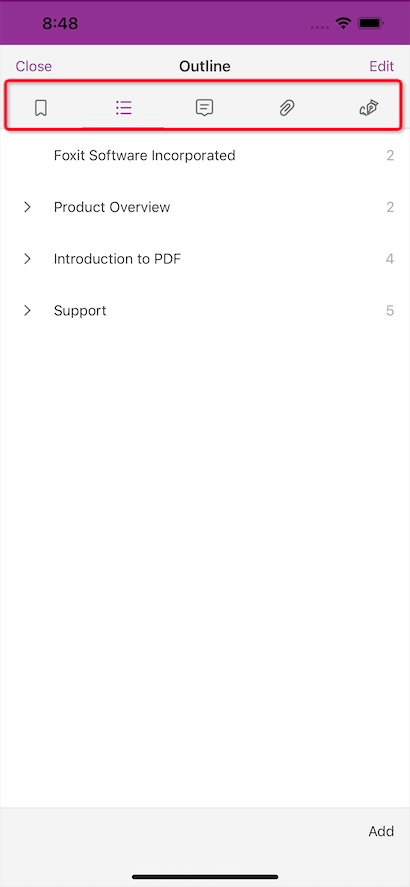
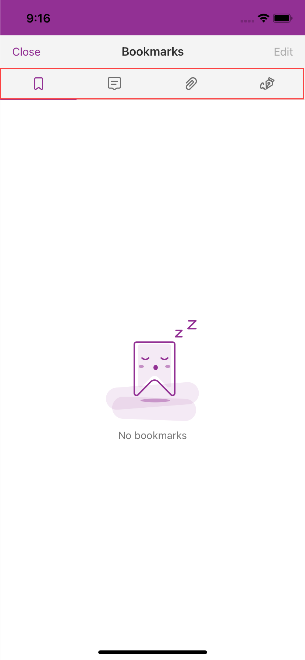
Customize to hide the UI elements in the View setting bar


To hide the UI elements in the View setting bar (See Figure 5, just taps at the bottom toolbar (for iphone) or tap icon at the top toolbar to select the View (for some iPads) to find it), you only need to use the following API:
(void)setItem:(SettingItemType)itemType hidden:(BOOL)hidden;


Figure 5-4
The value of the parameter “itemType” can be set as follows, which maps the items in the View setting bar.
| item | itemType |
| Single page mode | SINGLE |
| Facing mode | DOUBLEPAGE |
| Cover Facing mode | COVERPAGE |
| Day mode | DAYMODE |
| Page Color | PAGECOLOR |
| Night mode | NIGHTMODE |
| Continuous Scrolling mode | CONTINUOUS |
| Right to Left | PAGERTL |
| Fit page mode | FITPAGE |
| Fit width mode | FITWIDTH |
| Reflow mode | REFLOW |
| Crop mode | CROPPAGE |
| Speak | SPEECH |
| Auto Flip | AUTOFLIP |
| Rotate View | ROTATE |
| Pan and Zoom | PANZOOM |
In this section, we only take “Reflow” item as an example to show you how to hide the UI elements in the View setting bar through APIs in the “complete_pdf_viewer” (Objective-C) and “complete_pdf_viewer_swift” (Swift) demos found in the “samples” folder. For other UI elements, you only need to change the “itemType“.
Open the demos in Xcode. Add the sample code to the “ViewController.m” (Objective-C) or “TabsViewController.swift” (Swift) (after the code that initializes UIExtensionsManager).
Example1: Hide the “Reflow” item in the View setting bar. (For Phone and Tablet)
Objective-C:
[self.extensionsMgr.settingBar setItem:REFLOW hidden:YES];
Swift:
extensionsManager.settingBar.setItem(.REFLOW, hidden: true)
for iPhone:
Before: After:


for iPad:
Before: After:


Customize to hide the UI elements in the More Menu view

To hide the UI elements in the More Menu view (See Figure 5, just taps at the right top toolbar to find it), you can use the following APIs listed in the Table 5.
Table 52
| (void)setMoreViewItemHiddenWithGroup: (NSUInteger)groupTag hidden:(BOOL)isHidden | Set the enabled state of group according to “groupTag”. |
| (void)setMoreViewItemHiddenWithGroup: (NSUInteger)groupTag andItemTag:(NSUInteger)itemTag hidden:(BOOL)isHidden | Set the enabled state of item according to “groupTag” and “itemTag”. |
| (void) setIndividualMenuItemHiddenWithItemTag: (NSUInteger)itemTag hidden:(BOOL)isHidden | Set visible or invisible state for the individual group. |


Figure 5-5
The values of the parameters “groupTag” and “itemTag” in the setMoreViewItemHiddenWithGroup interface can be set as follows:
| groupTag | NSUInteger |
| TAG_GROUP_PROTECT | 10 |
| TAG_GROUP_COMMENT_FIELD | 20 |
| groupTag | itemTag | NSUInteger |
| TAG_GROUP_PROTECT | TAG_ITEM_REDACTION | 10 |
| TAG_ITEM_PASSWORD | 20 | |
| TAG_ITEM_CERTIFICATE | 30 | |
| TAG_GROUP_COMMENT_FIELD | TAG_ITEM_IMPORTCOMMENT | 40 |
| TAG_ITEM_EXPORTCOMMENT | 50 | |
| TAG_ITEM_SUMARIZECOMMENT | 60 | |
| TAG_ITEM_RESETFORM | 70 | |
| TAG_ITEM_IMPORTFORM | 80 | |
| TAG_ITEM_EXPORTFORM | 90 |
The value of the parameter “itemTag” in the setIndividualMenuItemHiddenWithItemTag interface can be set as follows:
| itemTag | NSUInteger |
| TAG_ITEM_SAVE_AS | 110 |
| TAG_ITEM_REDUCEFILESIZE | 120 |
| TAG_ITEM_WIRELESSPRINT | 130 |
| TAG_ITEM_FLATTEN | 140 |
| TAG_ITEM_SCREENCAPTURE | 150 |
In this section, we only give three examples:
Example1 and Example2 shows you how to hide a specific group or its item in the More Menu view through APIs in the “complete_pdf_viewer” (Objective-C) and “complete_pdf_viewer_swift” (Swift) demos found in the “samples” folder. Just take the group TAG_GROUP_PROTECT and the item TAG_ITEM_REDACTION as examples, and for other groups and items, please refer to these examples and only need to change the parameter value in the setMoreViewItemHiddenWithGroup interface.
Example3 shows you how to hide the item which is an individual menu item in the More Menu view through APIs. Just take the item TAG_ITEM_FLATTEN as an example, and for other individual menu items, please refer to this example and only need to change the parameter value in the setIndividualMenuItemHiddenWithItemTag interface.
Open the demos in Xcode. Add the sample code to the “ViewController.m” (Objective-C) or “TabsViewController.swift” (Swift) (after the code that initializes UIExtensionsManager).
Note: The built-in UI is a bit different on tablets and phones. The following examples are applicable for phones and tablets, if the custom results on phones and tablets are similar, we only list the result on phones.
Example1: Hide the group “TAG_GROUP_PROTECT” in the More Menu view. (For Phone and Tablet)
Objective-C:
[self.extensionsMgr.more setMoreViewItemHiddenWithGroup:TAG_GROUP_PROTECT hidden:YES];
Swift:
extensionsManager.more.setMoreViewItemHiddenWithGroup(UInt(TAG_GROUP_PROTECT), hidden: true);
Before: After:


Example2: Hide the item “TAG_ITEM_REDACTION” in the More Menu view. (For Phone and Tablet)
Objective-C:
[self.extensionsMgr.more setMoreViewItemHiddenWithGroup:TAG_GROUP_PROTECT andItemTag:TAG_ITEM_REDACTION hidden:YES];
Swift:
extensionsManager.more.setMoreViewItemHiddenWithGroup(UInt(TAG_GROUP_PROTECT), andItemTag:UInt(TAG_ITEM_REDACTION), hidden: true);
Before: After:


Example3: Hide the individual menu item “TAG_ITEM_FLATTEN” in the More Menu view. (For Phone and Tablet)
Objective-C:
[self.extensionsMgr.more setIndividualMenuItemHiddenWithItemTag:TAG_ITEM_FLATTEN hidden:YES];
Swift:
extensionsManager.more.setIndividualMenuItemHiddenWithItemTag(UInt(TAG_ITEM_FLATTEN), hidden: true);
Before: After:


Customize UI implementation through source code
In the previous sections, we have introduced how to customize the user interface through a configuration file or APIs in detail. Those changes are in the context of the built-in UI framework of Foxit PDF SDK for iOS. If you do not want to use the ready-made UI framework, you can redesign it through modifying the source code of the UI Extensions Component.
There is one thing to take note of. The source code of the UI Extensions Component is written in Objective-C, so you need to use Objective-C to modify the UI layout. If you are a Swift developer and not already familiar with Objective-C, you might only be able to customize the UI appearance that does not need writing code, such as icons and other UI resources.
To customize the UI implementation, you need to follow these steps:
First, add the following required files into your app.
FoxitRDK.framework – The framework that includes the Foxit PDF SDK for iOS dynamic library and associated header files. It can be found in the “libs” folder.
uiextensions project – It is an open source library that contains some ready-to-use UI module implementations, which can help developers rapidly embed a fully functional PDF reader into their iOS app. Of course, developers are not forced to use the default UI, they can freely customize and design the UI for their specific apps through the “uiextensions” project. It can be found in the “libs/uiextensions_src” folder.
Tip: The built-in UI customization can be done in the uiextensions project, and then you can add the new uiextensionsDynamic.framework generated by the modified uiextensions project to your app instead of the whole uiextensions project.
Second, find the specific code or images related to the UI that you want to customize in the uiextensions project, then modify them based on your requirements.
Now, for your convenience, we will show you how to customize the UI implementation in “viewer_ctrl_demo” project found in the “samples” folder.
UI Customization Example
Step 1: Add the uiextensions project into the demo.
Note: We will add the uiextensions project to the demo which is convenient for us to see the custom results. The demo already includes FoxitRDK.framework, so we just need to add the uiextensions project.
Load the “viewer_ctrl_demo” project in Xcode. Drag-and-drop “uiextensions.xcodeproj” found in the “libs/uiextensions_src” of the download package into the “viewer_ctrl_demo” project as shown in Figure 5.
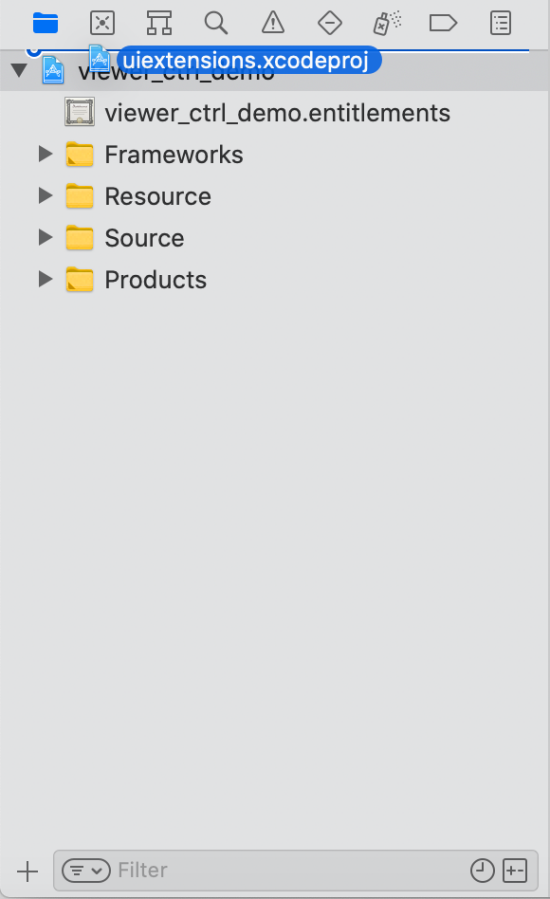
Figure 5-6
Then, it will pop up a dialog box which prompts you whether to save the project in a new workspace as shown in Figure 5. Click Save.

Figure 5-7
Save the workspace to the “samples” folder, and name “custom_viewer” as shown in Figure 5. Click Save.
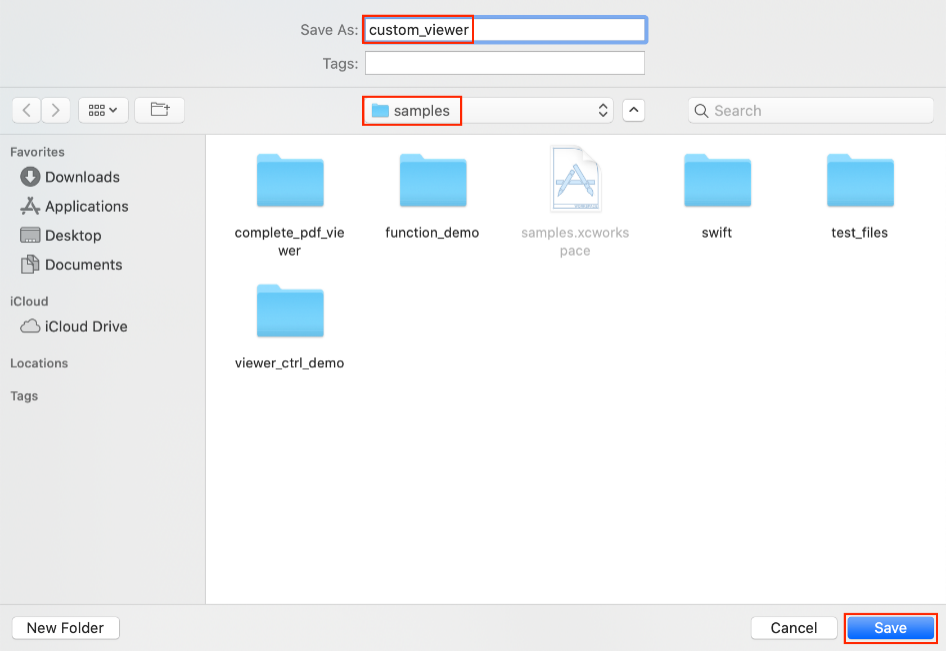
Figure 5-8
Now, the workspace looks like the Figure 5.
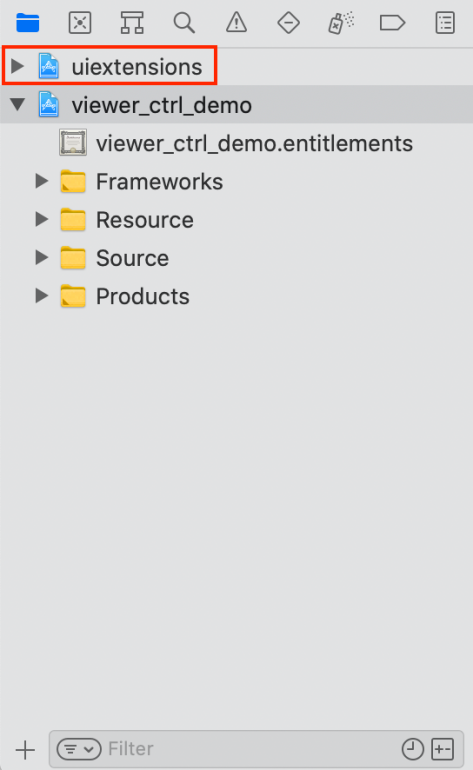
Figure 5-9
Congratulations! You have completed the first step.
Step 2: Find and modify the code or images related to the UI that you want to customize.
Now, we will show you a simple example that changes one button’s icon in the search panel as shown in Figure 5.
Tip: If you just want to change the icons of the UI elements, you can do it in the uiextensionsDynamic.framework directly instead of importing the source code of uiextensions project. But the same is that you also need to find the icon’s name.

Figure 5-10
To replace the icon, we only need to find the place where stores the icon for this button, then use another icon with the same name to replace it.
An iPhone 11 Simulator will be used as an example to run the demo. In the uiextensions project, click “uiextensionsDynamic -> Resource -> png -> Search.xcassets” as shown in Figure 5. It’s easy to find the image that we want to replace. The resource files are stored according to the features, so you can locate the related code through the icon’s name.

Figure 5-11
Right now, just replace “search_show_list.imageset” with your own icon in the “libs\uiextensions_src\UIExtensions\Resource\png\Search.xcassets” folder. For example, we use the “search.imageset” of the top search button to replace it.
After replacing, firstly build and run the uiextensionsDynamic_aggregate project as shown in Figure 5.
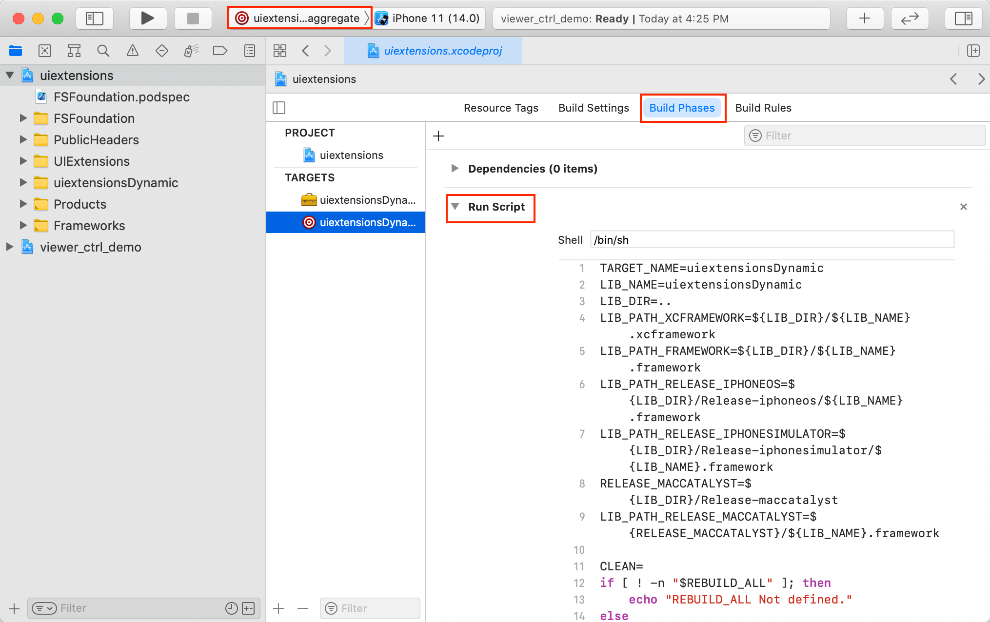
Figure 5-12
Note: The uiextensions project can generate a universal “.a” library through building uiextensions_aggregate, or generate a universal framework through building uiextensionsDynamic_aggregate, which can be used for both simulator and iOS device. In this section, we build uiextensionsDynamic_aggregate. The scripts used for generating the universal framework in the uiextension project is shown in Figure 5.
The uiextensionsDynamic.framework in the “libs” folder of the download package will be overwritten after building the uiextensionsDynamic_aggregate project successfully.
Then build and run the “viewer_ctrl_demo” project. After building successfully, try the search feature and we can see that the icon of the bottom search button has changed as shown in Figure 5.
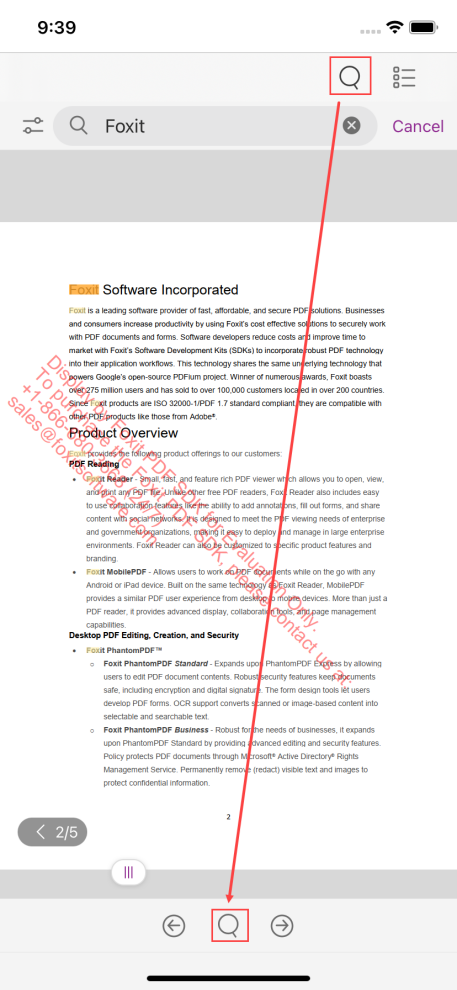
Figure 5-13
This is just a simple example to show how to customize the UI implementation. You can refer to it and feel free to customize and design the UI for your specific apps through the uiextensions project.
Working with SDK API
Foxit PDF SDK for iOS wrapped all of the features implementations into the UI Extensions Component. If you are interested in the detailed process of the features implementations, please go through this section.
In this section, we will introduce a set of major features and list some examples to show you how to implement the features using Foxit PDF SDK Core API.
Render
PDF rendering is realized through the Foxit renderer, a graphic engine that is used to render page to a bitmap or a platform device context. Foxit PDF SDK provides APIs to set rendering options/flags, for example set flag to decide whether to render form fields and signature, whether to draw image anti-aliasing and path anti-aliasing. To do rendering, you can use the following APIs:
To render page and annotations, first use function – [FSRenderer setRenderContentFlags:] to decide whether to render page and annotation both or not, and then use function – [FSRenderer startRender:matrix:pause:] to do the rendering. Function – [FSRenderer startQuickRender:matrix:pause:] can also be used to render page but only for thumbnail purpose.
To render a single annotation, use function – [FSRenderer renderAnnot:matrix:].
To render on a bitmap, use function – [FSRenderer startRenderBitmap:matrix:clip_rect:interpolation:pause:].
To render a reflowed page, use function – [FSRenderer startRenderReflowPage:matrix:pause:] .
Widget annotation is always associated with form field and form control in Foxit PDF SDK. For how to render widget annotations, here is a recommended flow:
After loading a PDF page, first render the page and all annotations in this page (including widget annotations).
Then, if use FSFiller object to fill the form, the function – [FSFiller render:matrix:renderer:] should be used to render the focused form control instead of the function – [FSRenderer renderAnnot:matrix:].
Example:
How to render a specified page to a bitmap
#import “ViewController.h”
#import <FoxitRDK/FSPDFViewControl.h>
…
-(FSBitmap*)renderPageToBitmap:(FSPDFPage*) pdfPage drawWidth:(int)drawPageWidth drawHeight:(int)drawPageHeight
{
// If the page hasn’t been parsed yet, throw an exception.
if(![pdfPage isParsed])
@throw [NSException exceptionWithName:NSGenericException reason:@”PDF Page should be parsed first” userInfo:nil];
// Pepare matrix to render on the bitmap.
FSMatrix2D* matrix = [pdfPage getDisplayMatrix:0 top:0 width:drawPageWidth height:drawPageHeight rotate:FSRotation0];
// Create a bitmap according to the required drawPageWidth and drawPageHeight.
FSBitmap* bitmap = [[FSBitmap alloc] initWithWidth:drawPageWidth height:drawPageHeight format:FSBitmapDIBRgb];
// Fill the bitmap with white color.
[bitmap fillRect:0xFFFFFFFF rect:nil];
FSRenderer* renderer = [[FSRenderer alloc] initWithBitmap:bitmap is_rgb_order:YES];
// Set the render flag, both page content and annotation will be rendered.
[renderer setRenderContentFlags:FSRendererRenderPage | FSRendererRenderAnnot];
// Start to render the page progressively.
FSProgressive* progress = [renderer startRender:pdfPage matrix:matrix pause:nil];
if(progress) {
FSProgressiveState state = [progress resume];
while (state == FSProgressiveToBeContinued) {
state = [progress resume];
}
if(state != FSProgressiveFinished)
return nil;
}
return bitmap;
}
How to render a specified page to a platform device context
#import “ViewController.h”
#import <FoxitRDK/FSPDFViewControl.h>
…
-(void)renderPageToContext:(FSPDFPage*) pdfPage context:(CGContextRef)context
{
// If the page hasn’t been parsed yet, throw an exception.
if(![pdfPage isParsed])
@throw [NSException exceptionWithName:NSGenericException reason:@”PDF Page should be parsed first” userInfo:nil];
// We set the width of drawing page to be equal to screen width, the drawing page height is calculated according to the ratio of page height and width.
CGFloat scale = [UIScreen mainScreen].scale;
int drawPageWidth = (int)[[UIScreen mainScreen] bounds].size.width * scale;
float pageWidth = [pdfPage getWidth];
float pageHeight = [pdfPage getHeight];
int drawPageHeight = (int)drawPageWidth * (pageHeight/pageWidth) * scale;
// Erase the background of context with white color.
CGContextSaveGState(context);
CGContextSetRGBFillColor(context, 1.0, 1.0, 1.0, 1.0);
CGContextFillRect(context, CGRectMake(0, 0, drawPageWidth, drawPageHeight));
// Render to screen in the device coordinate, left:0, top:0, right:drawPageWidth, bottom:drawPageHeight.
FSMatrix2D* matrix = [pdfPage getDisplayMatrix:0 top:0 width:drawPageWidth height:drawPageHeight rotate:FSRotation0];
FSRenderer* renderer = [[FSRenderer alloc] initWithContext:context device_type:FSRendererDeviceDisplay];
[renderer setRenderContentFlags:FSRendererRenderPage | FSRendererRenderAnnot];
// Start to render the page progressively.
FSProgressive* progress = [renderer startRender:pdfPage matrix:matrix pause:nil];
if(progress) {
FSProgressiveState state = [progress resume];
while (state == FSProgressiveToBeContinued) {
state = [progress resume];
}
}
CGContextRestoreGState(context);
}
Text Page
Foxit PDF SDK provides APIs to extract, select, search and retrieve text in PDF documents. PDF text contents are stored in FSTextPage objects which are related to a specific page. FSTextPage class can be used to retrieve information about text in a PDF page, such as single character, single word, text content within specified character range or rectangle and so on. It also can be used to construct objects of other text related classes to do more operations for text contents or access specified information from text contents:
To search text in text contents of a PDF page, construct a FSTextSearch object with FSTextPage object.
To access text such like hypertext link, construct a FSPageTextLinks object with FSTextPage object.
To highlight the selected text on the PDF page, construct a FSTextPage object for calculating text area by selection.
Example:
How to get the text area on a page by selection
#import “ViewController.h”
#import <FoxitRDK/FSPDFViewControl.h>
…
// Get the text area on a page by selection. The starting selection position and ending selection position are specified by startPos and endPos.
-(NSArray<FSRectF*>*)getTextRectsBySelection:(FSPDFPage*)page startPos:(FSPointF*)startPos endPos:(FSPointF*)endPos {
if(![page isParsed])
@throw [NSException exceptionWithName:NSGenericException reason:@”PDF Page should be parsed first” userInfo:nil];
// Create a text page from the parsed PDF page.
FSTextPage* textPage = [[FSTextPage alloc] initWithPage:page flags:FSTextPageParseTextNormal];
if(!textPage || [textPage isEmpty])
return nil;
int startCharIndex = [textPage getIndexAtPos:startPos.x y:startPos.y tolerance:5];
int endCharIndex = [textPage getIndexAtPos:endPos.x y:endPos.y tolerance:5];
// API getTextRectCount requires that start character index must be lower than or equal to end character index.
startCharIndex = startCharIndex<endCharIndex?startCharIndex:endCharIndex;
endCharIndex = endCharIndex>startCharIndex?endCharIndex:startCharIndex;
int count = [textPage getTextRectCount:startCharIndex count:endCharIndex-startCharIndex];
if(count)
{
NSMutableArray<FSRectF*>* array = [[NSMutableArray<FSRectF*> alloc] init];
for(int i=0; i<count; i++) {
FSRectF* rect = [textPage getTextRect:i];
if(!rect || [rect isEmpty])
continue;
[array addObject:rect];
}
// The return rects are in PDF unit, if caller need to highlight the text rects on the screen, then these rects should be converted in device unit first.
return array;
}
return nil;
}
…
Text Search
Foxit PDF SDK provides APIs to search text in a PDF document, a XFA document, a text page or in a PDF annotation’s appearance. It offers functions to do a text search and get the searching result:
To specify the searching pattern and options, use functions – [FSTextSearch setPattern:], – [FSTextSearch setStartPage:] (only useful for a text search in PDF document), – [FSTextSearch setEndPage:] (only useful for a text search in PDF document) and – [FSTextSearch setSearchFlags:].
To do the searching, use function – [FSTextSearch findNext] or – [FSTextSearch findPrev].
To get the searching result, use function – [FSTextSearch getMatchXXX].
Example:
How to search a text pattern in a PDF
#import “ViewController.h”
#import <FoxitRDK/FSPDFViewControl.h>
…
NSString *pdfPath = [[NSBundle mainBundle] pathForResource:@”Sample” ofType:@”pdf”];
FSPDFDoc *doc = [[FSPDFDoc alloc] initWithPath:pdfPath];
// Create a text search handler for searching in PDF document.
FSTextSearch *textSearch = [[FSTextSearch alloc] initWithDocument:doc cancel:nil flags:FSTextPageParseTextNormal];
// Set the start page index which searching will begin. By default, end page will be the last page.
[textSearch setStartPage:0];
// Set the text to be searched.
[textSearch setPattern:@”foxit”];
// Set the search flags to be matching case and matching whole word.
[textSearch setSearchFlags:FSTextSearchSearchMatchCase|FSTextSearchSearchMatchWholeWord];
// Start to search from the start page to end.
while([textSearch findNext]) {
// If true, then we found a matched result.
// Get the found page index.
int pageIndx = [textSearch getMatchPageIndex];
// Get the start character index of the matched text on the found page.
int startCharIndex = [textSearch getMatchStartCharIndex];
// Get the end character index of the matched text on the found page.
int endCharIndex = [textSearch getMatchEndCharIndex];
// Get the rectangular region of the matched text on the found page.
FSRectFArray* matchRects = [textSearch getMatchRects];
}
}
…
Bookmark (Outline)
Foxit PDF SDK provides navigational tools called Bookmarks to allow users to quickly locate and link their point of interest within a PDF document. PDF bookmark is also called outline, and each bookmark contains a destination or actions to describe where it links to. It is a tree-structured hierarchy, so function – [FSPDFDoc getRootBookmark] must be called first to get the root of the whole bookmark tree before accessing to the bookmark tree. Here, “root bookmark” is an abstract object which can only have some child bookmarks without next sibling bookmarks and any data (includes bookmark data, destination data and action data). It cannot be shown on the application UI since it has no data. Therefore, a root bookmark can only call function – [FSBookmark getFirstChild].
After the root bookmark is retrieved, following functions can be called to access other bookmarks:
To access the parent bookmark, use function – [FSBookmark getParent].
To access the first child bookmark, use function – [FSBookmark getFirstChild].
To access the next sibling bookmark, use function – [FSBookmark getNextSibling].
To insert a new bookmark, use function – [FSBookmark insert:position:].
To move a bookmark, use function – [FSBookmark moveTo:position:].
Example:
How to travel the bookmarks of a PDF in depth first order
#import “ViewController.h”
#import <FoxitRDK/FSPDFViewControl.h>
…
– (void)DepthFistTravelBookmarkTree:(FSBookmark*)bookmark document:(FSPDFDoc*)doc {
if(!bookmark || [bookmark isEmpty])
return;
[self DepthFistTravelBookmarkTree:[bookmark getFirstChild] document:doc];
while(true) {
// Get bookmark title.
NSString* title = [bookmark getTitle];
FSDestination* dest = [bookmark getDestination];
if(dest && ![dest isEmpty])
{
float left,right,top,bottom;
float zoom;
int pageIndex = [dest getPageIndex:doc];
// left, right, top, bottom, zoom are only meaningful with some special zoom modes.
FSDestinationZoomMode mode = [dest getZoomMode];
switch (mode) {
case FSDestinationZoomXYZ:
left = [dest getLeft];
top = [dest getTop];
zoom = [dest getZoomFactor];
break;
case FSDestinationZoomFitPage:
break;
case FSDestinationZoomFitHorz:
top = [dest getTop];
break;
case FSDestinationZoomFitVert:
left = [dest getLeft];
break;
case FSDestinationZoomFitRect:
left = [dest getLeft];
bottom = [dest getBottom];
right = [dest getRight];
top = [dest getTop];
break;
case FSDestinationZoomFitBBox:
break;
case FSDestinationZoomFitBHorz:
top = [dest getTop];
break;
case FSDestinationZoomFitBVert:
left = [dest getLeft];
break;
default:
break;
}
}
bookmark = [bookmark getNextSibling];
if(bookmark == nil || [bookmark isEmpty])
break;
[self DepthFistTravelBookmarkTree:[bookmark getFirstChild] document:doc];
}
}
Reading Bookmark
Reading bookmark is not a PDF bookmark, in other words, it is not PDF outlines. It is the bookmark in applicable level. It is stored in the metadata (XML format) of catalog. It allows user to add or remove a reading bookmark according to their reading preferences and navigate to one PDF page easily by selecting one reading bookmark.
In order to retrieve the reading bookmark, function – [FSPDFDoc getReadingBookmarkCount] could be called to count the reading bookmarks, and function – [FSPDFDoc getReadingBookmark:] could be called to get a reading bookmark by index.
This class offers several functions to get/set properties of reading bookmarks, such as title, destination page index and creation/modified date time.
Example:
How to add a custom reading bookmark and enumerate all the reading bookmarks
#import “ViewController.h”
#import <FoxitRDK/FSPDFViewControl.h>
…
// Add a new reading bookmark to pdf document, the returned bookmark stores the title and the page index.
– (FSReadingBookmark*)addReadingBookmark:(FSPDFDoc*)pdfDoc title:(NSString*)title pageIndex:(int)pageIndex {
int count = [pdfDoc getReadingBookmarkCount];
return [pdfDoc insertReadingBookmark:count title:title dest_page_index:pageIndex];
}
// Enumerate all the reading bookmarks from the pdf document.
– (void)getReadingBookmark:(FSPDFDoc*) pdfDoc {
int count = [pdfDoc getReadingBookmarkCount];
for(int i=0; i<count; i++) {
FSReadingBookmark* bm = [pdfDoc getReadingBookmark:i];
if([bm isEmpty]) continue;
// Get bookmark title.
NSString* title = [bm getTitle];
// Get the page index which associated with the bookmark.
int pageIndex = [bm getPageIndex];
// Get the creation date of the bookmark.
FSDateTime* creationDate = [bm getDateTime:YES];
// Get the modification date of the bookmark.
FSDateTime* modificationDate = [bm getDateTime:NO];
}
}
Attachment
In Foxit PDF SDK, attachments are only referred to attachments of documents rather than file attachment annotation, which allow whole files to be encapsulated in a document, much like email attachments. Foxit PDF SDK provides applications APIs to access attachments such as loading attachments, getting attachments, inserting/removing attachments, and accessing properties of attachments.
Example:
How to embed a specified file to a PDF document
#import “ViewController.h”
#import <FoxitRDK/FSPDFViewControl.h>
…
NSString* filePath = @”/xxx/fileToBeEmbedded.xxx”;
FSPDFNameTree* nameTree = [[FSPDFNameTree alloc] initWithDocument:self.fspdfdoc type:FSPDFNameTreeEmbeddedFiles];
FSAttachments* attachments = [[FSAttachments alloc] initWithDoc:self.fspdfdoc nametree:nameTree];
FSFileSpec* fileSpec = [[FSFileSpec alloc] initWithDocument:self.fspdfdoc];
[fileSpec setFileName:[filePath lastPathComponent]];
if(![fileSpec embed:filePath])
return;
[attachments addEmbeddedFile:[filePath lastPathComponent] file_spec:fileSpec];
…
How to export the embedded attachment file from a PDF and save it as a single file
#import “ViewController.h”
#import <FoxitRDK/FSPDFViewControl.h>
…
// Extract the embedded attachment file.
int count = [attachments getCount];
for(int i=0; i<count; i++) {
NSString* key = [attachments getKey:i];
if(key) {
FSFileSpec* fileSpec = [attachments getEmbeddedFile:key];
NSString* exportedFile = [@”/somewhere/” stringByAppendingString: [fileSpec getFileName]];
if(fileSpec && ![fileSpec isEmpty]) {
fileSpec exportToFile:exportedFile];
}
}
}
…
Annotation
An annotation associates an object such as note, line, and highlight with a location on a page of a PDF document. PDF includes a wide variety of standard annotation types as listed in
Table 61. Among these annotation types, many of them are defined as markup annotations for they are used primarily to mark up PDF documents. The ‘Markup’ column in
Table 61 shows whether an annotation is a markup annotation.
Foxit PDF SDK supports most annotation types defined in PDF Reference. Foxit PDF SDK provides APIs of annotation creation, properties access and modification, appearance setting and drawing.
Table 61
| Annotation type | Description | Markup | Supported by SDK |
| Text(Note) | Text annotation | Yes | Yes |
| Link | Link Annotation | No | Yes |
| FreeText (TypeWriter/TextBox/Callout) | Free text annotation | Yes | Yes |
| Line | Line annotation | Yes | Yes |
| Square | Square annotation | Yes | Yes |
| Circle | Circle annotation | Yes | Yes |
| Polygon | Polygon annotation | Yes | Yes |
| PolyLine | PolyLine annotation | Yes | Yes |
| Highlight | Highlight annotation | Yes | Yes |
| Underline | Underline annotation | Yes | Yes |
| Squiggly | Squiggly annotation | Yes | Yes |
| StrikeOut | StrikeOut annotation | Yes | Yes |
| Stamp | Stamp annotation | Yes | Yes |
| Caret | Caret annotation | Yes | Yes |
| Ink(pencil) | Ink annotation | Yes | Yes |
| Popup | Popup annotation | No | Yes |
| File Attachment | FileAttachment annotation | Yes | Yes |
| Sound | Sound annotation | Yes | No |
| Movie | Movie annotation | No | No |
| Widget* | Widget annotation | No | Yes |
| Screen | Screen annotation | No | Yes |
| PrinterMark | PrinterMark annotation | No | No |
| TrapNet | Trap network annotation | No | No |
| Watermark* | Watermark annotation | No | No |
| 3D | 3D annotation | No | No |
| Redact | Redact annotation | Yes | Yes |
Note: Foxit SDK supports a customized annotation type called PSI (pressure sensitive ink) annotation that is not described in PDF reference. Usually, PSI is for handwriting features and Foxit SDK treats it as PSI annotation so that it can be handled by other PDF products.
Example:
How to add annotations to a PDF page
#import “ViewController.h”
#import <FoxitRDK/FSPDFViewControl.h>
…
NSString *pdfPath = [[NSBundle mainBundle] pathForResource:@”Sample” ofType:@”pdf”];
FSPDFDoc *doc = [[FSPDFDoc alloc] initWithPath:pdfPath];
FSPDFPage *pdfPage = [doc getPage:0];
// Add text annot.
FSRectF *rect = [[FSRectF alloc] initWithLeft1:100 bottom1:100 right1:120 top1:120];
FSNote *note = [[FSNote alloc] initWithAnnot:[pdfPage addAnnot:FSAnnotNote rect:rect]];
if (!note || [note isEmpty]) {
return;
}
[note setIconName:@”Comment”];
// Set color to blue.
[note setBorderColor:0xff0000ff];
[note setContent:@”This is the note comment, write any content here.”];
[note resetAppearanceStream];
// The following code demonstrates how to add hightlight annotation on the searched text.
FSTextSearch *textSearch = [[FSTextSearch alloc] initWithDocument:doc cancel:nil flags:FSTextPageParseTextNormal];
if (!textSearch || [textSearch isEmpty]) {
return;
}
// Suppose that the text for highlighting is “foxit”.
[textSearch setPattern:@”foxit”];
BOOL bMatched = [textSearch findNext];
if (bMatched) {
FSRectFArray *rects = [textSearch getMatchRects];
int rectCount = [rects getSize];
// Fill the quadpoints array according to the text rects of matched result.
FSQuadPointsArray* arrayOfQuadPoints = [[FSQuadPointsArray alloc] init];
for (int i = 0; i < rectCount; i++) {
FSRectF *rect = [rects getAt:i];
FSQuadPoints *quadPoints = [[FSQuadPoints alloc] init];
FSPointF *point = [[FSPointF alloc] init];
[point set:[rect getLeft] y:[rect getTop]];
[quadPoints setFirst:point];
[point set:[rect getRight] y:[rect getTop]];
[quadPoints setSecond:point];
[point set:[rect getLeft] y:[rect getBottom]];
[quadPoints setThird:point];
[point set:[rect getRight] y:[rect getBottom]];
[quadPoints setFourth:point];
[arrayOfQuadPoints add:quadPoints];
}
// Just set an empty rect to markup annotation, the annotation rect will be calculated according to the quadpoints that set to it later.
FSRectF *rect = [[FSRectF alloc] initWithLeft1:0 bottom1:0 right1:0 top1:0];
FSTextMarkup *textMarkup = [[FSTextMarkup alloc] initWithAnnot:[pdfPage addAnnot:FSAnnotHighlight rect:rect]];
// Set the quadpoints to this markup annot.
[textMarkup setQuadPoints:arrayOfQuadPoints];
// set to red.
[textMarkup setBorderColor:0xffff0000];
// set to thirty-percent opacity.
[textMarkup setOpacity:0.3f];
// Generate the appearance.
[textMarkup resetAppearanceStream];
}
How to delete annotations in a PDF page
#import “ViewController.h”
#import <FoxitRDK/FSPDFViewControl.h>
…
NSString *pdfPath = [[NSBundle mainBundle] pathForResource:@”Sample” ofType:@”pdf”];
FSPDFDoc *doc = [[FSPDFDoc alloc] initWithPath:pdfPath];
FSPDFPage *pdfPage = [doc getPage:0];
// Remove an annot by index.
FSAnnot* annot = [pdfPage getAnnot:0];
if(!annot || [annot isEmpty])
return;
// Remove the first annot,so the second annot will become first.
[pdfPage removeAnnot:annot];
How to register listeners to receive annotation events
Annotation event listeners should always be registered in advance before receiving the annotation events. See the following code snippet.
#import “UIExtensionsManager.h”
…
@interface RegisterLisntener : NSObject < IAnnotEventListener>
@end
@implementation RegisterLisntener
#pragma mark <IAnnotEventListener>
– (void)onAnnotAdded:(FSPDFPage *)page annot:(FSAnnot *)annot {
}
– (void)onAnnotWillDelete:(FSPDFPage *)page annot:(FSAnnot *)annot {
}
– (void)onAnnotDeleted:(FSPDFPage *)page annot:(FSAnnot *)annot {
}
– (void)onAnnotModified:(FSPDFPage *)page annot:(FSAnnot *)annot {
}
– (void)onAnnotSelected:(FSPDFPage *)page annot:(FSAnnot *)annot {
}
– (void)onAnnotDeselected:(FSPDFPage *)page annot:(FSAnnot *)annot {
}
– (void)onAnnotsAdded:(NSArray<FSAnnot *> *)annots{
}
– (void)onAnnotsWillDelete:(NSArray<FSAnnot *> *)annots{
}
– (void)registerYourAnnotEventListener:(UIExtensionsManager *)extensionsManager {
// Call registerAnnotEventListener to register the annot event listener to receive annot events
[extensionsManager registerAnnotEventListener:self];
}
@end
Form
Form (AcroForm) is a collection of fields for gathering information interactively from the user. Foxit PDF SDK provides APIs to view and edit form field programmatically. Form fields are commonly used in PDF documents to gather data. The FSForm class offers functions to retrieve form fields or form controls, import/export form data and other features, for example:
To retrieve form fields, please use functions – [FSForm getFieldCount:] and – [FSForm getField:filter:].
To retrieve form controls from a PDF page, please use functions – [FSForm getControlCount:] and – [FSForm getControl:index:].
To import form data from an XML file, please use function – [FSForm importFromXML:]; to export form data to an XML file, please use function – [FSForm exportToXML:field_array:is_include:].
To retrieve form filler object, please use function – [FSForm getFormFiller].
To import form data from a FDF/XFDF file or export such data to a FDF/XFDF file, please refer to functions – [FSPDFDoc importFromFDF:types:page_range:] and – [FSPDFDoc exportToFDF:types:page_range:].
Example:
How to import and export form data from or to a XML file
#import “ViewController.h”
#import <FoxitRDK/FSPDFViewControl.h>
…
NSString *pdfPath = [[NSBundle mainBundle] pathForResource:@”Sample” ofType:@”pdf”];
FSPDFDoc *doc = [[FSPDFDoc alloc] initWithPath:pdfPath];
// Check if the document has a form.
BOOL hasForm = [doc hasForm];
if(hasForm) {
// Create a form object from document.
FSForm* form = [[FSForm alloc] initWithDocument:doc];
// Export the form data to a XML file.
[form exportToXML:@”/somewhere/export.xml”];
// Or import the form data from a XML file.
[form importFromXML:@”/somewhere/export.xml”];
}
Security
Foxit PDF SDK provides a range of encryption and decryption functions to meet different level of document security protection. Users can use regular password encryption and certificate-driven encryption, or using their own security handler for custom security implementation.
Example:
How to encrypt a PDF file with password
#import “ViewController.h”
#import <FoxitRDK/FSPDFViewControl.h>
…
// Encrypt the source pdf document with specified owner password and user password, the encrypted PDF will be saved to the path specified by parameter savePath.
– (BOOL) encryptPDF:(FSPDFDoc*) pdfDoc ownerPassword:(NSString*)ownerPassword userPassword:(NSString*)userPassword savedPath:(NSString*)savedPath
{
if(!pdfDoc || (!ownerPassword && !userPassword) || !savedPath)
return NO;
// The encryption setting data. Whether to encrypt meta data: YES, User permission: modify,assemble,fill form. Cipher algorithm: AES 128.
FSStdEncryptData* encryptData = [[FSStdEncryptData alloc] initWithIs_encrypt_metadata:YES user_permissions:(FSPDFDocPermModify| FSPDFDocPermAssemble|FSPDFDocPermFillForm) cipher:FSSecurityHandlerCipherAES key_length:16];
FSStdSecurityHandler * stdSecurity = [[FSStdSecurityHandler alloc] init];
if(![stdSecurity initialize:encryptData user_password:userPassword owner_password:ownerPassword])
return NO;
[pdfDoc setSecurityHandler:stdSecurity];
if(![pdfDoc saveAs:savedPath save_flags:FSPDFDocSaveFlagNormal])
return NO;
return YES;
}
Signature
PDF Signature can be used to create and sign digital signatures for PDF documents, which protects the security of documents’ contents and avoids it to be tampered maliciously. It can let the receiver make sure that the document is released by the signer and the contents of the document are complete and unchanged. Foxit PDF SDK provides APIs to create digital signature, verify the validity of signature, delete existing digital signature, get and set properties of digital signature, display signature and customize the appearance of the signature form fields.
Note: Foxit PDF SDK provides default Signature callbacks which supports the following two types of signature filter and subfilter:
(1) filter: Adobe.PPKLite subfilter: adbe.pkcs7.detached
(2) filter: Adobe.PPKLite subfilter: adbe.pkcs7.sha1
If you use one of the above signature filter and subfilter, you can sign a PDF document and verify the validity of signature by default without needing to register a custom callback.
Example:
How to sign a PDF document and verify the signature
#import “ViewController.h”
#import <FoxitRDK/FSPDFViewControl.h>
…
– (void)addNewSignatureAndSign:(FSPDFPage*)page rect:(FSRectF*)rect {
// Add a new signature on the specified page rect.
FSSignature* signature = [page addSignature:rect];
// Set the appearance flags, if the specified flag is on, then the associated key will be displayed on the signature appearance.
[signature setAppearanceFlags:FSSignatureAPFlagLabel|FSSignatureAPFlagDN|FSSignatureAPFlagText|
FSSignatureAPFlagLocation|FSSignatureAPFlagReason|FSSignatureAPFlagSigner];
// Set signer.
[signature setKeyValue:FSSignatureKeyNameSigner value:@”Foxit”];
// Set location.
[signature setKeyValue:FSSignatureKeyNameLocation value:@”AnyWhere”];
// Set reason.
[signature setKeyValue:FSSignatureKeyNameReason value:@”AnyReason”];
// Set contact info.
[signature setKeyValue:FSSignatureKeyNameContactInfo value:@”AnyInfo”];
// Set domain name.
[signature setKeyValue:FSSignatureKeyNameDN value:@”AnyDN”];
// Set description.
[signature setKeyValue:FSSignatureKeyNameText value:@”AnyContent”];
// Filter “Adobe.PPKLite” is supported by default.
[signature setFilter:@”Adobe.PPKLite”];
// SubFilter “adbe.pkcs7.sha1” or “adbe.pkcs7.detached” are supported by default.
[signature setSubFilter:@”adbe.pkcs7.detached”];
// The input PKCS#12 format certificate, which contains the public and private keys.
NSString* certPath = @”/somewhere/cert.pfx”;
// Password for that certificate.
NSString* certPassword = @”123″;
NSString* signedPDFPath = @”/somewhere/signed.pdf”;
// Start to sign the signature, if everything goes well, the signed PDF will be saved to the path specified by “save_path”.
FSProgressive* progress = [signature startSign:certPath cert_password:certPassword digest_algorithm:FSSignatureDigestSHA1 save_path:signedPDFPath client_data:nil pause:nil];
if(progress) {
FSProgressiveState state = [progress resume];
while(state == FSProgressiveToBeContinued)
state = [progress resume];
if(state != FSProgressiveFinished)
return;
}
// Get the signatures from the signed PDF document, then verify them all.
FSPDFDoc* pdfDoc = [[FSPDFDoc alloc] initWithPath:signedPDFPath];
FSErrorCode err = [pdfDoc load:nil];
if(err != FSErrSuccess) return;
int count = [pdfDoc getSignatureCount];
for(int i=0; i<count; i++) {
FSSignature* signature = [pdfDoc getSignature:i];
if(signature) {
FSProgressive *progress = [signature startVerify:nil pause:nil];
if (progress != nil) {
FSProgressiveState state = [progress resume];
while (FSProgressiveToBeContinued == state) {
state = [progress resume];
}
if(state != FSProgressiveFinished)
continue;
}
int verifiedState = [signature getState];
if(verifiedState & FSSignatureStateVerifyValid)
NSLog(@”Signature %d is valid.”, i);
}
}
}
How to set customized time information for signature
The function setSignTime currently doesn’t allow changing data format. But we can resolve it by passing the date string to the signature dictionary. See the following code snippet.
#import “ViewController.h”
#import <FoxitRDK/FSPDFViewControl.h>
…
– (void)addNewSignatureAndSign:(FSPDFPage*)page rect:(FSRectF*)rect {
// Add a new signature on the specified page rect.
FSSignature* signature = [page addSignature:rect];
// Set the appearance flags, if the specified flag is on, then the associated key will be displayed on the signature appearance.
[signature setAppearanceFlags:FSSignatureAPFlagLabel|FSSignatureAPFlagDN|FSSignatureAPFlagText|
FSSignatureAPFlagLocation|FSSignatureAPFlagReason|FSSignatureAPFlagSigner
|FSSignatureAPFlagSigningTime];
// Set signer.
[signature setKeyValue:FSSignatureKeyNameSigner value:@”Foxit”];
// Set location.
[signature setKeyValue:FSSignatureKeyNameLocation value:@”AnyWhere”];
// Set reason.
[signature setKeyValue:FSSignatureKeyNameReason value:@”AnyReason”];
// Set contact info.
[signature setKeyValue:FSSignatureKeyNameContactInfo value:@”AnyInfo”];
// Set domain name.
[signature setKeyValue:FSSignatureKeyNameDN value:@”AnyDN”];
// Set description.
[signature setKeyValue:FSSignatureKeyNameText value:@”AnyContent”];
// FSDateTime *time = …;
// [signature setSignTime:time];
// The default format of the Signature date is yyMMddhhmmss-TimeZone.
//Please refer to the following codes if you need to set the time of the custom format.
FSPDFDictionary* dictionary = [signature getSignatureDict];
[dictionary setAtString:@”M” value:@”2022/02/13 11:00:00″/* formatted time string*/];
// Filter “Adobe.PPKLite” is supported by default.
[signature setFilter:@”Adobe.PPKLite”];
// SubFilter “adbe.pkcs7.sha1” or “adbe.pkcs7.detached” are supported by default.
[signature setSubFilter:@”adbe.pkcs7.detached”];
// The input PKCS#12 format certificate, which contains the public and private keys.
NSString* certPath = @”/somewhere/cert.pfx”;
// Password for that certificate.
NSString* certPassword = @”123″;
NSString* signedPDFPath = @”/somewhere/signed.pdf”;
// Start to sign the signature, if everything goes well, the signed PDF will be saved to the path specified by “save_path”.
FSProgressive* progress = [signature startSign:certPath cert_password:certPassword digest_algorithm:FSSignatureDigestSHA1 save_path:signedPDFPath client_data:nil pause:nil];
if(progress) {
FSProgressiveState state = [progress resume];
while(state == FSProgressiveToBeContinued)
state = [progress resume];
if(state != FSProgressiveFinished)
return;
}
}
Creating a Custom Tool
With Foxit PDF SDK for iOS, creating a custom tool is a simple process. There are several tools implemented in the UI Extensions Component already. These tools can be used as a base for developers to build upon or use as a reference to create a new tool. In order to create your own tool quickly, we suggest you take a look at the uiextensions project found in the “libs/uiextensions_src” folder.
To create a new tool, the most important step is to declare a class that implements the “IToolHandler” interface.
In this section, we will make a Regional Screenshot Tool to show how to create a custom tool with Foxit PDF SDK for iOS. This tool can help the users who only want to select an area in a PDF page to capture, and then save it as an image. Now, let’s do it.
Create a Regional Screenshot Tool in Objective-C
For convenience, we will build this tool based on the “viewer_ctrl_demo” project found in the “samples” folder. Steps required for implementing this tool are as follows:
Create a class named ScreenCaptureToolHandler that implements the “IToolHandler” interface.
Handle onPageViewLongPress and onDraw events.
Instantiate a ScreenCaptureToolHandler object, and then register it to the UIExtensionsManager.
Set the ScreenCaptureToolHandler object as the current tool handler.
Step 1: Create a class named ScreenCaptureToolHandler that implements the “IToolHandler” interface.
Load the “viewer_ctrl_demo” project in Xcode. Create a class named “ScreenCaptureToolHandler” in the “Source” folder, and create the corresponding header file.
Let the ScreenCaptureToolHandler class implement the IToolHandler interface as follows:
@interface ScreenCaptureToolHandler : NSObject<IToolHandler>
Step 2: Handle onPageViewLongPress and onDraw events.
Update ScreenCaptureToolHandler.h as follows:
#import <Foundation/Foundation.h>
#import <FoxitRDK/FSPDFViewControl.h>
#import <uiextensionsDynamic/UIExtensionsManager.h>
@protocol IToolHandler;
@class TaskServer;
@interface ScreenCaptureToolHandler : NSObject<IToolHandler>
– (instancetype)initWithUIExtensionsManager:(UIExtensionsManager*)extensionsManager taskServer:(TaskServer*)taskServer;
@end
Update ScreenCaptureToolHandler.m as follows:
#import “ScreenCaptureToolHandler.h”
#import <ImageIO/ImageIO.h>
#import <ImageIO/CGImageDestination.h>
#import <MobileCoreServices/UTCoreTypes.h>
@interface ScreenCaptureToolHandler ()
@end
@implementation ScreenCaptureToolHandler {
UIExtensionsManager* _extensionsManager;
FSPDFViewCtrl* _pdfViewCtrl;
TaskServer* _taskServer;
CGPoint startPoint;
CGPoint endPoint;
}
@synthesize type;
– (instancetype)initWithUIExtensionsManager:(UIExtensionsManager*)extensionsManager taskServer:(TaskServer*)taskServer
{
self = [super init];
if (self) {
_extensionsManager = extensionsManager;
_pdfViewCtrl = extensionsManager.pdfViewCtrl;
_taskServer = taskServer;
}
return self;
}
-(NSString*)getName
{
return @” “;
}
-(BOOL)isEnabled
{
return YES;
}
-(void)onActivate
{
}
-(void)onDeactivate
{
}
// Save the image to a specified path.
– (void)saveJPGImage:(CGImageRef)imageRef path:(NSString *)path
{
NSURL *fileURL = [NSURL fileURLWithPath:path];
CGImageDestinationRef dr = CGImageDestinationCreateWithURL((__bridge CFURLRef)fileURL, kUTTypeJPEG , 1, NULL);
CGImageDestinationAddImage(dr, imageRef, NULL);
CGImageDestinationFinalize(dr);
CFRelease(dr);
}
// Handle the PageView Gesture and Touch event
– (BOOL)onPageViewLongPress:(int)pageIndex recognizer:(UILongPressGestureRecognizer *)recognizer
{
if (recognizer.state == UIGestureRecognizerStateBegan)
{
startPoint = [recognizer locationInView:[_pdfViewCtrl getPageView:pageIndex]];
endPoint = startPoint;
}
else if (recognizer.state == UIGestureRecognizerStateChanged)
{
endPoint = [recognizer locationInView:[_pdfViewCtrl getPageView:pageIndex]];
// Refresh the page view, then the onDraw event will be triggered.
[_pdfViewCtrl refresh:pageIndex];
}
else if (recognizer.state == UIGestureRecognizerStateEnded || recognizer.state == UIGestureRecognizerStateCancelled)
{
// Get the size of the Rect.
CGSize size = {fabs(endPoint.x-startPoint.x), fabs(endPoint.y-startPoint.y)};
CGPoint origin = {startPoint.x<endPoint.x?startPoint.x:endPoint.x, startPoint.y<endPoint.y?startPoint.y:endPoint.y};
// Get the Rect.
CGRect rect = {origin, size};
int newDibWidth = rect.size.width;
int newDibHeight = rect.size.height;
if (newDibWidth < 1 || newDibHeight < 1)
{
return YES;
}
UIView* pageView = [_pdfViewCtrl getPageView:pageIndex];
CGRect bound = pageView.bounds;
// Create a bitmap with the size of the selected area.
int imgSize = newDibWidth*newDibHeight*4;
void* pBuff = malloc(imgSize);
NSData* buff = [NSData dataWithBytes:pBuff length:imgSize];
FSBitmap* fsbitmap = [[FSBitmap alloc] initWithWidth:newDibWidth height:newDibHeight format:FSBitmapDIBArgb buffer: buff pitch:newDibWidth*4];
[fsbitmap fillRect:0xFFFFFFFF rect:nil];
FSRenderer* fsrenderer = [[FSRenderer alloc] initWithBitmap:fsbitmap is_rgb_order:YES];
FSPDFPage* page = [_pdfViewCtrl.currentDoc getPage:pageIndex];
// Calculate the display matrix.
FSMatrix2D* fsmatrix = [page getDisplayMatrix: -rect.origin.x top:-rect.origin.y width:bound.size.width height:bound.size.height rotate:0];
// Set the render content, then start to render the selected area to the bitmap.
[fsrenderer setRenderContentFlags:FSRendererRenderPage|FSRendererRenderAnnot];
FSProgressive *progressive = [fsrenderer startRender:page matrix:fsmatrix pause:nil];
if (progressive) {
while (true) {
if ([progressive resume] != FSProgressiveToBeContinued) {
break;
}
}
}
// Convert FSBitmap to CGImage.
CGDataProviderRef provider = CGDataProviderCreateWithData(NULL, buff.bytes, imgSize, nil);
CGColorSpaceRef colorSpace = CGColorSpaceCreateDeviceRGB();
CGBitmapInfo bitmapInfo = kCGBitmapByteOrderDefault|kCGImageAlphaLast;
CGImageRef image = CGImageCreate(newDibWidth,newDibHeight, 8, 32, newDibWidth * 4,
colorSpace, bitmapInfo,
provider, NULL, YES, kCGRenderingIntentDefault);
// Save the image to a specified path.
NSString* jpgPath = @”/Users/Foxit/Desktop/ScreenCapture.jpg”;
[self saveJPGImage:image path:jpgPath];
UIAlertView *alert = [[UIAlertView alloc]initWithTitle:@””
message:@” The selected area was saved as a JPG stored in the /Users/Foxit/Desktop/ScreenCapture.jpg” delegate:nil cancelButtonTitle:NSLocalizedString(@”OK”, @”OK”) otherButtonTitles:nil];
[alert show];
return YES;
}
return YES;
}
// Handle the drawing event.
-(void)onDraw:(int)pageIndex inContext:(CGContextRef)context
{
if (_extensionsManager.currentToolHandler != self) {
return;
}
CGContextSetLineWidth(context, 2);
CGContextSetLineCap(context, kCGLineCapSquare);
UIColor *color = [UIColor redColor];
CGContextSetStrokeColorWithColor(context, [color CGColor]);
CGPoint points[] = {startPoint,CGPointMake(endPoint.x, startPoint.y),endPoint,CGPointMake(startPoint.x, endPoint.y)};
CGContextAddLines(context,points,4);
CGContextClosePath(context);
CGContextStrokePath(context);
}
– (BOOL)onPageViewTap:(int)pageIndex recognizer:(UITapGestureRecognizer *)recognizer
{
return NO;
}
– (BOOL)onPageViewPan:(int)pageIndex recognizer:(UIPanGestureRecognizer *)recognizer
{
return NO;
}
– (BOOL)onPageViewShouldBegin:(int)pageIndex recognizer:(UIGestureRecognizer *)gestureRecognizer
{
if (_extensionsManager.currentToolHandler != self) {
return NO;
}
return YES;
}
– (BOOL)onPageViewTouchesBegan:(int)pageIndex touches:(NSSet*)touches withEvent:(UIEvent*)event
{
return NO;
}
– (BOOL)onPageViewTouchesMoved:(int)pageIndex touches:(NSSet *)touches withEvent:(UIEvent *)event
{
return NO;
}
– (BOOL)onPageViewTouchesEnded:(int)pageIndex touches:(NSSet *)touches withEvent:(UIEvent *)event
{
return NO;
}
– (BOOL)onPageViewTouchesCancelled:(int)pageIndex touches:(NSSet *)touches withEvent:(UIEvent *)event
{
return NO;
}
@end
Note In the above code, you should specify an existing path to save the image. Here, the path is “@”/Users/Foxit/Desktop/ScreenCapture.jpg”“, please replace it with a valid path.
Step 3: In ViewController.m, instantiate a ScreenCaptureToolHandler object and then register it to the UIExtensionsManager.
#import “ScreenCaptureToolHandler.h”
…
@property (nonatomic, strong) ScreenCaptureToolHandler* screenCaptureToolHandler;
…
self.screenCaptureToolHandler = [[ScreenCaptureToolHandler alloc] initWithUIExtensionsManager: self.extensionsManager taskServer:nil];
[self.extensionsManager registerToolHandler:self.screenCaptureToolHandler];
Step 4: In ViewController.m, set the ScreenCaptureToolHandler object as the current tool handler.
Register the Doc event listener:
@interface ViewController () <ISearchEventListener,UIExtensionsManagerDelegate, IDocEventListener>
…
[self.pdfViewCtrl registerDocEventListener:self];
Set the current tool handler in the onDocOpened function:
– (void)onDocOpened:(FSPDFDoc *)document error:(int)error {
[self.extensionsManager setCurrentToolHandler:self.screenCaptureToolHandler];
}
Now, we have really finished creating a custom tool in Objective-C. Then, build and run the demo. An iPhone 11 Simulator will be used as an example to run the project. After building the demo successfully, long press and select a rectangular area, and then a message box will be popped up as shown in Figure 7. It shows where the image (selected area) was saved to.
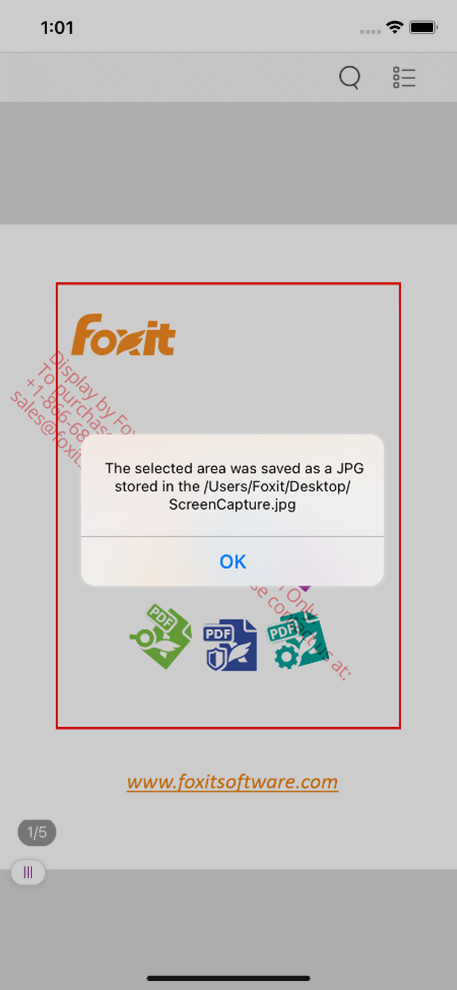
Figure 7-1
In order to verify whether the tool captures the selected area successfully, we need to find the screenshot. Go to “desktop”, we can see the image as shown in Figure 7.
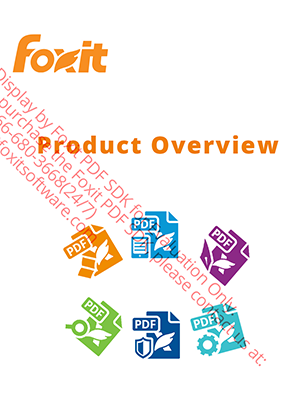
Figure 7-2
As you can see we have successfully created a Regional Screenshot Tool in Objective-C. This is just an example to show how to create a custom tool with Foxit PDF SDK for iOS. You can refer to it or our demos to develop the tools you want.
Create a Regional Screenshot Tool in Swift
For convenience, we will build this tool based on the “viewer_ctrl_demo_swift” project found in the “samples\swift” folder. Steps required for implementing this tool are as follows:
Create a class named ScreenCaptureToolHandler that implements the “IToolHandler” interface.
Handle onPageViewLongPress and onDraw events.
Instantiate a ScreenCaptureToolHandler object, and then register it to the extensions manager.
Set the ScreenCaptureToolHandler object as the current tool handler.
Step 1: Create a class named ScreenCaptureToolHandler that implements the “IToolHandler” interface.
Load the “viewer_ctrl_demo_swift” project in Xcode. Create a class named “ScreenCaptureToolHandler” in the “Source” folder.
Let the ScreenCaptureToolHandler class implement the IToolHandler interface as follows:
class ScreenCaptureToolHandler: NSObject, IToolHandler { }
Step 2: Handle onPageViewLongPress and onDraw events.
Update ScreenCaptureToolHandler.swift as follows:
import Foundation
import MobileCoreServices
import ImageIO
class ScreenCaptureToolHandler: NSObject, IToolHandler {
public var type: FSAnnotType
var extensionManager: UIExtensionsManager!
var pdfViewCtrl: FSPDFViewCtrl!
var startPoint = CGPoint()
var endPoint = CGPoint()
init(extensionsManager: UIExtensionsManager) {
self.extensionManager = extensionsManager
self.pdfViewCtrl = extensionsManager.pdfViewCtrl
self.type = FSAnnotType.annotUnknownType
super.init()
}
func getName() -> String {
return ” “
}
func isEnabled() -> Bool {
return true
}
func onActivate() {
}
func onDeactivate() {
}
// Save the image to a specified path.
func saveJPGImage(imageRef: CGImage, path: String) {
let fileURL: CFURL = NSURL.fileURL(withPath: path) as CFURL
let dr = CGImageDestinationCreateWithURL(fileURL, kUTTypeJPEG, 1, nil)!
CGImageDestinationAddImage(dr, imageRef, nil)
CGImageDestinationFinalize(dr)
}
// Handle the PageView Gesture and Touch event
func onPageViewLongPress(_ pageIndex: Int32, recognizer: UILongPressGestureRecognizer) -> Bool {
if recognizer.state == UIGestureRecognizerState.began {
startPoint = recognizer.location(in: pdfViewCtrl.getPageView(pageIndex))
endPoint = startPoint
}
else if recognizer.state == UIGestureRecognizerState.changed {
endPoint = recognizer.location(in: pdfViewCtrl.getPageView(pageIndex))
// Refresh the page view, then the onDraw event will be triggered.
pdfViewCtrl.refresh(pageIndex)
}
else if recognizer.state == UIGestureRecognizerState.ended || recognizer.state == UIGestureRecognizerState.cancelled {
// Get the size of the Rect.
let size = CGSize(width: fabs(endPoint.x – startPoint.x), height: fabs(endPoint.y – startPoint.y))
let origin = CGPoint(x: (startPoint.x < endPoint.x) ? startPoint.x : endPoint.x, y: (startPoint.y<endPoint.y) ? startPoint.y : endPoint.y)
// Get the Rect.
let rect = CGRect(origin: origin, size: size)
let newDibwidth = rect.size.width
let newDibHeight = rect.size.height
if newDibwidth < 1 || newDibHeight < 1 {
return true
}
let pageView = pdfViewCtrl.getPageView(pageIndex)
let bound = pageView.bounds
// Create a bitmap with the size of the selected area.
let imgSize = newDibwidth * newDibHeight * 4
let capacity: Int = Int(newDibwidth) * Int(newDibHeight) * 4
let buff = UnsafeMutablePointer<UInt8>.allocate(capacity: capacity)
let pBuff = NSData.init(bytes: UnsafeRawPointer(buff), length: capacity)
let pitch: Int = Int(newDibwidth) * 4
guard let fsbitmap = FSBitmap.init(width: Int32(newDibwidth), height: Int32(newDibHeight), format:FSBitmapDIBFormat.dibArgb , buffer: pBuff as Data, pitch: Int32(pitch)) else {
return false
}
fsbitmap.fillRect(0xFFFFFFFF, rect: nil)
let fsrenderer = FSRenderer.init(bitmap: fsbitmap, is_rgb_order: true)
let page = pdfViewCtrl.currentDoc?.getPage(pageIndex)
// Calculate the display matrix.
let fsmatrix = page?.getDisplayMatrix(-Int32(rect.origin.x), top: -Int32(rect.origin.y), width: Int32(bound.size.width), height: Int32(bound.size.height), rotate: FSRotation.rotation0)
// Set the render content, then start to render the selected area to the bitmap.
fsrenderer?.setRenderContentFlags(UInt32(UInt8(FSRendererContentFlag.renderPage.rawValue) | UInt8(FSRendererContentFlag.renderAnnot.rawValue)))
let progress = fsrenderer?.startRender(page, matrix: fsmatrix, pause: nil)
if ((progress) != nil) {
while (true) {
if (progress?.resume() != FSProgressiveState.toBeContinued)
{
break
}
}
}
// Convert FSBitmap to CGImage.
let releaseData: CGDataProviderReleaseDataCallback = {
(info: UnsafeMutableRawPointer?, data:UnsafeRawPointer, size:Int) -> Void in
}
let provider: CGDataProvider = CGDataProvider.init(dataInfo: nil, data: pBuff.bytes, size: Int(imgSize), releaseData: releaseData)!
let colorSpace = CGColorSpaceCreateDeviceRGB()
let bitmapInfo: CGBitmapInfo = .byteOrderMask
let image = CGImage(width: Int(newDibwidth), height: Int(newDibHeight), bitsPerComponent: 8, bitsPerPixel: 32, bytesPerRow: Int(newDibwidth) * 4, space: colorSpace, bitmapInfo: bitmapInfo, provider: provider, decode: nil, shouldInterpolate: true, intent: CGColorRenderingIntent.defaultIntent)
// Save the image to a specified path.
let jpgPath = “/Users/Foxit/Desktop/ScreenCapture.jpg”
self.saveJPGImage(imageRef: image!, path: jpgPath)
let alert = UIAlertView(title: “”, message: ” The selected area was saved as a JPG stored in the /Users/Foxit/Desktop/ScreenCapture.jpg”, delegate: nil, cancelButtonTitle: NSLocalizedString(“OK”, comment: “OK”))
alert.show()
return true
}
return true
}
// Handle the drawing event.
func onDraw(_ pageIndex: Int32, in context: CGContext) {
context.setLineWidth(CGFloat(2))
context.setLineCap(.square)
let color = UIColor.red
context.setStrokeColor(color.cgColor)
let points = [startPoint, CGPoint(x: CGFloat(endPoint.x), y: CGFloat(startPoint.y)), endPoint, CGPoint(x: CGFloat(startPoint.x), y: CGFloat(endPoint.y))]
context.addLines(between: points)
context.closePath()
context.strokePath()
}
func onPageViewTap(_ pageIndex: Int32, recognizer: UITapGestureRecognizer?) -> Bool {
return false
}
func onPageViewPan(_ pageIndex: Int32, recognizer: UIPanGestureRecognizer) -> Bool {
return false
}
func onPageViewShouldBegin(_ pageIndex: Int32, recognizer gestureRecognizer: UIGestureRecognizer) -> Bool {
return true
}
func onPageViewTouchesBegan(_ pageIndex: Int32, touches: Set<AnyHashable>, with event: UIEvent) -> Bool {
return false
}
func onPageViewTouchesMoved(_ pageIndex: Int32, touches: Set<AnyHashable>, with event: UIEvent) -> Bool {
return false
}
func onPageViewTouchesEnded(_ pageIndex: Int32, touches: Set<AnyHashable>, with event: UIEvent) -> Bool {
return false
}
func onPageViewTouchesCancelled(_ pageIndex: Int32, touches: Set<AnyHashable>, with event: UIEvent) -> Bool {
return false
}
}
Note In the above code, you should specify an existing path to save the image. Here, the path is “/Users/Foxit/Desktop/ScreenCapture.jpg”, please replace it with a valid path.
Step 3: In ViewController.swift, instantiate a ScreenCaptureToolHandler object and then register it to the UIExtensionsManager.
var screenCaptureToolHandler: ScreenCaptureToolHandler!
…
self.screenCaptureToolHandler = ScreenCaptureToolHandler.init(extensionsManager: self.extensionsManager)
self.extensionsManager.register(self.screenCaptureToolHandler)
Step 4: In ViewController.swift, set the ScreenCaptureToolHandler object as the current tool handler.
Register the Doc event listener.
class ViewController: UIViewController, UISearchBarDelegate, ISearchEventListener, IDocEventListener
…
self.pdfViewCtrl.register(self)
Set the current tool handler in the onDocOpened function:
func onDocOpened(_ document: FSPDFDoc?, error: Int32) {
self.extensionsManager.currentToolHandler = self.screenCaptureToolHandler
}
Now, we have really finished creating a custom tool in Swift. Then, build and run the demo. After building the demo successfully, long press and select a rectangular area, and then a message box will be popped up (refer to Figure 7). Go to “desktop”, we will see the screenshot (refer to Figure 7).
This is just an example to show how to create a custom tool in Swift with Foxit PDF SDK for iOS. You can refer to it or our demos to develop the tools you want.
Implement Foxit PDF SDK for iOS using Cordova
When it comes to developing cross-platform mobile applications, Apache Cordova is an ideal open-source framework. The ‘cordova-plugin-foxitpdf‘ is one of the mobile framework plugins provided by us to use with Foxit PDF SDK for iOS. The plugin enables you to achieve powerful PDF viewing features using the Cordova framework. Through this plugin, you can preview any PDF file including PDF 2.0 compliant files, XFA documents, and RMS protected documents, as well as commenting and editing PDF documents.
For the usage of ‘cordova-plugin-foxitpdf’ plugin, please refer to the website https://github.com/foxitsoftware/cordova-plugin-foxitpdf.
Implement Foxit PDF SDK for iOS using React Native
React Native is an open-source mobile development framework for building native apps using JavaScript and React. The ‘react-native-foxitpdf‘ is only one of the mobile framework plugins provided by us to use with Foxit PDF SDK for iOS. It allows you to achieve powerful PDF viewing features using the React Native framework. Through this plugin, you can preview any PDF file including PDF 2.0 compliant files, XFA documents, and RMS protected documents, as well as commenting and editing PDF documents.
For the usage of ‘react-native-foxitpdf’ plugin, please refer to the website https://github.com/foxitsoftware/react-native-foxitpdf.
Implement Foxit PDF SDK for iOS using Xamarin
Xamarin is a cross-platform development framework for building native apps using a shared C# codebase. We provide separate bindings for Android and iOS (‘foxit_xamarin_android’ and ‘foxit_xamarin_ios’) for developers to seamlessly integrate powerful PDF functionality of Foxit PDF SDK into their Xamarin apps.
For the usage of ‘foxit_xamarin_ios’ plugin, please refer to the website https://github.com/foxitsoftware/xamarin-foxitpdf.
FAQ
Bitcode Support
What is Bitcode? Does Foxit PDF SDK for iOS support Bitcode?
Bitcode is an intermediate representation of a compiled binary. Including bitcode will allow Apple to re-optimize your app binary in the future without the need to submit a new version of your app to the store.
Yes. Foxit PDF SDK for iOS supports Bitcode since version 3.0.
Open a PDF document from a specified PDF file path
How do I open a PDF document from a specified PDF file path?
Foxit PDF SDK for iOS provides multiple interfaces to open a PDF document. You can open a PDF document from a specified PDF file path, or from a memory buffer. For from a specified PDF file path, there are two ways to do that.
The first one is that just use the openDoc interface, which includes the operations of creating a PDF document object (initWithPath ), loading the document content (load), and setting the PDF document object to view control (setDoc). Following is the sample code:
Note: The openDoc interface is only available for opening a PDF document from a file path. If you want to customize to load a PDF document, you can implement it in the callback function (FSFileReadCallback), and then create a document object with a FireRead instance using initWithHandler. Next, also load the document content using load, and set the PDF document object to view control using setDoc.
#import “ViewController.h”
#import <FoxitRDK/FSPDFViewControl.h>
@interface ViewController : UIViewController
@end
@implementation ViewController
{
FSPDFViewCtrl* pdfViewCtrl;
}
– (void)viewDidLoad {
[super viewDidLoad];
// Get the path of a PDF.
NSString* pdfPath = [[NSBundle mainBundle] pathForResource:@”Sample” ofType:@”pdf”];
// Initilize a FSPDFViewCtrl object with the size of the entire screen.
pdfViewCtrl = [[FSPDFViewCtrl alloc] initWithFrame: [self.view bounds]];
// Open an unencrypted PDF document from a specified PDF file path.
[pdfViewCtrl openDoc:pdfPath password:nil completion:nil];
// Add the pdfView to the root view.
[self.view addSubview:pdfViewCtrl];
}
@end
The second one is that use the initWithPath interface to create a PDF document object, use load interface to load the document content, and then use setDoc to set the PDF document object to view control. Following is the sample code:
#import “ViewController.h”
#import <FoxitRDK/FSPDFViewControl.h>
@interface ViewController : UIViewController
@end
@implementation ViewController
{
FSPDFViewCtrl* pdfViewCtrl;
}
– (void)viewDidLoad {
[super viewDidLoad];
// Get the path of a PDF.
NSString* pdfPath = [[NSBundle mainBundle] pathForResource:@”Sample” ofType:@”pdf”];
// Initialize a PDFDoc object with the path to the PDF file.
FSPDFDoc* pdfdoc = [[FSPDFDoc alloc] initWithPath: pdfPath];
// Load the unencrypted document content.
if(FSErrSuccess != [pdfdoc load:nil]) {
return;
}
// Initilize a FSPDFViewCtrl object with the size of the entire screen.
pdfViewCtrl = [[FSPDFViewCtrl alloc] initWithFrame: [self.view bounds]];
// Set the document to view control.
[pdfViewCtrl setDoc:pdfdoc];
// Add the pdfView to the root view.
[self.view addSubview:pdfViewCtrl];
}
@end
Display a specified page when opening a PDF document
What should I do if I want to display a specified page when opening a PDF document?
To display a specified page when opening a PDF file, the interface [pdfViewCtrl gotoPage: (int) animated: (BOOL)] should be used. Foxit PDF SDK for iOS utilizes multi-thread to improve rendering speed, so please make sure the document has been loaded successfully before using the gotoPage interface. There are two ways to realize the feature as follows:
The first one is that making a conditional statement in the openDoc interface to ensure that only when the document loading is complete, then call the gotoPage. If not, the gotoPage interface will not work, and the first page will be displayed. It is because the openDoc interface starts a new thread to perform the operation. Following is the sample code:
#import “ViewController.h”
#import <FoxitRDK/FSPDFViewControl.h>
@interface ViewController : UIViewController
@end
@implementation ViewController
{
FSPDFViewCtrl* pdfViewCtrl;
}
– (void)viewDidLoad {
[super viewDidLoad];
// Get the path of a PDF.
NSString* pdfPath = [[NSBundle mainBundle] pathForResource:@”Sample” ofType:@”pdf”];
// Initilize a FSPDFViewCtrl object with the size of the entire screen.
pdfViewCtrl = [[FSPDFViewCtrl alloc] initWithFrame: [self.view bounds]];
// Open an unencrypted PDF document from a specified PDF file path, and go to the third page when completing the document loading.
[pdfViewCtrl openDoc:pdfPath password:nil completion:^(enum FSErrorCode error){
if(error == FSErrSuccess)
// Display the third page.
[pdfViewCtrl gotoPage:2 animated:NO];
}];
// Add the pdfView to the root view.
[self.view addSubview:pdfViewCtrl];
}
@end
The second one is that implement the <IDocEventListener> protocol, and then call the gotoPage interface in the onDocOpened event. Following is the sample code:
#import “ViewController.h”
#import <FoxitRDK/FSPDFViewControl.h>
@interface ViewController : UIViewController <IDocEventListener>
@end
@implementation ViewController
{
FSPDFViewCtrl* pdfViewCtrl;
}
– (void)viewDidLoad {
[super viewDidLoad];
// Get the path of a PDF
NSString* pdfPath = [[NSBundle mainBundle] pathForResource:@”Sample” ofType:@”pdf”];
// Initilize a FSPDFViewCtrl object with the size of the entire screen.
pdfViewCtrl = [[FSPDFViewCtrl alloc] initWithFrame: [self.view bounds]];
// Register the PDF document event listener.
[pdfViewCtrl registerDocEventListener:self];
// Open an unencrypted PDF document from a specified PDF file path.
[pdfViewCtrl openDoc:pdfPath password:nil completion:nil];
// Add the pdfView to the root view.
[self.view addSubview:pdfViewCtrl];
}
#pragma IDocEventListener
-(void)onDocOpened:(FSPDFDoc *)document error:(int)error
{
// display the third page.
[pdfViewCtrl gotoPage:2 animated:NO];
}
@end
License key and serial number cannot work
I have downloaded the SDK package from your website without making any changes. Why can’t the license key and serial number work?
Generally, the package uploaded to the website is supposed to work. It has been tested before it is uploaded. So, if you find the license key and serial number cannot work, it may be caused by the date of your device. If the device’s date is earlier than the StartDate in the rdk_key.txt file found in the “libs” folder of the download package, the “librdk.so” library will be failed to unlock. Please check the date of your device.
Add a link annotation to a PDF file
How can I add a link annotation to a PDF file?
To add a link annotation to a PDF file, you should first call the – [FSPDFPage addAnnot:rect:] to add an annotation to a specified page, then call + [FSAction create:action_type:] to create an action, and set the action to the added link annotation. Following is the sample code for adding a URI link annotation to the first page of a PDF file:
#define DOCUMENT_PATH [NSSearchPathForDirectoriesInDomains(NSDocumentDirectory, NSUserDomainMask, YES) objectAtIndex:0]
…
// Get the path of a PDF
NSString* pdfPath = [[NSBundle mainBundle] pathForResource:@”Sample” ofType:@”pdf”];
// Initialize a PDFDoc object with the path to the PDF file.
FSPDFDoc *document = [[FSPDFDoc alloc] initWithPath: pdfPath];
// load the unencrypted document content.
[document load:nil];
// Get the first page of the PDF file.
FSPDFPage *page = [document getPage:0];
// Add a link annotation to the first page.
FSRectF *rect = [[FSRectF alloc] initWithLeft1:250 bottom1:650 right1:450 top1:750];
FSLink *linkAnnot = [[FSLink alloc] initWithAnnot:[page addAnnot: FSAnnotLink rect:rect]];
// Create a URI action and set the URI.
FSURIAction *uriAction = [[FSURIAction alloc] initWithAction:[FSAction create:document action_type:FSActionTypeURI]];
[uriAction setURI:@”https://www.foxitsoftware.com”];
// Set the action to link annotation.
[linkAnnot setAction:uriAction];
// Reset appearance stream.
[linkAnnot resetAppearanceStream];
// Save the document that has added the link annotaiton.
[document saveAs:[DOCUMENT_PATH stringByAppendingString:@”Sample_annot.pdf”] save_flags:FSPDFDocSaveFlagNormal];
Insert an image into a PDF file
How do I insert an image into a PDF file?
To insert an image into a PDF file, you can call – [FSPDFPage addImageFromFilePath:position:width:height:auto_generate_content:] interface. Following is the sample code for inserting an image into the first page of a PDF file:
Note: Before calling – [FSPDFPage addImageFromFilePath:position:width:height:auto_generate_content:]
interface, you should get and parse the page that you want to add the image.
#define DOCUMENT_PATH [NSSearchPathForDirectoriesInDomains(NSDocumentDirectory, NSUserDomainMask, YES) objectAtIndex:0]
…
// Get the path of a PDF.
NSString* pdfPath = [[NSBundle mainBundle] pathForResource:@”Sample” ofType:@”pdf”];
// Initialize a PDFDoc object with the path to the PDF file.
FSPDFDoc *document = [[FSPDFDoc alloc] initWithPath: pdfPath];
// load the unencrypted document content.
[document load:nil];
// Get the first page of the PDF file.
FSPDFPage *page = [document getPage:0];
// Parse the page.
if (![page isParsed]) {
FSProgressive* progressive = [page startParse: FSPDFPageParsePageNormal pause:nil is_reparse:NO];
while ([progressive resume] == FSProgressiveToBeContinued) {
continue;
}
}
// Get the image path.
NSString* imagePath = @”/Users/xiaole/Desktop/1.png”;
// Add an image to the first page.
FSPointF* point = [[FSPointF alloc] init];
[point set:100 y:300];
[page addImageFromFilePath:imagePath position:point width:100 height:120 auto_generate_content:YES];
// Save the document that has added the link annotaiton.
[document saveAs:[DOCUMENT_PATH stringByAppendingString:@”Sample_image.pdf”] save_flags:FSPDFDocSaveFlagNormal];
Highlight the links in PDF documents and set the highlight color
How can I set whether to highlight the links in PDF documents? And how to set the highlight color if I want to highlight links?
By default, highlighting links in PDF documents is enabled. If you want to disable it or to set the highlight color, you can do it in the configuration JSON file (only support for version 6.3 or higher) or by calling the APIs.
Note: If you want to set the highlight color, please make sure the highlighting links feature is enabled.
Through JSON file
Set “”highlightLink”: false,” to disable highlighting the links in PDF document.
Set “”highlightLinkColor”: “#16007000″,” to set the highlight color (input the color value as you wish).
Through calling API
UIExtensionsManager.enableHighlightLinks property is provided to set whether to enable highlighting the links in PDF documents. If you do not want to highlight links, please set the parameter to “false” as follows:
// Assume you have already Initialized a UIExtensionsManager object
extensionsManager.enableHighlightLinks = false;
UIExtensionsManager.linksHighlightColor property is used to set the highlight color. Following is a sample for setting this property:
// Assume you have already Initialized a UIExtensionsManager object
extensionsManager.linksHighlightColor = [UIColor colorWithRed:0 green:0 blue:1 alpha:0.3];
Highlight the form fields in PDF form files and set the highlight color
How can I set whether to highlight the form fields in PDF form files? And how to set the highlight color if I want to highlight form fields?
By default, highlighting form fields in PDF documents is enabled. If you want to set the highlight color, please make sure you have not disabled the highlighting form fields feature.
From version 6.3, you can disable/enable highlighting form fields or set the highlight color easily in the configuration JSON file, just set the following two items:
“highlightForm”: true,
“highlightFormColor”: “#200033cc”,
For the version before 6.3, if you want to disable/enable highlighting form fields or set the highlight color, you should modify the source code of the UI Extensions Component using – [FSFiller highlightFormFields:] and – [FSFiller setHighlightColor:] interfaces.
– [FSFiller highlightFormFields:] interface is provided to set whether to enable highlighting the form fields in PDF form files. Please refer to section 4.3 “Customize UI implementation through source code” to add the “uiextensions” project found in the “libs/uiextensions_src” folder to your project. Then, find the onDocOpened function in “UIExtensions/Form/FormAnnotHandler.m”, and set the parameter of – [FSFiller highlightFormFields:] to “false” as follows:
– (void)onDocOpened:(FSPDFDoc* )document error:(int)error
{
…
…
[_formFiller highlightFormFields:false];
}
– [FSFiller setHighlightColor:] interface is used to set the highlight color. Following is a sample for calling this API:
– (void)onDocOpened:(FSPDFDoc* )document error:(int)error
{
…
…
[_formFiller highlightFormFields:ture];
[_formFiller setHighlightColor:0x4b00ff00];
}
Indexed Full Text Search support
Does Foxit PDF SDK support Indexed Full Text Search? If yes, how can I use it to search through PDF files stored offline on my mobile device?
Yes. Foxit PDF SDK for iOS supports Indexed Full Text Search.
To use this feature, follows the steps below:
Get document source information. Create a document source based on a directory which will be used as the search directory.
-(id)initWithDirectory: (NSString *)directory;
Create a full text search object, and set a path of database to store the indexed data.
-(id)init;
-(void)setDataBasePath:(NSString *)path_of_data_base;
Start to index the PDF documents which receive from the source.
-(FSProgressive*)startUpdateIndex: (FSDocumentsSource*)source pause: (id<FSPauseCallback>)pause reUpdate:(BOOL)reUpdate;
Note: You can index a specified PDF file. For example, if the contents of a PDF file have been changed, you can re-index it using the following API:
-(BOOL)updateIndexWithFilePath: (NSString *)file_path;
Search the specified keyword from the indexed data source. The search results will be returned to external by a specified callback function when a matched one is found.
-(BOOL)searchOf: (NSString *)match_string rank_mode:(FSFullTextSearchRankMode)rank_mode callback: (id<FSSearchCallback>)Callback;
Following is a sample for how to use it:
– (void)FullTextSearch {
NSString *directory = @”INPUT_DIRECTORY”;
FSDocumentsSource* docs = [[FSDocumentsSource alloc] initWithDirectory:directory];
FSFullTextSearch* fulltextSearch = [FSFullTextSearch init];
NSString* dbPath = @”The path of data base to store the indexed data…”;
[fulltextSearch setDataBasePath:dbPath];
FSProgressive* progressive = [fulltextSearch startUpdateIndex:docs pause:nil reUpdate:NO];
if (progressive) {
while (true) {
if ([progressive resume] != FSProgressiveToBeContinued) {
break;
}
}
}
[fulltextSearch searchOf:@”Foxit” RankMode:FSFullTextSearchRankNone callback:[[FSSearchCallbackImp alloc] init]];
}
@end
A sample callback function is as follows:
@interface FSSearchCallbackImp: NSObject<FSSearchCallback>
@end
@implementation FSSearchCallbackImp
-(int)retrieveSearchResult:(NSString*)file_path page_index:(int)page_index match_result:(NSString*)match_result match_start_text_index:(int)match_start_text_index match_end_text_index:(int)match_end_text_index
{
NSLog (@”file_path: %@\n”, file_path);
NSLog (@”page_index: %i, match_start_text_index: %i, match_end_text_index: %i\n”, page_index, match_start_text_index, match_end_text_index);
NSLog (@”match_result: %@\n\n”, match_result);
return 0;
}
@end
Note:
The indexed full text search provided by Foxit PDF SDK for iOS will go through a directory recursively, so that both the files and the folders under the search directory will be indexed.
If you want to abort the index process, you can pass in a pause callback parameter to the startUpdateIndex interface. The callback function NeedPauseNow will be invoked once a PDF document is indexed, so that the caller can abort the index process when the callback NeedPauseNow return “true”.
The location of the indexed database is set by setDataBasePath interface. If you want to clear the indexed database, you shoud do it manually. And now, removing a file from index function is not supported.
Every search result of the searchOf interface is returned to external by a specified callback. Once the searchOf interface returns “true” or “false”, it means the searching is finished.
Print PDF document
Does Foxit PDF SDK for iOS support to print a PDF document? If yes, how can I use it?
Yes. Foxit PDF SDK for iOS supports the print feature from version 5.1. You can press the Wireless Print button on the More Menu view in the Complete PDF viewer demo to print the PDF document. Furthermore, you can call the following two APIs to print the PDF documents:
// for iPhone and iTouch
(void)printDoc:(FSPDFDoc *)doc animated:(BOOL)animated jobName:(nullable NSString *)jobName delegate:(nullable id<UIPrintInteractionControllerDelegate>)delegate completionHandler:(nullable UIPrintInteractionCompletionHandler)completion;
// for iPad
(void)printDoc:(FSPDFDoc *)doc fromRect:(CGRect)rect inView:(UIView *)view animated:(BOOL)animated jobName:(nullable NSString *)jobName delegate:(nullable id<UIPrintInteractionControllerDelegate>)delegate completionHandler:(nullable UIPrintInteractionCompletionHandler)completion;
Following is a sample for how to use it:
UIPrintInteractionCompletionHandler completion = ^(UIPrintInteractionController *_Nonnull printInteractionController, BOOL completed, NSError *_Nullable error) {
if (error) {
UIAlertAction* action = [UIAlertAction actionWithTitle:[@”Warning:” stringByAppendingString:error.localizedDescription] style:UIAlertActionStyleDefault handler:nil];
UIAlertController* controller = [[UIAlertController alloc] init];
[controller addAction:action];
[self showViewController:controller sender:nil];
}
};
NSString *fileName = @”xxx.pdf”;
FSPDFDoc* doc = [[FSPDFDoc alloc] initWithPath:fileName];
[UIExtensionsManager printDoc: doc animated:YES jobName:fileName delegate:nil completionHandler:completion];
Night mode color settings
How can I set the night mode color?
if you want to set the night mode color, please first set the properties FSPDFViewCtrl.mappingModeBackgroundColor and FSPDFViewCtrl.mappingModeForegroundColor, and then set the FSPDFViewCtrl.colorMode to FSRendererColorModeMapping.
Note: If the FSPDFViewCtrl.colorMode has already been set to FSRendererColorModeMapping, you still need to set it again after updating the FSPDFViewCtrl.mappingModeBackgroundColor and FSPDFViewCtrl.mappingModeForegroundColor. Otherwise, the settings may not work.
The properties should be changed in the source code of the UI Extensions Component, please refer to section 5.3 “Customize UI implementation through source code” to add the “uiextensions” project found in the “libs/uiextensions_src” folder to your project. Then, find the settingBar function in “UIExtensions/UIExtensionsManager.m”, and set the color as you like.
Following is a sample to set the night mode color:
– (void)settingBar:(FSSettingBar *)settingBar isNightMode:(BOOL)isNightMode {
self.settingBar.viewSettingManager.isDayOrNightForLast = YES;
if ([self.pdfViewCtrl getPageLayoutMode] == PDF_LAYOUT_MODE_REFLOW) {
UIColor* color = isNightMode ? UIColor.blackColor : UIColor.whiteColor;
[self.pdfViewCtrl setReflowBackgroundColor:color];
[self.pdfViewCtrl setPageLayoutMode:PDF_LAYOUT_MODE_REFLOW];
self.pdfViewCtrl.isNightMode = isNightMode;
}else{
if (!(self.pdfViewCtrl.isNightMode == isNightMode && self.pdfViewCtrl.colorMode != FSRendererColorModeMappingGray)) {
self.pdfViewCtrl.isNightMode = isNightMode;
if (self.pdfViewCtrl.nightColorMode == FSNightColorModeMappingGray && isNightMode) {
self.pdfViewCtrl.colorMode = FSRendererColorModeMappingGray;
}
if (isNightMode && self.pdfViewCtrl.nightColorMode != FSNightColorModeMappingGray)
{
// Set background color.
self.pdfViewCtrl.mappingModeBackgroundColor = [UIColor redColor];
// Set foreground color.
self.pdfViewCtrl.mappingModeForegroundColor = [UIColor greenColor];
// Set color mode.
self.pdfViewCtrl.colorMode = FSRendererColorModeMapping;
// Set the background color for the areas that are out of the pdfviewctrl.
self.pdfViewCtrl.backgroundColor = [UIColor colorWithRed:20.0/255.0 green:20.0/255.0 blue:20.0/255.0 alpha:1.0];
}
else {
self.pdfViewCtrl.colorMode = FSRendererColorModeNormal;
self.pdfViewCtrl.backgroundColor = [UIColor colorWithRed:230.0/255.0 green:230.0/255.0 blue:230.0/255.0 alpha:1.0];
}
}
}
}
Upload Foxit SDK Framework to Apple App Store
Why do I meet “Invalid Binary Architecture” warning and “Code signing “FoxitRDK.framework” failed” error when I uploaded my app embedded your SDK Framework to Apple App Store?
Foxit SDK Framwork includes arm64, armv7, i386, and x86_64 architectures, but the i386, and x86_64 architectures are not allowed to be uploaded to Apple App Store so that you will meet the “Invalid Binary Architecture” warning and “Code signing “FoxitRDK.framework” failed” error if you use the framework directly.
To solve this problem, Foxit SDK provides a script named “prepare-framework-to-publish-to-appstore.sh” found in the “libs” folder to strip the arm architectures, and then output the library to the directory “./device/FoxitRDK.framework”. You should use this library in your project and then you can publish your app to Apple App Store.
Output exception/crash log information
How can I output exception/crash log information when my app throws exceptions or crashes?
If you want to output exception/crash log information, all you need is to implement the <IExceptionLogger> protocol, and then call the interface + [FSPDFViewCtrl setExceptionLogger:].
Localization settings
How to change Localization settings with Foxit PDF SDK for iOS?
By default, Foxit PDF SDK for iOS will automatically switch the UI language according to the current language of your system, provided that the language is supported by Foxit PDF SDK for iOS.
Currently, Foxit PDF SDK for iOS supports the following languages: English, Korean, and Chinese (Simplified, Traditional). Those language resource files are located in the “libs\uiextensions_src\UIExtensions\Resource\FoxitLocalizable” folder.
If you want to use your own localization language that is not supported by Foxit PDF SDK for iOS:
For version 6.4, you can refer to the article https://developers.foxitsoftware.com/kb/article/change-localization-settings-pdf-sdk-ios/ to change the localization settings, which needs to modify the localization settings in the UIExtensions Component.
From version 7.0 or higher, you can do it directly in your project. First, add a language to your project, and translate all the entries to the language you wish. Then, call + [FSLocalization addLanguage:table:languageAbbr:] to add the new created language that you want to support. Last, to make it work, you can change your current system language, or call + [FSLocalization setCurrentLanguage:FSLocalizationLanguageOptionalEnglish] to set current language.
Update page binding to support Right-to-Left
How can I automatically update page binding to support Right-to-Left?
For most languages, the reading habits we use are left-to-right, which calls for a page binding on the left edge. However, there are also some languages that read from right to left, such as Arabic and Hebrew and several East Asian scripts. In this case, binding on the right edge is preferable for users, which the pages will be arranged from right to left (the first page is on the top right). To do this, we made the adaptation of the right-to-left page layout.
The page binding is used with horizontal scrolling. For vertical scrolling, it has effect only when double-page mode is enabled.
Updating the Page Binding Programmatically
Foxit PDF SDK for iOS defines an enumeration in the FSPDFViewCtrl class to infer how a document should be presented to the user. The possible values are:
PDF_PAGE_BINDING_LEFT_EDGE: the document flows from left to right
PDF_PAGE_BINDING_RIGHT_EDGE: the document flows from right to left
PDF_PAGE_BINDING_UNKNOWN: the document doesn’t explicitly define a page binding, so the behavior may be the same as it is with PDF_PAGE_BINDING_LEFT_EDGE
/**
* @brief Enumeration for page binding edge.
*
* @details Values of this enumeration should be used alone.
*/
typedef enum {
/** The document doesn’t explicitly define a page binding, so the behavior is the same as it is with LEFT_EDGE or RIGHT_EDGE.*/
PDF_PAGE_BINDING_UNKNOWN = 0,
/** The document flows from left to right.*/
PDF_PAGE_BINDING_LEFT_EDGE = 1,
/** The document flows from right to left.*/
PDF_PAGE_BINDING_RIGHT_EDGE = 2,
} PDF_PAGE_BINDING_EDGE;
Then, call the following function to update the page binding to swith the page layout:
[pdfViewerCtrl setPageBindingEdge:PDF_PAGE_BINDING_RIGHT_EDGE];
The UI result after using this function:
In horizontal scrolling: (LTR: left-to-right; RTL: right-to-left)

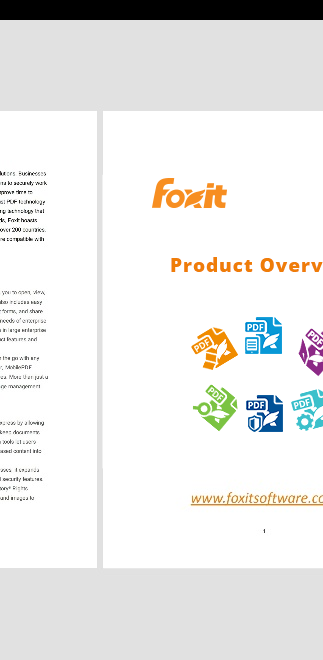
LTR RTL
In vertical scrolling: (has effect in double-page mode (Facing/Coving)):
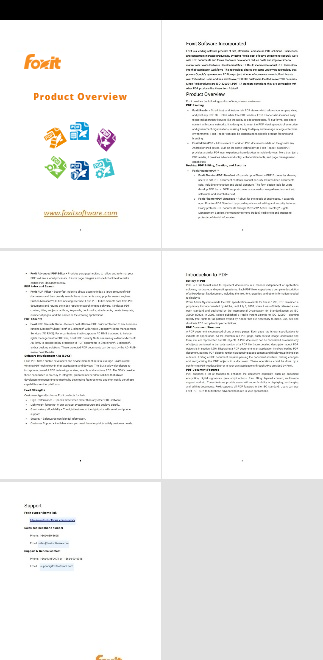
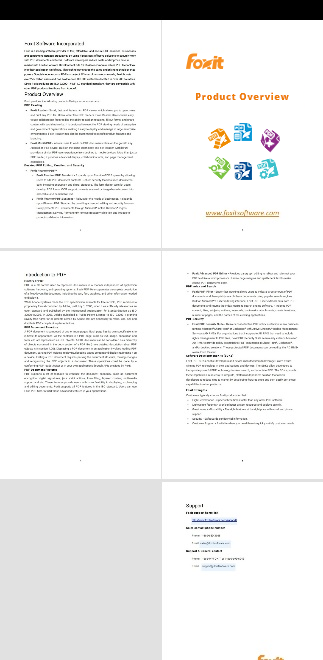
LTR RTL
Updating the Page Binding via the UI
You can create a demo using uiextensionsDynamic.framework or use complete_pdf_viewer demo directly to update the page binding. After running the demo, find the View settings bar, you can enable or disable the Right to Letf as below:
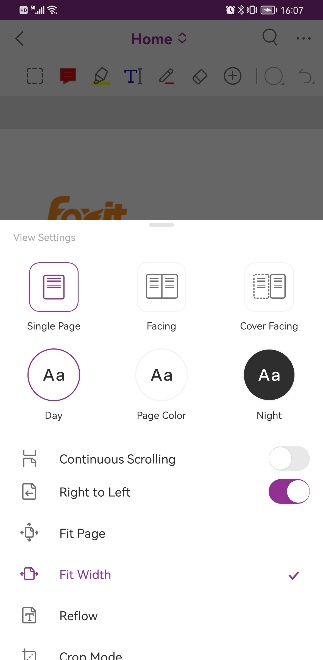
Issue with opening web PDFs
How can I resolve the issue that some documents may not display correctly or cannot be displayed at all when opening web PDFs using –[FSPDFViewCtrl openDocFromURL:password: cacheOption: httpRequestProperties: completion:] interface?
The issue occurs when some documents with numerous objects are closed before they finish loading, resulting in an incomplete caching process. When attempting to load the data, there is no current method to determine the data’s validity, only whether it has been cached.
To resolve this issue, it is recommended for users to clear cache data and reload the document using the following method. This approach should not impact document opening speed, as the SDK internally loads web pages based on page numbers.
/**
* @brief Clear the cache file.
* @param url It should be a remote path.
*
*/
-(void)clearCacheFile:(NSString *)url;
/**
* @brief Clear all files cached by SDK.
*/
-(void)clearAllCacheFile;
Implement UIScrollViewDelegate events
How can I implement the events of UIScrollViewDelegate?
If you want to implement some UIScrollViewDelegate events, you can refer to our IScrollViewEventListener interface. You can use this interface to do some things, such as monitoring the states for “canceling page turn” and “zooming” when swiping to turn page and zooming in/out PDF page.
For example, to monitor the “canceling page turn” state, you can refer to the following code:
First, register a callback as follows:
[self.pdfViewControl registerDocEventListener:self];
Then, by making judgments, you can monitor whether the page turn is canceled:
@property (nonatomic, assign) int turnPageIndex;
@property (nonatomic, strong) UIViewController *scrollView;
…
– (void)onScrollViewWillBeginDragging:(UIScrollView *)scrollView{
if (scrollView == [self.pdfViewControl getPageContainer]){
self.turnPageIndex = [self.pdfViewControl getCurrentPage];
NSLog(@”Will turn page %d”,self.turnPageIndex);
}
}
– (void)onScrollViewDidEndDecelerating:(UIScrollView *)scrollView{
if (scrollView == [self.pdfViewControl getPageContainer]){
int pageIndex = [self.pdfViewControl getCurrentPage];
if (self.turnPageIndex == pageIndex){
NSLog(@”Cancel page turn %d”,self.turnPageIndex);
}
}
}
Improve efficiency in inserting and rendering watermarks
How can I improve efficiency in inserting and rendering watermarks?
Some customers encounter issues such as delays and incomplete watermark display, when adding a custom watermark to their product. In this case, you can refer to the following method:
// Once a watermark is created, it can be reused multiple times, preventing the necessity for repeated creations and circumventing any efficiency problems.
if (!self.watermark) {
FSWatermarkSettings *settings = [[FSWatermarkSettings alloc] initWithPosition:FSPosCenter offset_x:0 offset_y:0 flags:0 scale_x:1 scale_y:1 rotation:FSPosTopCenter opacity:1];
settings.flags = FSWatermarkSettingsFlagOnTop;
FSWatermarkTextProperties *textProperties = [[FSWatermarkTextProperties alloc] initWithFont:[[FSFont alloc] initWithFont_id:FSFontStdIDTimesB] font_size:30.f color:0xA4A4A4 style:FSWatermarkTextPropertiesFontStyleNormal line_space:1 alignment:FSAlignmentCenter];
self.watermark = [[FSWatermark alloc] initWithDocument:[self.pdfViewControl getDoc] text:@”我是水印” properties:textProperties settings:settings];
}
FSPDFPage *page = [[self.pdfViewControl getDoc] getPage:index];
if (!page.isParsed) {
[page startParse];
}
// Determine whether the watermark has been loaded on the current page to avoid loading duplicate watermarks
if (!page.hasWatermark) {
[self.watermark insertToPage:page];
[self.pdfViewControl refresh:index];
}
Technical Support
Foxit Support
In order to provide you with a more personalized support for a resolution, please log in to your Foxit account and submit a ticket so that we can collect details about your issue. We will work to get your problem solved as quickly as we can once your ticket is routed to our support team.
You can also check out our Support Center, choose Foxit PDF SDK which also has a lot of helpful articles that may help with solving your issue.
Phone Support
Phone: 1-866-MYFOXIT or 1-866-693-6948
Updated on March 13, 2024